There’s arguably no product I’ve *ever* reviewed in over a decade doing this that has me as conflicted as the Whoop strap. It’s both fascinating and perplexing at the same time. It’s got enormous potential, and after four months of 24×7 usage, I’ve got a pretty darn good handle on what works exceptionally well, and what needs an exceptional amount of work.
At its core, the Whoop band/platform is an optical HR strap that does 24×7 monitoring and, in conjunction with the app, measures two core things: Recovery (via your sleep), and load (via your workouts/daily activity). It doesn’t show the time, it doesn’t track your steps, and it doesn’t make you a coffee. But it can track a tremendous number of other things via its daily manual entry journal. Everything from whether you spent the night on a redeye flight, to whether you took an ice bath – or even whether you did the horizontal shuffle (or a solo variant of that).
The overarching purpose of the Whoop platform is to tell athletes whether they need to take it easy (to improve recovery) or go harder (to increase strain). That’s it. It’s singular in its purpose. And like all single-tasker things, the bar for success is higher. When you only do one thing you have to do it really damn well. Else, nothing else matters. And that…that’s where the confliction with my usage of this device comes in.
Let’s get started. Oh – and yes, I bought this myself last summer. Since then I have been paying the usual required $30/month subscription since then – albeit I only started using it back earlier this year. Note, you *have* to commit to 6 months. So in effect, the device is $180 as a baseline, or $360 per year if you’re not quite sure you want to commit to it (if you do commit to a full year upfront, then it’s $288). Euro pricing is 25EUR/month and extrapolated with the same same 12-month/18-month savings.
Got all that? Good, let’s get rollin’.
What’s in the box:
Once you’ve got the box unzipped, you’ll find the band with Whoop pod attached, the charging pod (plus micro-USB charging cable), and a carrying bag you’ll never use
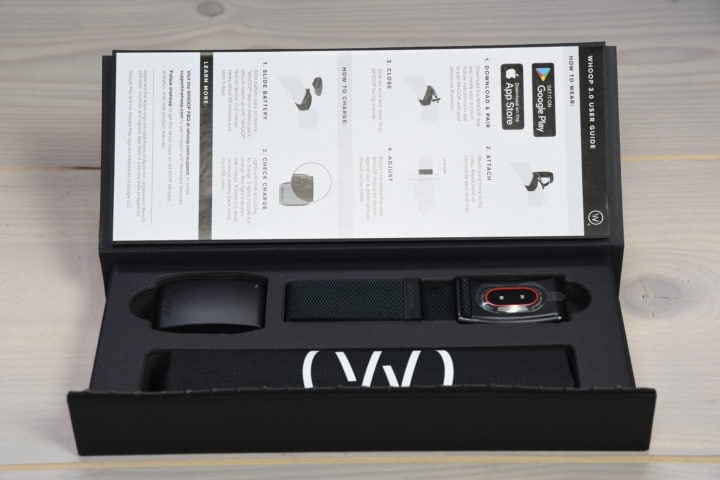
Here’s all the items out on a table, with the included bag/pouch in the upper left corner.
Seriously, I don’t understand why they included a bag for a device meant to be worn 24×7. Whoop went to the trouble of designing the battery charging pod such that you *never* have to take the Whoop off your wrist to charge it (sans-cables). Why on earth would I need a travel bag for it?
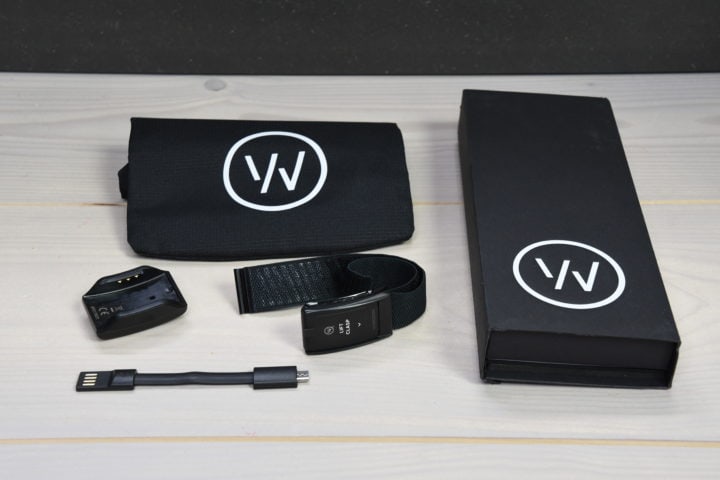
Here’s a closer look at the charging pod and very short micro-USB charging cable. Every once in a while I see one of these types of cables that are flat on the end so that you think you can insert it either direction. You can’t. It’s just annoying. Good news: Just swap it out for any standard micro-USB cable. You have 300 of them around your house.
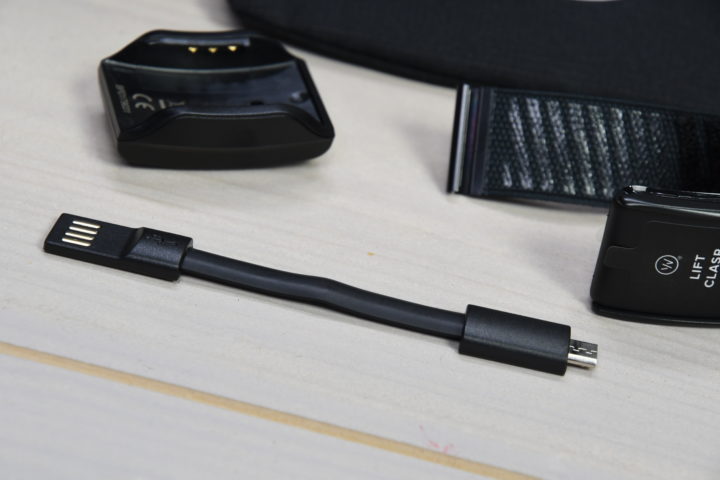
The Whoop pod slides into the battery pack/charger, which we’ll dive into in the basics section.
Next, here’s the pod:
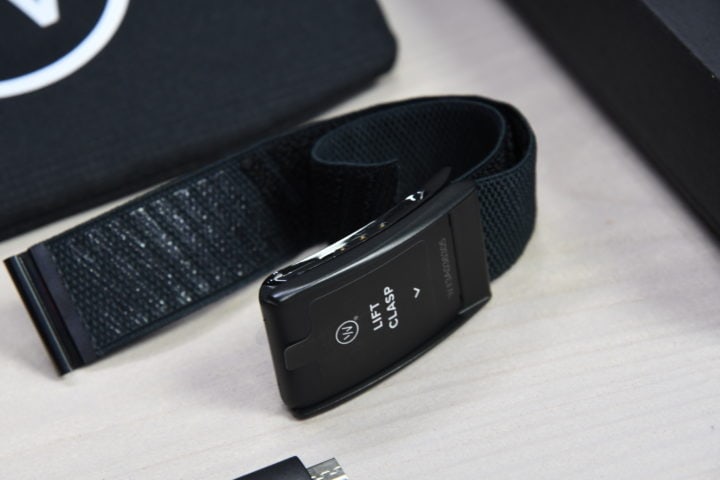
Now, in addition to the base Whoop band, you can also buy (separately) the bicep band. The idea here being to potentially increase accuracy by moving the pod to your bicep for workouts. After seeing accuracy issues early on I went and bought this added band:
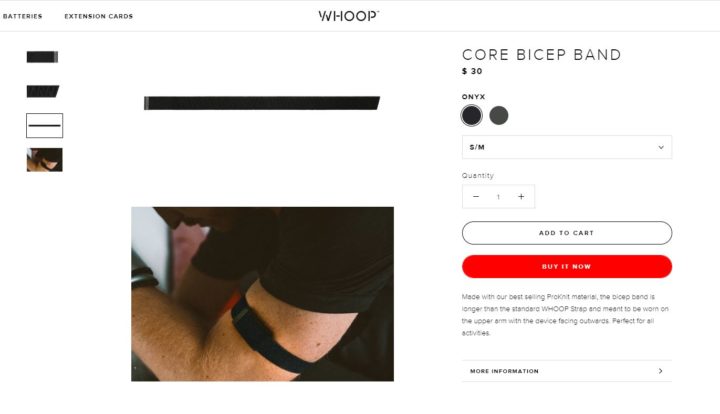
And while it might help for people with bigger biceps, what they don’t tell you is that it’s simply a longer regular strap. That’s notable because what I eventually realized is that it was far less work to simply use the existing strap and loosen it just enough to fit around my bicep. Given I’m more of a runner/cyclist, my biceps aren’t too big – so I can get away with this (in case you’re wondering, I’ve tried it in numerous spots, inside of arm, outside of arm, on upper forearm, on both sides, etc…):
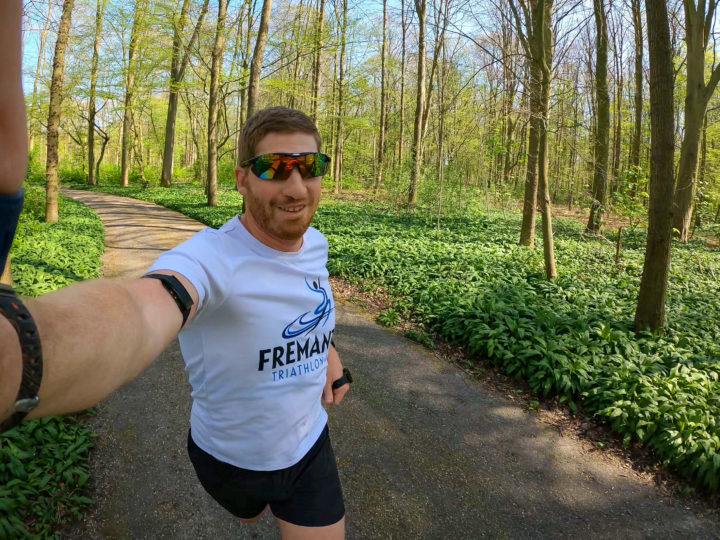
I point that out because if the original strap is big enough to fit around your arm, it’s a ton easier to use than the super finicky process of removing the strap and re-doing it every time you work-out.
Ok, with that, onto the basics.
The Basics:
Before we start talking numbers like Matt Damon in Good Will Hunting, we should talk hardware. And that part is relatively easy. The Whoop strap is simply a band with an optical heart rate (HR) sensor on the bottom of it. There’s no display, no GPS, no dedicated buttons (though, it can recognize being tapped for pairing purposes). Think of it as a piece of jewelry more than a normal watch/wearable.
It should be worn about two fingers from your wrist, or basically, away (and not atop) your wrist bone. Normal stuff for optical HR sensors. Whoop also recommends you wear it on your non-dominant wrist, but honestly, that’s an unrealistic request. Most people are still wearing a watch, and most people tend to wear a watch on their non-dominant wrist (in my case, left wrist). Plus, no other optical HR sensor watch/band/wearable maker has this requirement.
The base kit you buy includes the fabric strap which is pretty easily adjustable. The clasp can lift up to effectively loosen the strap for quick removal. Though, the entire system is designed to never remove it.
The main portion of the pod is made of matte plastic, while the clasp is metal. From a build quality standpoint there’s nothing special here – they aren’t using any premium materials (within the wearable world anyway). But, it does look nice, and sorta blends well with most things.
On the underside is Whoop’s optical heart rate sensor, which features two LED’s (green light in this case). Companies vary on the number of LED’s and the specific light colors used (green is most common, but yellows/oranges/reds can also help with different skin tones). The quantity varies as well, with 2-3 LED’s being among the most common, but some companies go upwards of 10 LED’s (Polar).
The entire pod is water-resistant spec to IP68, and Whoop says it’s specifically fine for swimming. I’ve worn it swimming, countless showers, and everything else water-related without any issues.
Next, the charging occurs via the small charging dock. Except this dock has a party trick: It’s got a battery inside of it!
So if you remember to charge the dock, then you can simply attach it to the Whoop pod without ever removing the Whoop from your wrist – thus allowing for true 24×7 charging! It clicks in using a set of 5 different contact points, and is pretty rock-solid there. I’ve slept with it charging a few times, as well as also ridden home (cycling) with it too, with the charging dock on there.
The only challenge here is I find the charging dock is super finicky when it comes to which devices it’ll recharge from. I’ve tried charging it a few times with different Mac & Windows computers, and it doesn’t seem to take the charge (yet these computers can easily charge every other device on the planet). And god help you if you forget to charge the charging dock and just want to insert the Whoop strap into the charger and charge the strap. I’ve only found a couple of USB ports around that actually cooperate there. I can even come back hours later and nothing has happened. I don’t know what’s up there, but I’ve since made a habit of as soon as I complete charging the Whoop band, I plug the dock in to recharge so I have it ready for next time.
To be clear – I LOVE the concept of what Whoop is doing here. The idea of mid-flight refueling of your band is brilliant. No really, it is. And when it works, it’s a dream. But it just doesn’t always work. Said differently: Just don’t wait till your band is at 4% battery like me. Also, oddly, I found that it’ll pause sync/catch-up of data while it’s charging.
Which is as good a time as any to talk about the app. Given the Whoop band has no screen on it (it does have four tiny LED’s that are primarily used for pairing or checking the battery), almost all your interactions are on the app.
Once you’ve got it paired up we’d dive into the app and see it showing as connected along the bottom – ideally with a time that’s fairly recent (that shows data sync). In general it usually stays connected well. But a few times a week it falls behind in data sync by some number of hours. If it falls behind by perhaps 3 hours, no biggie, it’ll catch-up easily. But if you let it fall behind by say, a day or so, then it’ll take many hours to re-sync the data.
Ultimately, the Whoop band is really all about tracking two things: Sleep (aka recovery) and Workouts (aka Strain). Technically speaking, strain can be non-workout induced, but by and large, it’s about workouts. I note that because the Whoop band doesn’t really track anything else. It’s not going to show you steps, nor will it show you miles run, or sets completed in the gym. Again, all it cares about from a technology standpoint is your sleep and your workouts. Everything else in between is mostly just noise to it.
However, there are non-technological elements in the app that lets you track all assortment of factors, like whether you were sick, or if you drank alcohol or caffeine, or whether you shared your bed (and if you did something creative while sharing the bed). The band won’t track those factors by itself, but you tell it about each day, and then at the end of the month it provides insights based on what happened after you did those things. It’s gloriously fascinating.
And we’ll get to that.
But first, you’ll need to spend some time decoding the user interface. Cause frankly, it’s confusing initially. But once you get the hang of it, it’s pretty straightforward. As I’ll explain probably numerous times in this review – Whoop’s advantage (compared to a Garmin/Polar/etc device) is how it enumerates data and insights. But I wouldn’t say the actual user interface is doing it any favors. There’s swiping up, and down, and left, and right like unlocking a Rubik’s cube.
But every time you crack open the app you’ll start on this ‘Today’ page (at left), and if you want to see your last 30 days overview, you can swipe left to see this page (at right):
The main page (above left) is where you’ll see the impact of sleep from a recovery standpoint (as well as the actual time), plus your HRV, calories burned, and day strain. Also, it’s where you’ll see activities. You can then swipe down (above right) to see those two core items (Strain & Recovery) overlaid. In an ideal world the recovery would stay in green each day, and the Day Strain would be up on hard workout days (and lower on recovery days).
If you swipe to the right you’ll see an overview of strain for the last 7 days, along with three options (Day Strain, Avg HR, Calories), along the bottom. Each of those options simply changes the graph above.
Swipe again to the right and you’ve got recovery. This is showing you the Recovery (in %), then HRV (Heart Rate Variability), then RHR (Resting Heart Rate). In general, you want Recovery % to be as high as possible, you want your HRV values to be higher, and you want your RHR values to be lower. Both HRV & RHR are common values used by countless wearables and devices for many years. The Recovery %, however, that Whoop gives you is unique to Whoop based on their own algorithms (though, other companies have similar concepts). Note that the bottom numbers are 7-day rolling averages, where the graph up top is individual days. Also, Whoop is *only* capturing HRV data while you sleep, not during the rest of the day.
Swipe one last time and you’ve got sleep data. This is the end of the road for data on the mobile app. This shows your sleep performance (%), your respiratory rate, and your hours needed (vs actual). It determines each day what you need to recovery from the previous day’s effort and then gives you always-unrealistic recommendations of ‘sleep need’. Like before, note that the bottom numbers are 7-day rolling averages, where the graph up top is individual days.
Don’t worry, we’ll get into the sleep bits in just a second. Actually, let’s talk workouts first, then we’ll talk recovery/sleep from there.
Oh – and it should be noted that Whoop does have a website, which in general allows you to dig in just a slight bit deeper on some stats. Maybe deeper is the wrong word, more like ‘slice it different ways’. Same data, just shown in different formats/tables and more flexibility in how you compare/chart it.
I mainly used the app, but there are aspects of the site that can be useful if you want to dig into a specific issue in your training or recovery from a trending standpoint, but I wouldn’t say it’s a big difference from the app.
Workout Tracking:
The Whoop band is always monitoring what you’re doing, and thus its workout tracking function is mostly there to bookend the timestamp definition of a workout, rather than to actually have any impact on your daily strain. Meaning, whether or not Whoop sees a workout has no bearing on your daily strain numbers.
See, Whoop has two ways it can define a workout: Automatically, or manually.
The vast majority of the time, I use automatic workout tracking – and the vast majority of the time it works just fine (more on what happens when it doesn’t, later). To use automatic workout tracking you do nothing extra. You just leave the band on your wrist like normal, and then go off and do your workout. There’s no tapping, rubbing, or giving extra interaction to the strap at all. Just treat it like a piece of jewelry and do your workout. At some point after the workout, it’ll give you a notification that it recognized a workout, and then show it on the home screen. Here’s a couple of variations of that on different days. Note that the icon changes based on what type of activity it detects.
From there you can open up that session to get more details about that specific automatically recognized workout. You’ll see your heart rate graph, calories, average heart rate, max heart rate, and duration. And of course, up top you’ll see the strain gathered from that workout.
You can also tweak/edit the start/end times in case they’re off a bit, as well as change the exact sport type if you need to:
But let’s go back to the ‘Strain’. Everything in Whoop is ultimately about two numbers: Strain and Recovery. Strain is generally generated by workouts, but it can also be generated by other day to day activities and life. Specifically strain in Whoop is measured by how much time you spend in a given heart rate zone (that’s it). Your strain number will slowly increase throughout the day as you go about doing normal human things if those things cause your HR to rise. Whereas just sitting at your desk generally won’t increase it much.
Each morning after it processes your sleep (and thus Recovery number), it’ll generate a target strain value for the day. You can adjust this target value slightly, based on what you want to achieve from a training standpoint. As with any training program, you have to apply a stimulus (load) in order to get stronger. Then you need to recover for the actual gains to occur. The challenge here is that Whoop doesn’t know what you’re training for. Unlike a real coach (or an automatic program), Whoop has no knowledge of the finish line or your goals. It simply looks at today, and past data, and tells you what condition you’re in based on your HRV values at night.
It’s up to you to figure out how to use that data to decide whether today is a hard day or not. To me, this is a super critical point to understand about Whoop – because despite costing $30/month, it can’t tell you how to train for something, because it doesn’t know what that something is. It doesn’t know you have a game or race coming up this weekend, or that you’re trying to build for a competition in three months. It doesn’t know that this is the last big day in this training block. It just focuses on today, and your history up until this point.
Below is what the Strain coach is telling me I should do for today (the entire day), before I go out and do it. It has no idea that I’ve got a 10-mile run planned here in a few mins, or that I have a 90-minute interval ride scheduled for tomorrow. Nor does it really give me guidance on how much that workout should be to achieve the specified Strain goal for the day. In other words, it doesn’t say ‘Go out and do a hard 45 minute run’. It just says “Build 13.0 Day Strain” (screenshot at left below).
For example, before I head out for this run, it’s telling me I’ve accumulated ‘4.1 Day Strain’ thus far. The strap is about 2 hours behind on syncing still, but that 2 hour gap is just time I’ve been sitting here at my desk typing this, so it’s unlikely to matter much in the context of this conversation.
However, what it’s not telling me for that “Build 13.0 Activity Strain” (screenshot at right above) is how much of that should be in a workout. It doesn’t know that because it doesn’t know my planned intensity. But it should have more than enough data to know the inverse:
How much daily strain I normally accumulate from now till the end of the day excluding a workout? And thus, it should be able to tell me how much strain to accumulate in a workout?
Except, it doesn’t. At least not correctly. See, when I tap on that ‘Strain Coach’, it then shows me to do an “optimal” workout, that I should be “13.0 Activity Strain” to reach my Day Strain. But wait a minute, it just also said (look above at the two screenshots carefully) my Day Strain goal in total was 13.0? Which was is it? As Whoop notes, they aren’t the same.
The scales of these are based on different time parameters. Day strain is logarithmic and counted from when you went to sleep till when you go to bed. Whereas activity strain is based on time spent in a given heart rate zone.
And it’s these sort of inconsistencies that are really hard to reconcile from a practicals standpoint. And ultimately, it’s not telling me anything that assists in training against a schedule or for a specific performance. In any case, out for a run I go. I’m using automatic recognition this time, because I don’t want to bring my phone along for a 10-mile run.
Here, I’m back, and now you see my run clocked a nice 18.3 in the Activity Strain department, and now my Day Strain is 18.6.
To which, you’re probably asking yourself how is it that my day strain pre-run was ~5.0, and then I added a workout strain of 18.3, and yet now my Day strain is ‘only’ 18.6. Well, that gets into the underbelly of Whoop’s proprietary algorithm (of which, they have little documentation of). However, if you dig through enough Reddit threads you’ll find out that the Day Strain is instead operating on that logarithmic algorithm I mentioned above. As such, the strain of the activity is relative to the duration of the activity (in my case, about 1hr 20mins). Whereas the day strain is since I went to sleep (not since I woke up). And the max Day Strain you as a human can apparently attain is 21. That’s the ceiling of the Whoop platform from a math standpoint.
Sure, that sounds nice written out in a sentence or two, but it’s frankly the most confounding thing I’ve ever written. Why? Because you can’t use that logic to figure out how exactly a given workout will contribute to your day strain. To which some might say “Well, use the Strain Coach app”, except, that’s not practical in many sports, and it *still* doesn’t answer that question. I can’t take the Strain Coach app swimming, and I don’t put my phone on my handlebars riding. Nor do I want to take it running to a track workout.
But wait, this rabbit hole gets deeper. Since my workout was at noon, I could as a triathlete easily go out and do another 90-minute (or longer) workout. An equally intense one. Remember before that run my day strain was ~4.1, and then immediately post run jumped to ~18.6. So, if I did a nice hard bike interval that would bring my Day Strain from 18.6 to something less than 21? How on earth is that intuitive? Or usable to plan by?
Oh no, we’re not done yet. As random luck would have it, I decided to weed my garden last night.
Seriously.
I sat on the ground and quietly pulled small weeds for 35 minutes. Also, I picked up some dog poop. But Whoop thought I did a two-part interval workout. I’m not kidding – I couldn’t make up this if I tried.
So in this case, it for some bizarre reason thought my heart rate topped out at 156bpm (it wasn’t – that’s my long-run heart rate pace). But nonetheless, it automatically created an activity which it asked me to label for 9.2 activity strain. And thus, my day strain is now 19.5.
Now Whoop thinks I’m a MoFo of a Weed Puller (or that my weeds are giant sequoia trees). That’s fine, but what’s not fine is I can’t get rid of that. That has now impacted my stats (incorrectly) for the day somewhat substantially. It has downstream impacts on what it thinks my recovery rate will be, how much sleep it recommends, and how it trends the rest of my profile going forward.
In any case, let’s move on and talk about Strain Coach.
That’s the feature that ultimately allows you to do a workout and record it manually. But, the main thing of doing that manual recording is seeing the strain accumulate in real-time. That could be useful in a gym setting perhaps, or some other static environment where you can mount/see a phone and watch it slowly grow. That said, it does support GPS activities too.
To launch the Strain Coach you’ll hit the menu option, then choose Strain Coach. When you do that you’ll want to check that the ‘Strain Coach’ toggle is enabled at the bottom:
As you do so, it’ll offer an optimal strain target, which is based on how much strain you’ve accumulated within your day, and how much it thinks you can sustain. Once you’re ready, hit the ‘Start Activity’ button and get rollin’. As you go through the workout you’ll see your current heart rate (and zone), as well as activity strain, calories, average heart rate, max heart rate, and the map:
Also notable is that you can create little video snippets with overlays during your workout (or anytime actually), such as this:
Once you’re done, you’ll hit end and save, and then you can manually enter in your rate of perceived effort, performance level, and whether you were able to complete the workout you intended to.
At that point, it’s no different than any other automatically recognized activity in terms of how things appear in Whoop dashboard, except that when you open that activity you also get the map information and total distance/duration/speed too:
So, up till now I’ve talked about when automatic workout recognition works properly (most of the time), and when you want to do a manual workout (in my case, sparingly). But what happens when things go wrong and it doesn’t see your workout automatically?
Yesterday morning is a great example of exactly that. I did a RAMP test, which is a roughly 20-25 minute long cycling test to determine one’s FTP, in this case done indoors on a stationary bike. After that, I did about 30 mins of core work on mats. Now, normally Whoop does a good job at tracking my indoor cycling workouts. However, I find it struggles with tracking shorter indoor cycling workouts – as if it’s unsure about itself. So, if we look at left, you’ll see that it doesn’t show any workout yet for the day, yet my day strain is of moderate levels for theoretically not doing a workout. So instead, I’ll manually add in one. You’ll tap the little icon of a person with a plus next to it:
It’s here that you’ll see my ability to manually enter a start and stop time, as well as choose from a long list of sports. I’ve always found the sport list in Whoop a bit peculiar. Sure, it’s got the common stuff like running/cycling/etc.. And then the ‘ok, I guess’ things like ‘Caddying’, ‘Gaming’, or even ‘Ice Bath’ or ‘Motor Racing’, but oddly not yardwork or manual labor type category. There’s been a bunch of recent weekends where I’ve worked my ass off shoveling dirt for hours building credit (or weed pulling apparently), but no proper categorization aside from using some other random gym category. A minor nit, I know.
In any case, after choosing the times and sport you’ll press save and be given the usual option to rate your perceived exertion and performance level, as well as the always incredibly confusing question of “I was unable to complete the workout I intended to”. Each time I see that I ask myself, why not just word it as “Were you able to complete the workout as intended?” with a Yes/No toggle?
I can then open up the workout and clearly see my heart rate for that, along with some minor analytics. But ultimately, that’s it. You’ll note that this didn’t change my Day Strain value from the 13.3 it was before I specified this time to indoor cycling. Rather, it simply allocated each chunk properly within it. That’s good and bad. It’s good because it means its focusing purely on heart rate data – not on nuances such as the actual sport itself.
But what’s problematic is the other side of the equation – when it automatically detects something that doesn’t exist. For example, the weeding I did earlier. Or, another example, this activity below on Sunday. This cycling workout with an activity strain of 11.3 factually didn’t exist. I had simply pedaled 5 minutes to the hardware store using an e-cargo bike to pick up a single shower curtain. In other words, I’d expend more effort washing two coffee cups than this. Yet, it thought I did one hell of a 36-minute long intense workout. The problem? Just like with the weed pulling, you can’t delete it.
Ahh, sure – you can delete that ‘workout’ item, but as it reminds you immediately upon pressing that button: There’s no way to delete the underlying heart rate data. And as such, it doesn’t decrease your daily strain. So in effect, that fake workout was greater than most of my workouts, due to the effect of having such a high HR value for a relatively long time.
And this is an example of where the cracks start to add up on Whoop. Sure, the number of times it’s overestimated my HR by creating fake activities is perhaps 3-5 times a month. Inversely though, underestimating HR is a far bigger problem in my testing. Vastly bigger. And for that, we need to dive into the actual data in the HR accuracy section.
Ultimately, the crux of the sport aspects is that you can’t delete any data (or zero-out/normalize it), and you can’t pair to any other strap for more accurate data when you want it.
Sleep Tracking:
I’ve decided that in its former life, Whoop must have been an Instagram model. Someone who apparently has the time and lifestyle to blissfully sleep 10 hours a day with no actual commitments. Which doesn’t mean its optimistic look at how much I should sleep is wrong, it’s just not realistic. The good news is that while it tells me what it thinks I need, it does have a three-level toggle for deciding if I want to ‘Get By’, ‘Perform’, or ‘Peak’.
Actually, on second thought – it pretty much is like an Instagram model telling me my outfit isn’t good enough: “Yes, those jeans and shirt are fine if you just want to get by.”
In any case, there’s no interaction with the Whoop band when it comes to going to sleep or waking up. It just does it all for you behind the scenes, pretty much like any other wearable. At some point, after you wake up (usually around 15-45 mins in my experience), your phone will give you a notification that it’s finished processing your sleep, and you can take a look at it. You’ll also see it on your dashboard as well. Once opened, you’ll see the heart rate for the sleep session, as well as four tabs to get more detailed information about it.
Each tab will display a different metric or insight. For example, within the ‘Time in Bed’ tab, I can drill down to the different sleep stages (Awake/Light/REM/Deep). I don’t have a viable way of validating these, however there is a study from a few months ago that does appear to largely validate the majority of Whoop’s sleep-related metrics (though, not all of them).
In general, I find Whoop does a good job at tracking sleep, though, I do find it tends to often over-estimate ‘Awake’ time. For example, last night the baby woke up for some odd reason at just after 5AM. I gave her a bottle and was back asleep in about 20 mins. However, the Whoop thought that took nearly 43 mins. That’s incorrect.
Another way more visible example is last Monday. The kids (and me too) were up around 7:00AM, to which my wife and I then did the entire three-ringed circus act of feeding two toddlers and a baby, getting them all dressed, and then eventually out the door and walked the 5-minute or so walk to their school. After which, we walked back home. All of which put us home around 9AM.
This was the 2nd week of school after it being closed, so we were finally able to take a few hours break. Which, in our case, meant going back to sleep for about two hours. With me so far? Well, the Whoop wasn’t. It just counted it as a single night, and then stuck a 2-hour ‘Awake’ time in there.
To me, this would have been Sleep + Nap. Anytime I walk down the block, across a multi-lane road with two sets of tram tracks, then down another block, then yet another block to school, talk with teachers, etc… and do the whole thing in reverse – I wouldn’t really count it as one night. Just my take.
So, what about naps you ask? Well, unlike a lot of wearables, the Whoop actually can track naps. And in my experience it’s pretty good about figuring out when a nap takes place and marks it properly in your log:
Except for one problem seen above: It thinks that a nap will reduce your next night’s sleep need by the exact same amount as the nap (1:09). A concept which is pretty darn questionable. Typically speaking, most of us nap because we’re tired from the previous night (late night out, on a flight, other disturbances, etc…). And atop that, there’s almost never a 1:1 connection between a 45-minute nap reducing your sleep need the next night.
For the vast majority of people/times, if I’m taking nap, it’s likely because I took a transatlantic redeye flight the night before and landed back home exhausted. I’ve flown a few million miles to know that a quick 60-minute late morning or midday nap lets me get through the day at the office being semi-productive. Same goes if I was up for large portions of the night with a sick child. To say there’s a 1:1 replacement of the following night’s sleep is mind-boggling.
In any case, I appreciate that Whoop tracks naps (unlike others), but the application of that recovery period just doesn’t align with reality.
So, let’s dig a little bit deeper into the sleep coach now. As you remember before, it’ll give you guidance for what sleep you’ll need to achieve your goals for the following day. And as you near bedtime, it’ll trigger a smartphone notification as a reminder. I appreciate this, even if I mostly ignore it.
And as noted earlier, you can adjust the ‘I want to ‘Get By’/’Perform’/’Peak’ drop-down at the top. Again, while I think these recommendations live in fantasy-land, I absolutely love the concept of it, and the structure of it. It’s super easy to understand. Note the changes that occur as I toggle through the three different recommendations for last night, following that run (and then yard work).
However, where it gets really fun is if you then tap on that green ‘Sleep Needed’ text box. Here’s where (at bottom) you can see what would have been your sleep if you didn’t do any workouts or take any naps. After that, it then will show you the impact of that workout. In this case, that workout added an extra 1hr and 8mins of strain. Then, it shows how much sleep debt I had from previous nights/months/years. And finally, it subtracts any naps.
Again – the presentation of this data here is fantastic. Seriously, it’s probably one of the best screens in the entire app. And with that, I went to sleep, and the cycle began again.
By the way, if you connect your account to TrainingPeaks, it will transmit this daily metrics data over (but not workouts):
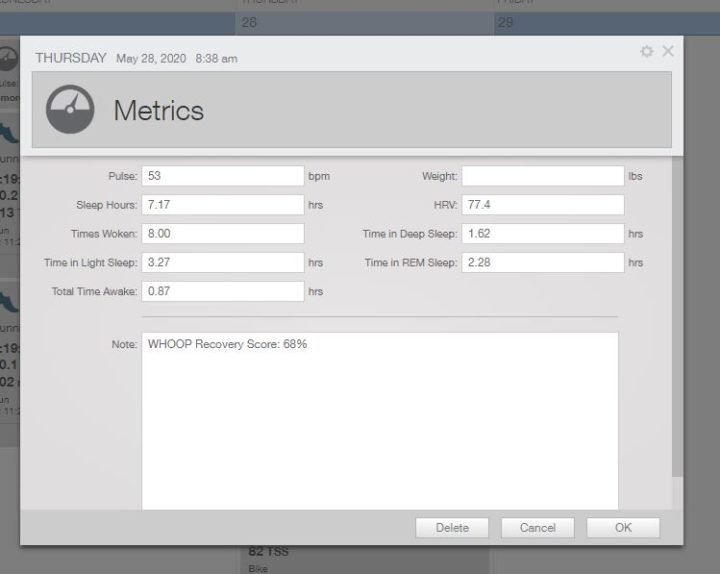
Now, once you wake up there is one last thing to do – which is to enter your journal entries for the day before. This is where Whoop goes through a set of questions (which you can customize, more on that in a second). So it’ll ask you things like whether you spent the night on a plane or drank alcohol or caffeine, or shared a bed. It uses this as part of your larger monthly reports that you can access.
Some of the answers have more detail – like time of last drink. It only takes a couple of seconds and I usually do it over breakfast (or, coffee, as it may be).
You can customize these questions too. As you can see from below, the current list is huge, and seems to grow every few months
The idea here is that you can then look at the data in aggregate as part of your Monthly Performance Assessment, which is accessed from the menu:
This then opens up a PDF that’s generated each month (usually on the 1st or 2nd day of the month) with insights based on all your journal activity. I’d argue, this is probably the coolest part of the platform. Though, it’s disappointing this is only generated once per month. After all, there’s no reason why (as I sit here on May 28th), I shouldn’t be able to see my entire month’s worth of data for May.
The first part of the report essentially summarizes the strain, recovery, and sleep aspects:
You can then see the impact for each of our journal questions on data like caffeine or using a device in bed.
Or, if you decided to track sex (one of the options in the journal), you could literally see the impact of that on your training and recovery (or, what Whoop thinks is the impact anyway).
Which, nearly four months down the road I’ve just now realized I’ve clearly misunderstood the value of Whoop all along. My mistake was thinking the HRV driven tracking of workouts and recovery would offer insights into how I can get faster as an athlete. In reality, it’d have been far more useful to simply have a PDF ‘Monthly Performance Assessment” report at the end of each month that says (to my also athletic wife): “Look, this huge AI-driven platform clearly states that we should have more sex to increase our athletic performance and recovery.”
And thus, nothing else in my review matters to a bunch of you now.
Heart Rate Accuracy:
As you’ve no doubt figured out by now, the heart rate data that Whoop collects is *EVERYTHING* to Whoop. It’s like a jetliner and fuel. Without it (or with bad fuel), it’ll crash. Unlike most other wearables, the Whoop can’t connect to 3rd party chest HR straps or sensors that may be more accurate. And it can’t import any other data into the platform. So everything has to come from that little sensor.
In previous iterations of the Whoop band, you couldn’t meaningfully export that data out, or compare it. But with the Whoop 3.0 band you can now pair up the strap to any 3rd party app/device and broadcast your heart rate to that device just like any Bluetooth Smart heart rate strap. That means I can pair my Garmin, Polar, or Zwift app to the Whoop 3.0 band and use it (Whoop) as a heart rate strap. That’s handy from a practical standpoint if you don’t have another strap, but it’s even more valuable from a validation standpoint because now I can easily (and precisely) compare the heart rate data produced by the Whoop strap to other known good devices.

And so, that’s what I’ve been doing for four months. Every single workout I’ve recorded – so far some 74 different recorded workouts across a variety of sports from cycling to running to skiing to gym work and more. For each of those workouts, I’ve then compared it to 3-4 other heart rate straps and sensors. Chest straps from Polar, Garmin, and Wahoo Fitness. Dedicated optical HR sensors from Mio, Polar, and Wahoo. And watches from Suunto, Garmin, Apple, Polar, Timex, and more. Wearing it with the included strap, then the bicep strap. Then the included strap on my bicep. Then on the other wrist, the other arm. I’ve separated all the sensors so they are not near each other as to not impact accuracy. No sensors share the same arm portion (above or below elbow) – standard industry practices for properly comparing devices.
Seriously, I have so much data it’s almost overwhelming. Almost. Rather than spew out nearly a hundred data sets, I’ve basically consolidated things into the most representative bunch of them (good and bad). There are trends in how well the sensor does, and so my goal here is to show those trends.
And ultimately, at the end of the day, I’ll save you more rambling: It’s the least accurate heart rate sensor I’ve tested in a long while – rivaling only the Suunto 7’s less than stellar optical HR accuracy.
And in a device that is 100% based on the accuracy of that sensor, it’s a huge problem.
But don’t take my word for it, let the data tell the story.
We’re going to start with something simple here first, a relatively tame 10KM run with no major changes in heart rate. Don’t worry, we’ll get to the intervals in just a second. Here’s the first data set, compared against a Garmin HRM-DUAL chest strap and a Fitbit Charge 4.
Digging into the first part a bit you can see that both the Fitbit Charge 4 and the Whoop strap are initially inaccurate during the build. They ramp-up too quickly, and are likely picking up cadence there. The slow-roll of the chest strap is more accurate to what I was actually feeling as I began my run down a very slight decline.
Still, by the two-minute marker all three were in agreement. Now don’t let this zoomed-in view below confuse you, the changes in HR are mostly minor here, it’s just the scale has changed as well. Most of this is only changes of a couple of BPM. The Whoop strap was consistently underperforming here though. But the Fitbit Charge 4 and chest strap were nearly identical. Even in some minor surges I did, the Fitbit Charge 4 stayed the course.
The problem here though is that, in general, it was about 5-7bpm low the entire run. This is somewhat rare in my testing, usually it’s either similar, or entirely off the map. Rarely is it just slightly offset.
Next, it’s interval time (this was a bicep strap run). This first bump you see is more of a kick up in pace than a true interval. Basically a build. But after that, those are legit intervals at approximately 6:10-6:20/mile (3:45-4:00/km). Nice cruisin’ pace. The Whoop is again in blue:
The Whoop strap in blue did less than awesome here. The Timex R300 totally lost the boat on the first build interval but was perfectly fine after that. While the Fitbit Charge 4 and chest strap were pretty close most of the time except the shorter intervals.
But really, the issue is those intervals. Again, it literally missed the entire point of my interval workout. Based on this, I should have just done a simple easy run:
Next, we’ll look at an interval workout on the track, with the Whoop data in teal. Here’s that data set:
The problem here is better seen once I highlight the Whoop strap. Sure, it’s good for the warm-up and the first interval. But then it loses the plot entirely during the intervals themselves. This is a huge problem because this is where your ‘Activity Strain’ will accumulate. So in effect, I’m not getting credit for three of my five intervals at the correct high intensity. It sees these as lower intensity intervals.
Next, we’ll look at a Peloton bike ride – nothing crazy intense here actually. Just a mostly casual ride. The Whoop strap is in green here, and you can see it struggles tremendously throughout this workout from an accuracy standpoint. Sure, it might look roughly like the others, but if we compare it to all the other sensors I have on that ride, it’s arguably one of the worst (save the TICKR strap which wasn’t wetted enough for the opening 8 minutes). Here’s the data:
And if we zoom in a bit on some sections, we’ll see how often it’s off – usually by 10-12bpm. For reference, that’s basically an entirely different zone.
If we look at an outdoor ride – most of mine were actually just like this – reasonably good. But in almost every case I rode outside I wore the Whoop strap on my bicep – and that helped substantially there (it didn’t seem to appreciably help in running however):
Next, we’ll switch to a longer interval workout indoors on a trainer. This is actually a reasonably good showing for the Whoop strap, with only some minor errors (it’s in green here). And here’s the data
The Whoop errors were early on in the warm-up, but recovered quickly. Some later errors were during the recovery phases, but overall this is one of the better showings by Whoop. The fact that I’m on a bike inside is what makes this easier for Whoop (as with any optical HR sensor), because it reduces the pounding of running, or the strain on my wrist of some gym-type workouts.
And here’s another indoor workout that’s very similar for Whoop to the other sensors. All of these units would have largely produced the same Activity Strain within the Whoop model. Here’s that data set:
Of course, you’re likely realizing what the pattern here is by now: Relatively stable workouts Whoop tracks well. But anything with any significant intensity, and Whoop often will lose the plot.
And that’s the real issue here: Once you add short high-intensity, the accuracy of Whoop tends to go down substantially. Longer intervals tend to be better. This is a pattern that’s not at all uncommon. Many watches’ optical HR sensors share the same issues, though, I feel in general Whoop’s sensor is more prone to high-intensity errors than others.
But that ignores the biggest difference: For most other sport watch/wearables, you can pair to another heart rate sensor (like a chest strap) and get more accurate HR data if you need it. You can’t with Whoop. So effectively it becomes bad data in, bad analysis out.
(Note: All of the charts in these accuracy sections were created using the DCR Analyzer tool. It allows you to compare power meters/trainers, heart rate, cadence, speed/pace, GPS tracks and plenty more. You can use it as well for your own gadget comparisons, more details here.)
Wrap-Up:
Here’s the thing: On the surface, the Whoop platform and promise is incredibly impressive. The user interface, once you warm up to it, is astounding in how it shows the cause and effect of what you do from an athletic and recovery standpoint. It’s really, really, really good at that. In addition, the automatic exercise recognition is usually quite good when it comes to recognizing that an activity has taken place, and the start/end times. And finally, the industrial design of the Whoop band is pretty nice, and I love the concept behind the snap-on charger for mid-flight refueling. All that is awesome.
The problem though? All of that is undercut by the accuracy of the optical heart rate sensor. And based on the overwhelming amount of feedback you all have given me as I’ve been testing this over the course of this year, many of you that have tried Whoop, agree. That sensor simply isn’t all that accurate when you sit down and compare it second by second to other products on the market. And given it’s the *only* input into Whoop, thus the *only* input into the Whoop platform is the data coming off that sensor, it becomes a real issue. Atop that, you can’t manually override failures when they do occur. When my 5-minute pedal to the store looks like the most intense 35-minute effort of the week, it screws up all the numbers. And there’s literally nothing I can do about that. I can’t just zero that out.
It didn’t take long to realize this, and I suspect this is the reason that up until Whoop 3.0 the company has heavily pushed back on opening data access or allowing any form of meaningful data exports. The Whoop 3.0 band finally allows broadcasting as a Bluetooth HR strap, and it’s that feature that really allowed me to understand where things were going so wrong. Of course, that’s still semi-limited. I can’t spot-check point in time HRV samples from the rest of the day (it only does HRV sampling at night while sleeping), to see if those are correct (which would validate or invalidate sleep metrics). I can only see an average for the night.
Don’t get me wrong – if we set aside the sensor (but we can’t, because that’s the product), what Whoop is doing from an analytics standpoint, a journaling standpoint, a data collecting standpoint, and a user interface standpoint – it’s all very very good. The app in particular is something that every other company in this space could take notes on. In fact, I’d say Garmin, Polar, and Apple should force 20 of their engineering folks to wear Whoop straps for 3 months to really understand it (the good and the bad). But to primarily understand the app and data flow and how to surface data to athletes in a mostly cohesive manner.
So what can Whoop do to address these issues? Honestly, not likely very much. Based on everything out there, this underlying sensor is the same one they’ve had for quite some time. And most companies tend to top-out on accuracy tweaks to their optical sensors after about a year or so. I think they realistically need two things: A) A new sensor, and B) To allow you to pair another chest/etc heart rate strap for workouts when you want. If they allowed that, it’d likely resolve 95% of my issues. Or, if they pulled in data from their already existing TrainingPeaks partnership and automatically matched up workout data in TrainingPeaks to Whoop’s workouts and then overwrote the heart rate data.
So, unfortunately, at this point, despite really liking the promise of the platform and the app itself, I just can’t justify spending $30/month anymore for a service whose foundations are based on inaccurate data, has no knowledge of my training goals, and doesn’t provide me with guidance other than telling me to sleep 11 hours a night…every night.
With that – thanks for reading!
FOUND THIS POST USEFUL? SUPPORT THE SITE!
Hopefully, you found this post useful. The website is really a labor of love, so please consider becoming a DC RAINMAKER Supporter. This gets you an ad-free experience, and access to our (mostly) bi-monthly behind-the-scenes video series of “Shed Talkin’”.
Support DCRainMaker - Shop on Amazon
Otherwise, perhaps consider using the below link if shopping on Amazon. As an Amazon Associate, I earn from qualifying purchases. It doesn’t cost you anything extra, but your purchases help support this website a lot. It could simply be buying toilet paper, or this pizza oven we use and love.


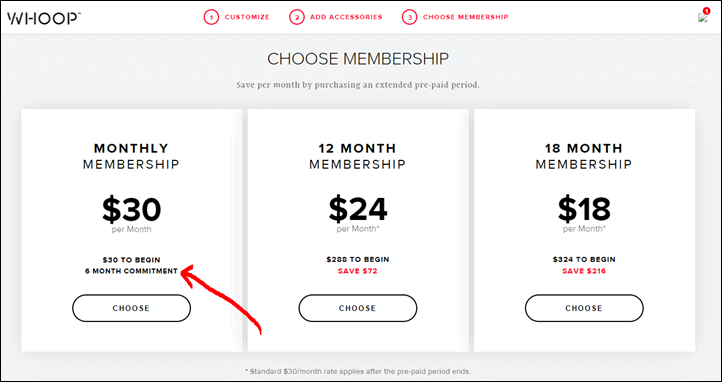
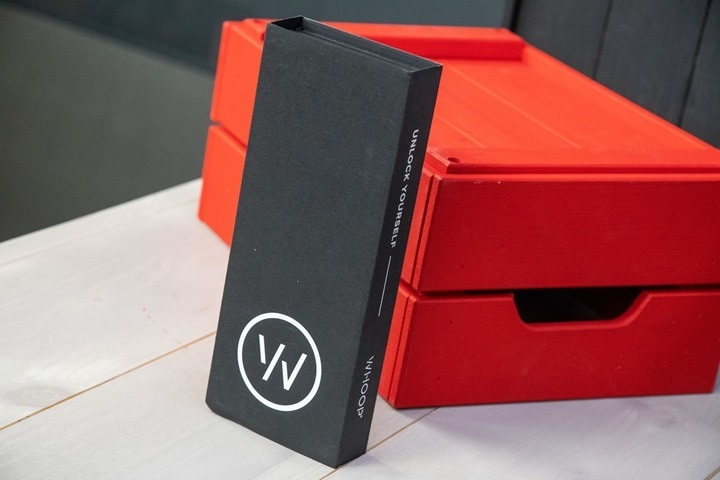
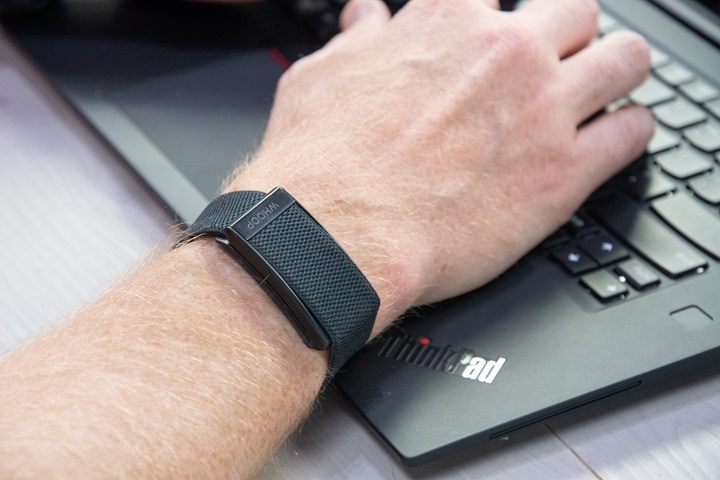
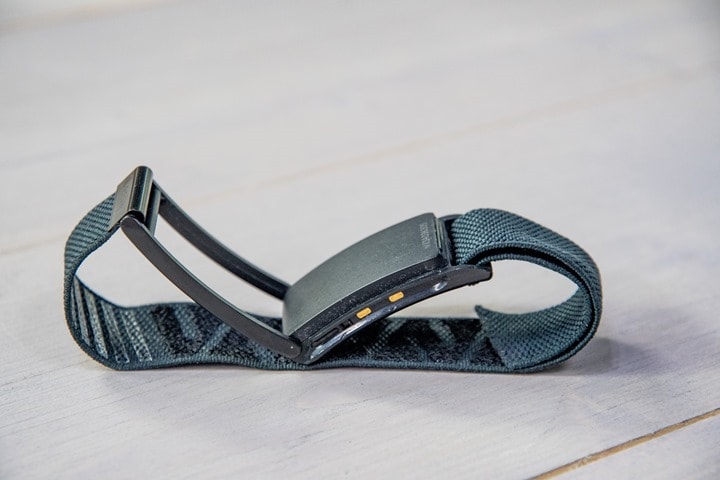
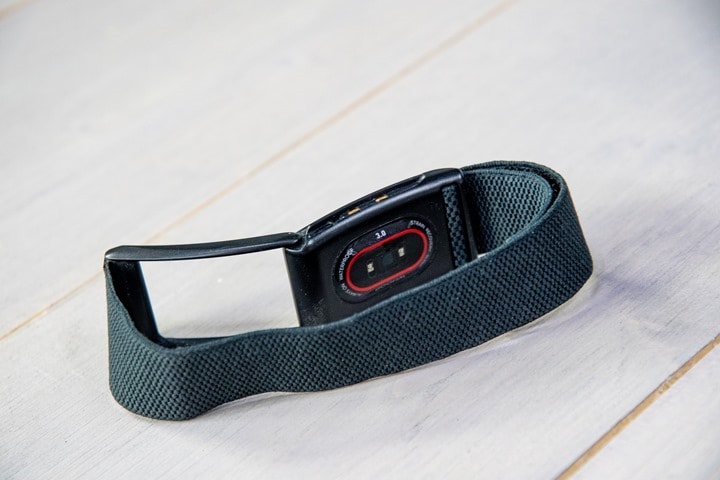
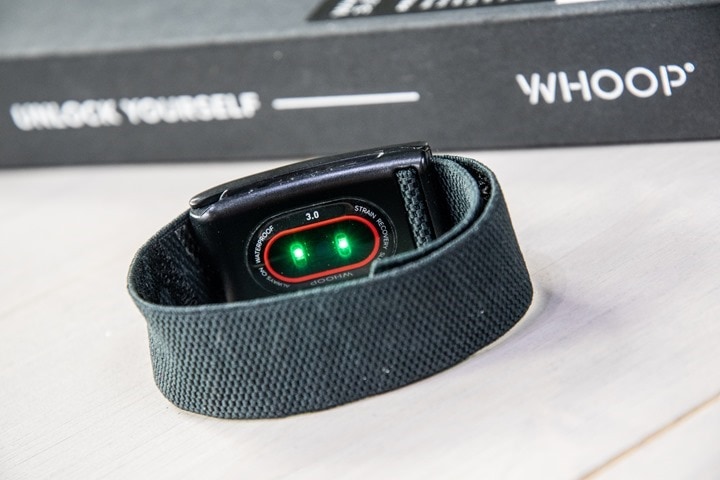

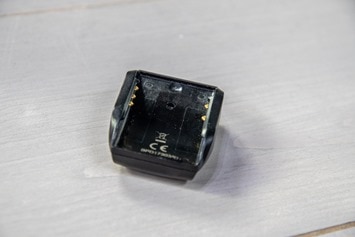
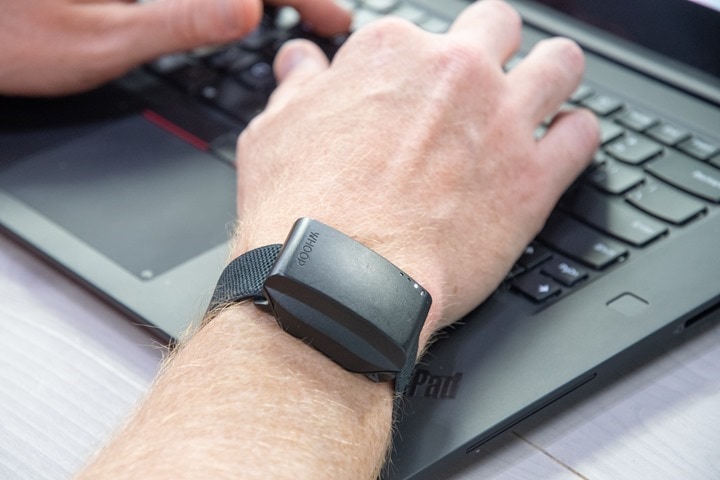
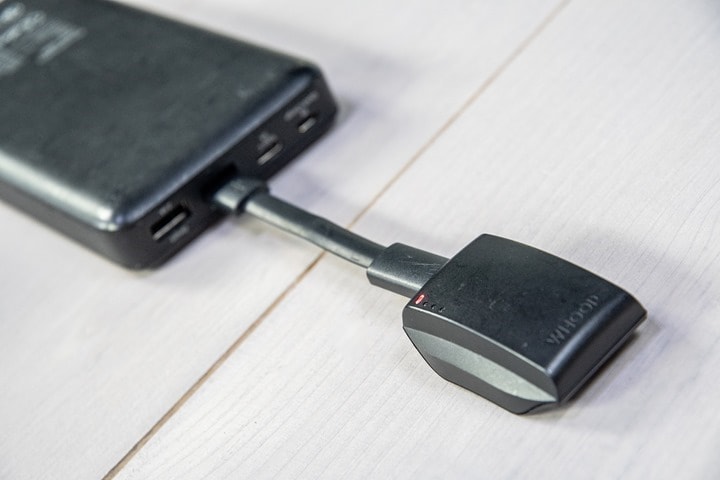
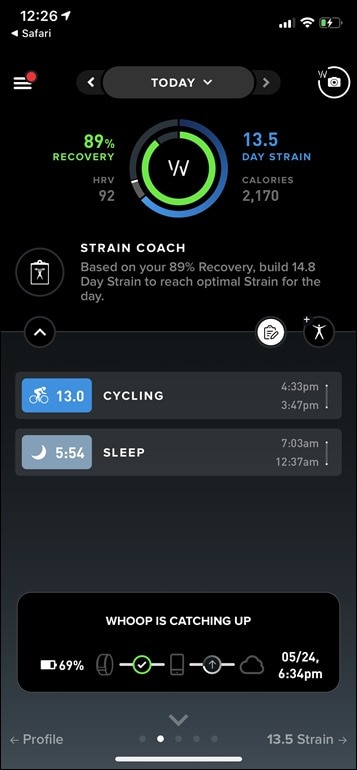
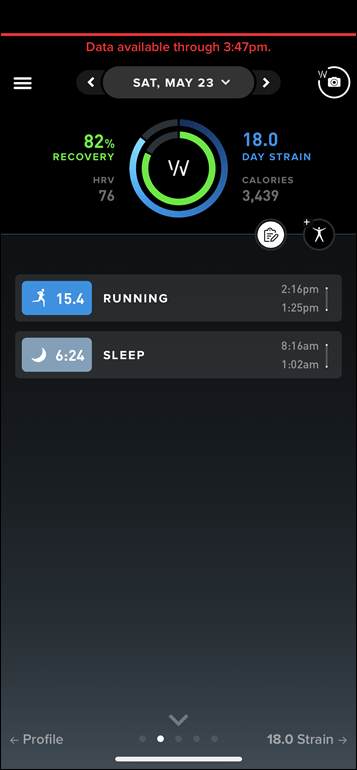
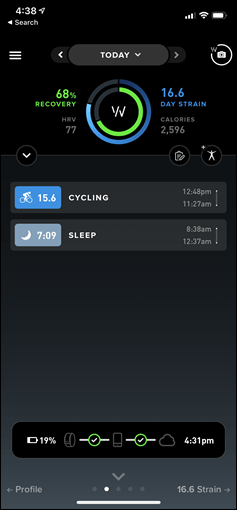
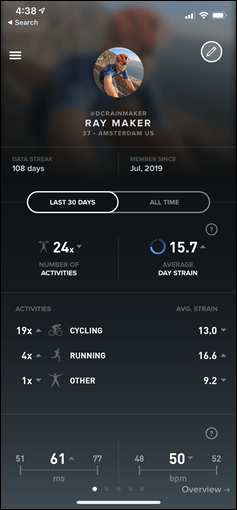
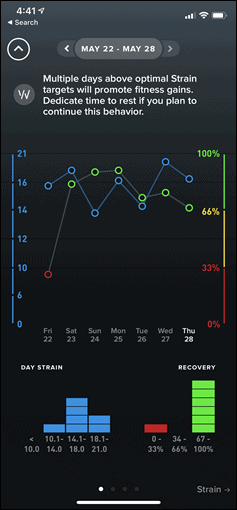
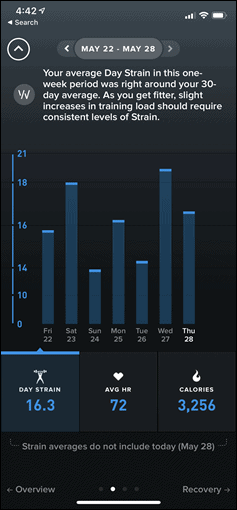
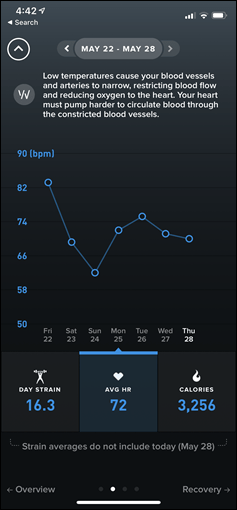
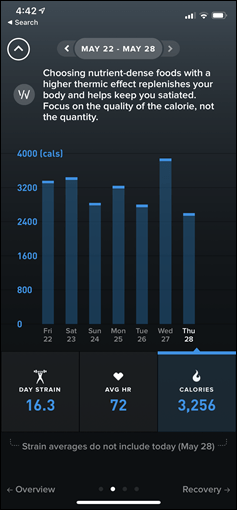
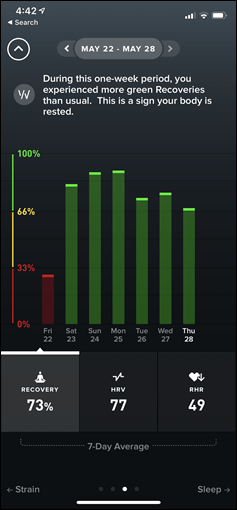



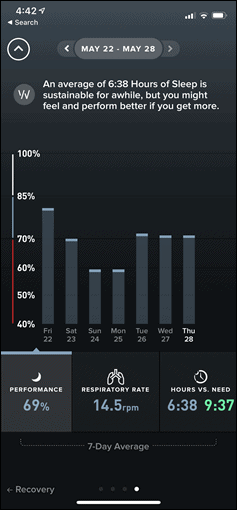
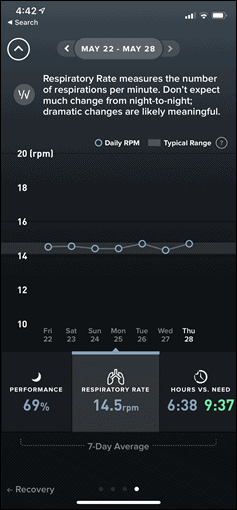

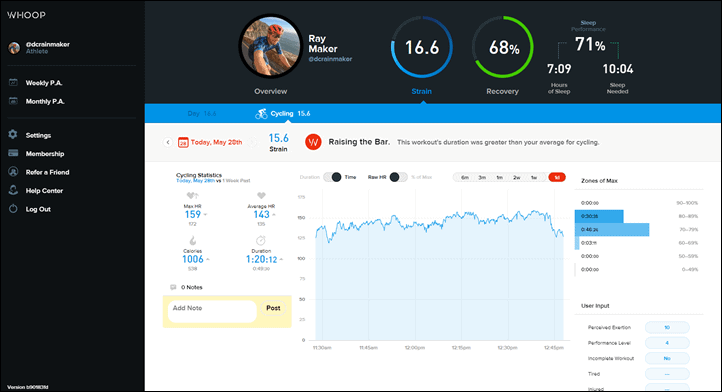
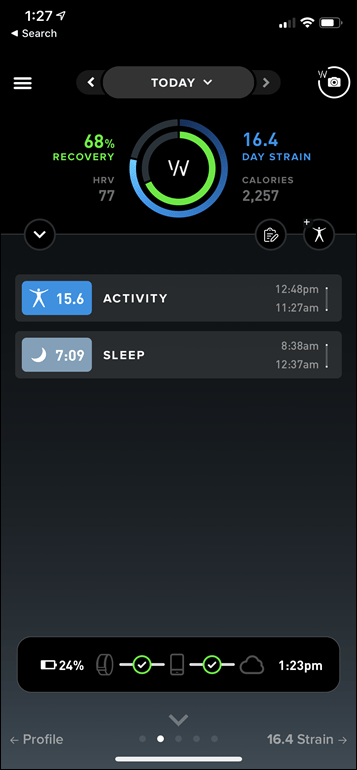
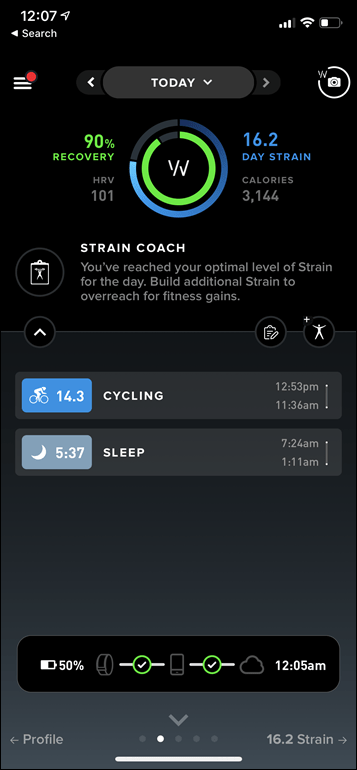



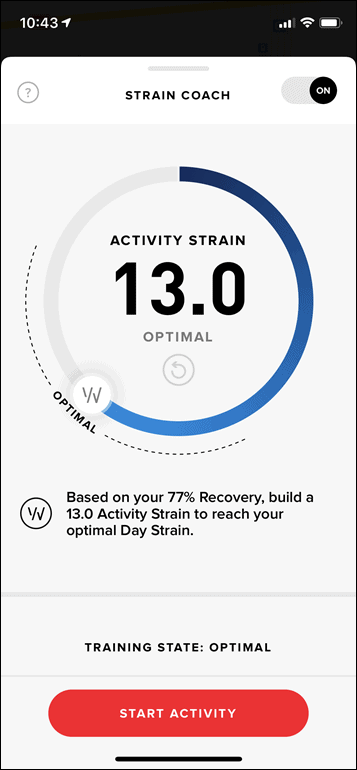


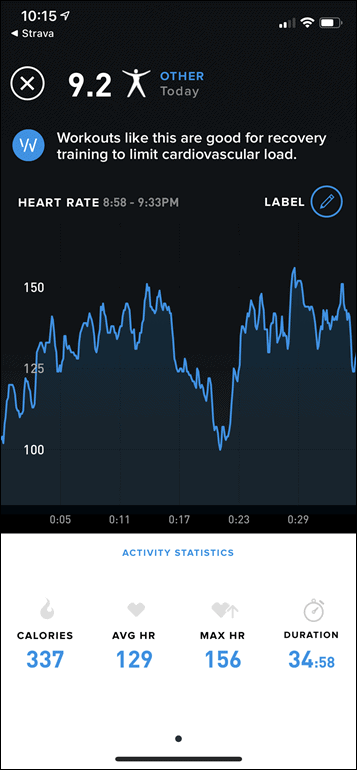
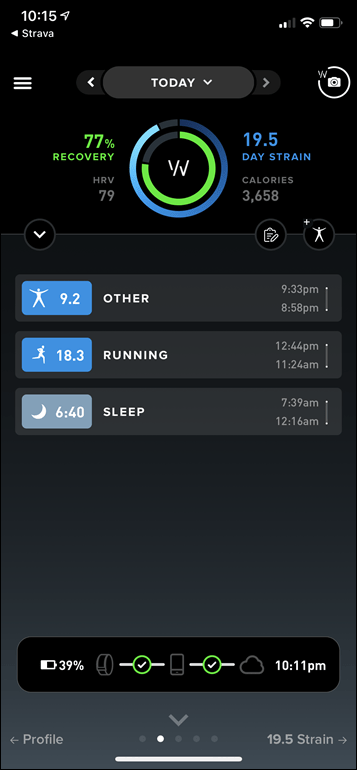
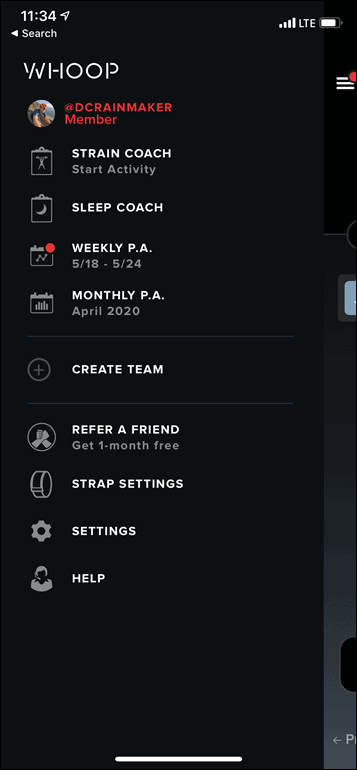


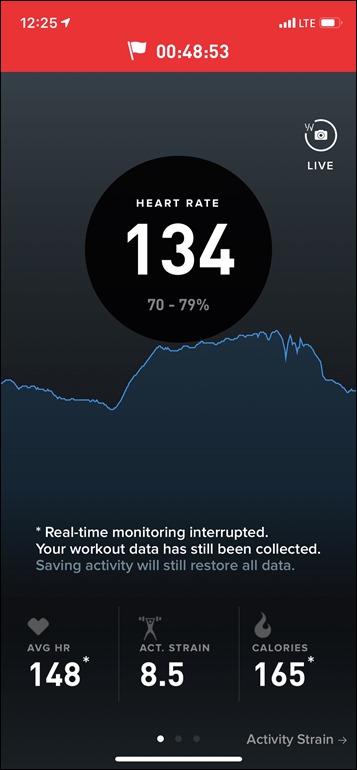

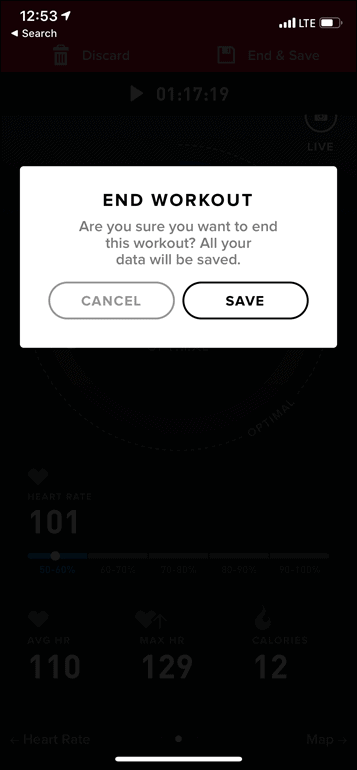
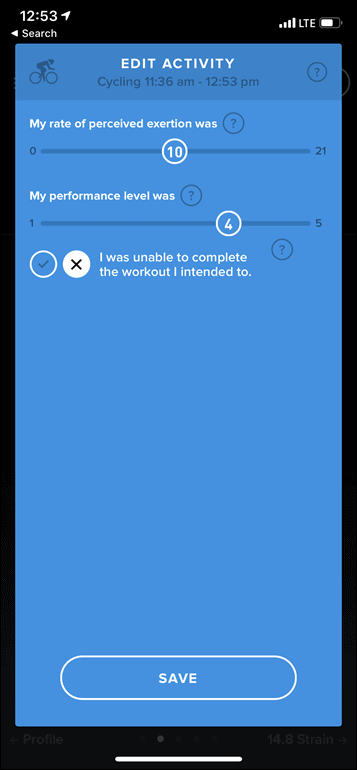
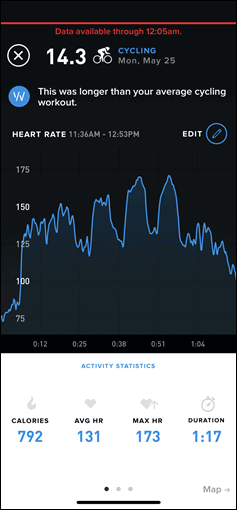
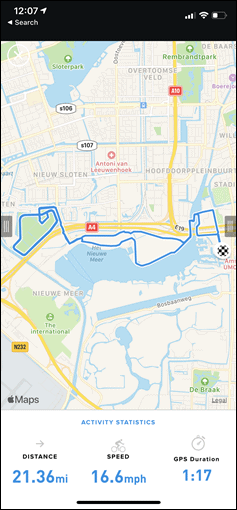
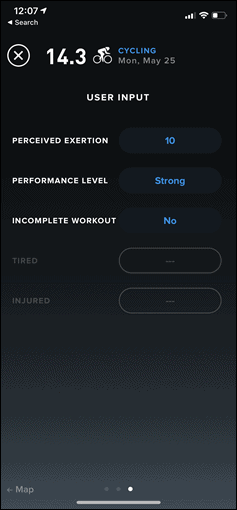

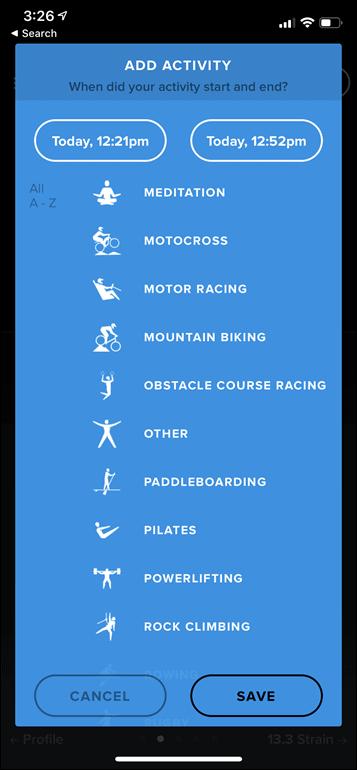
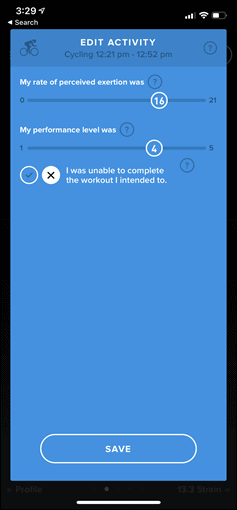
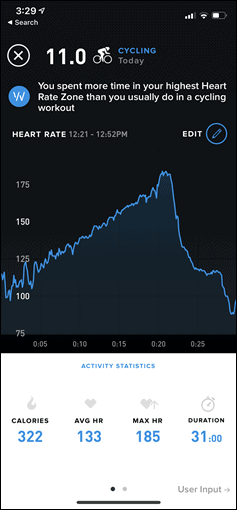
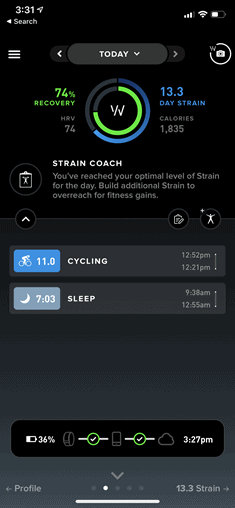

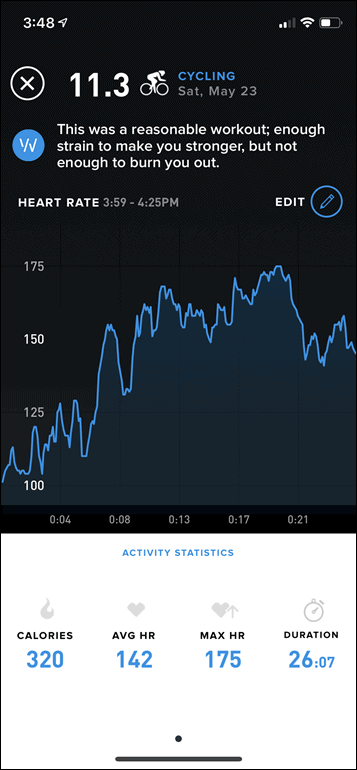
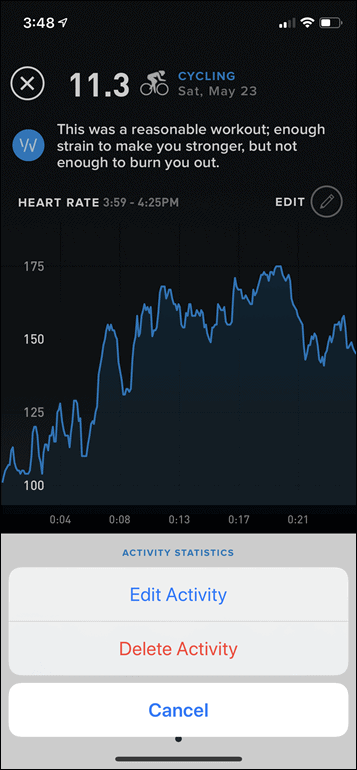
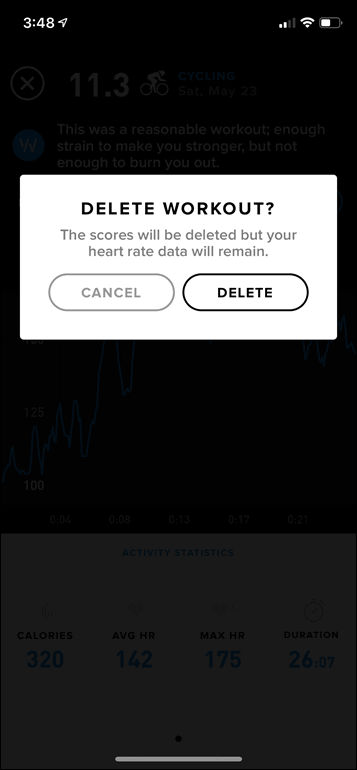
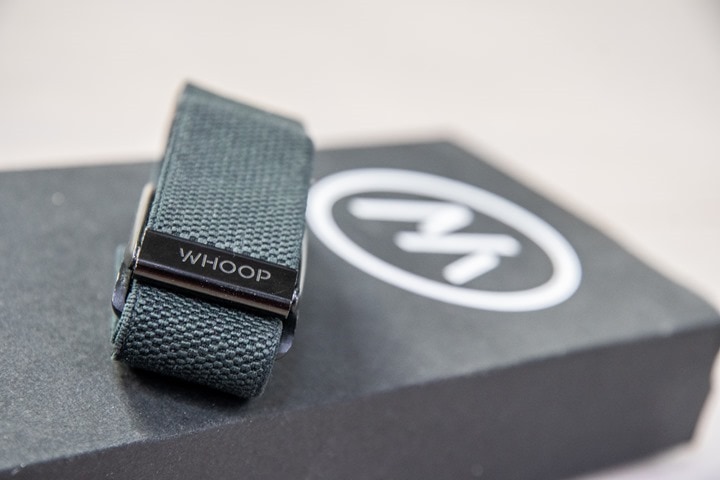
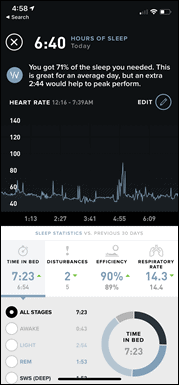
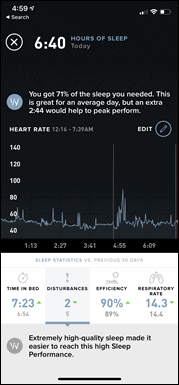
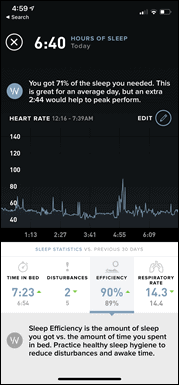
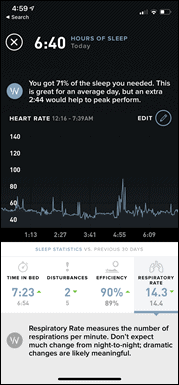
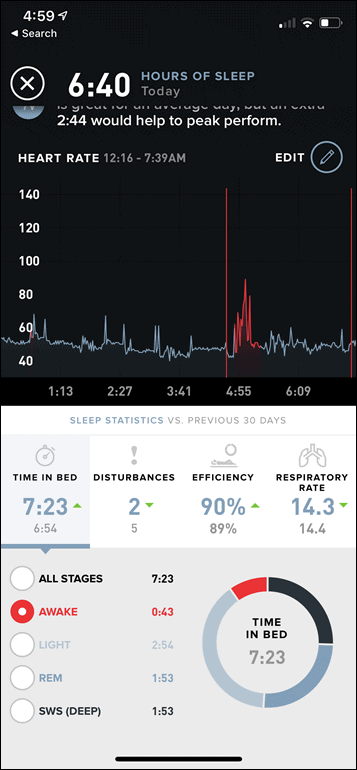
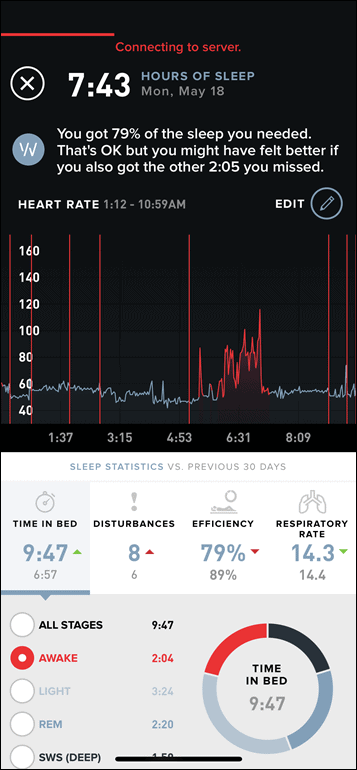
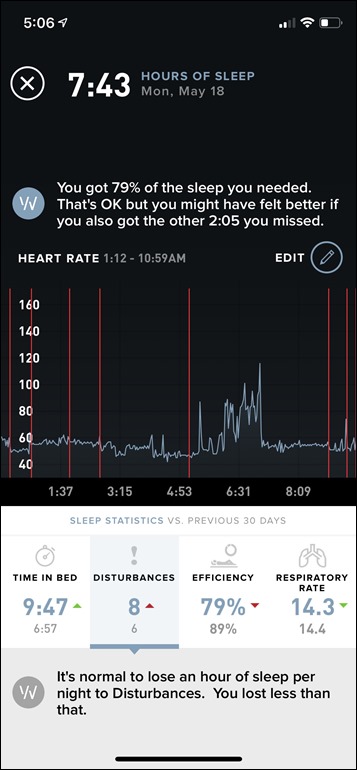
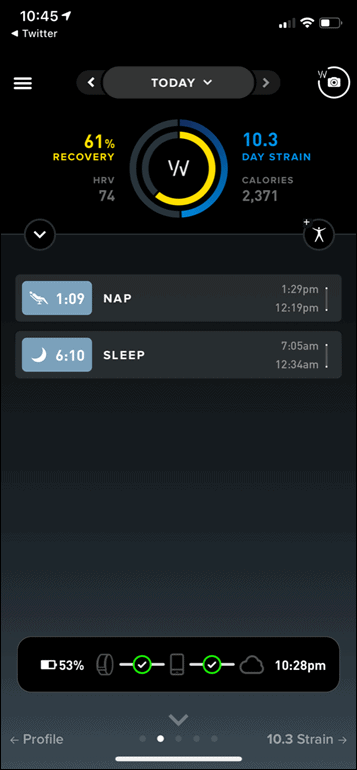
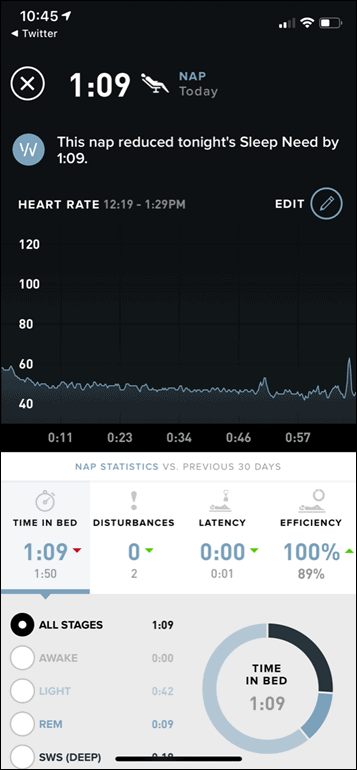
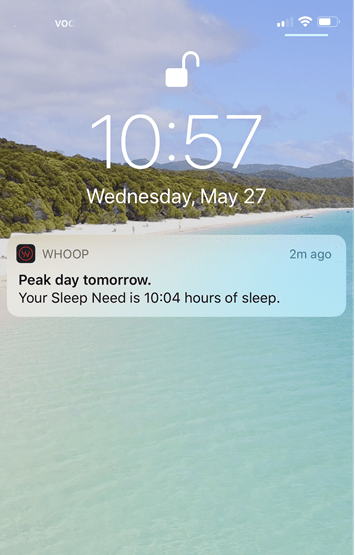
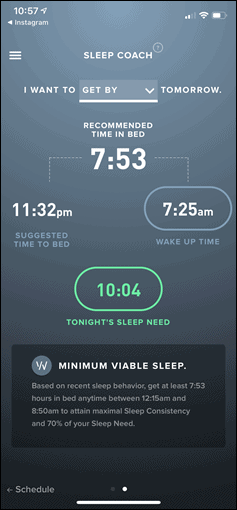
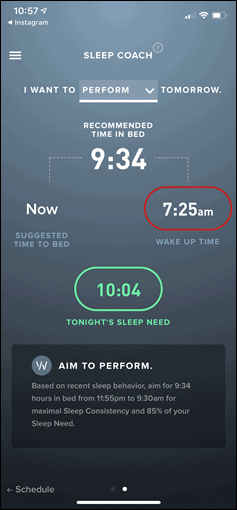
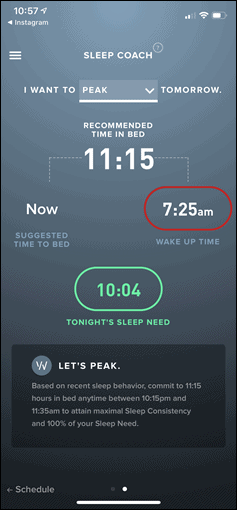
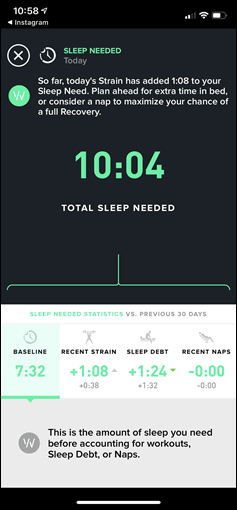
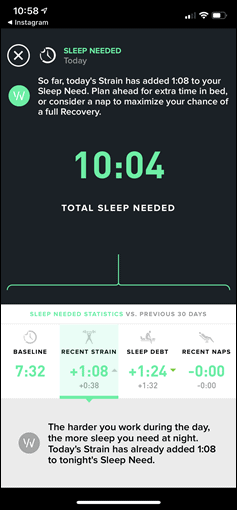
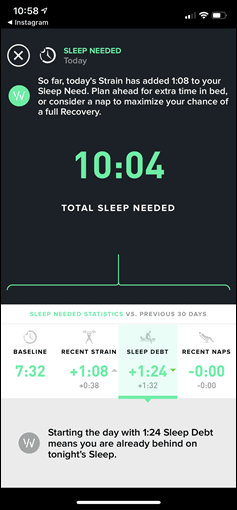
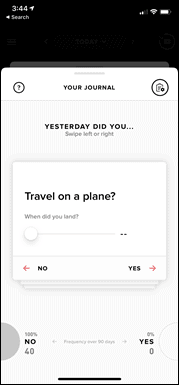
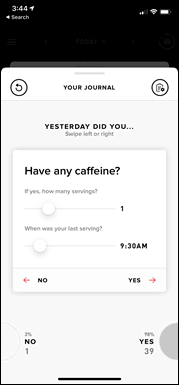
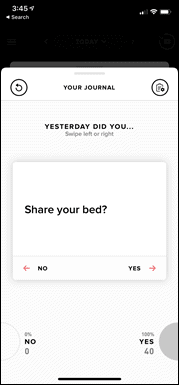
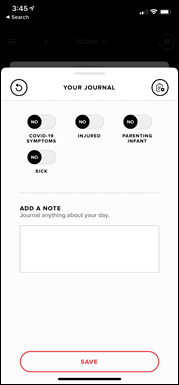
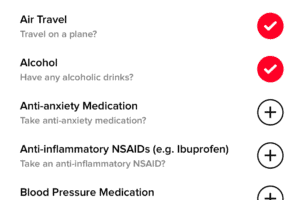
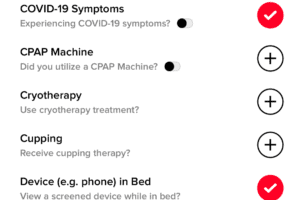
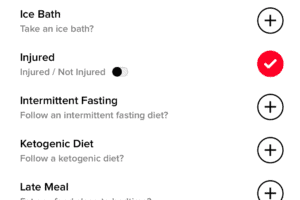

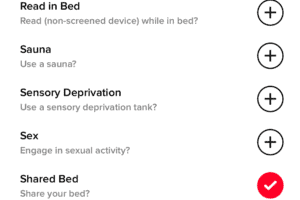
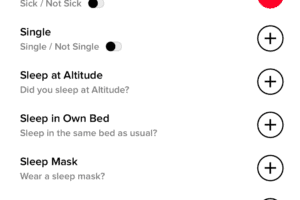
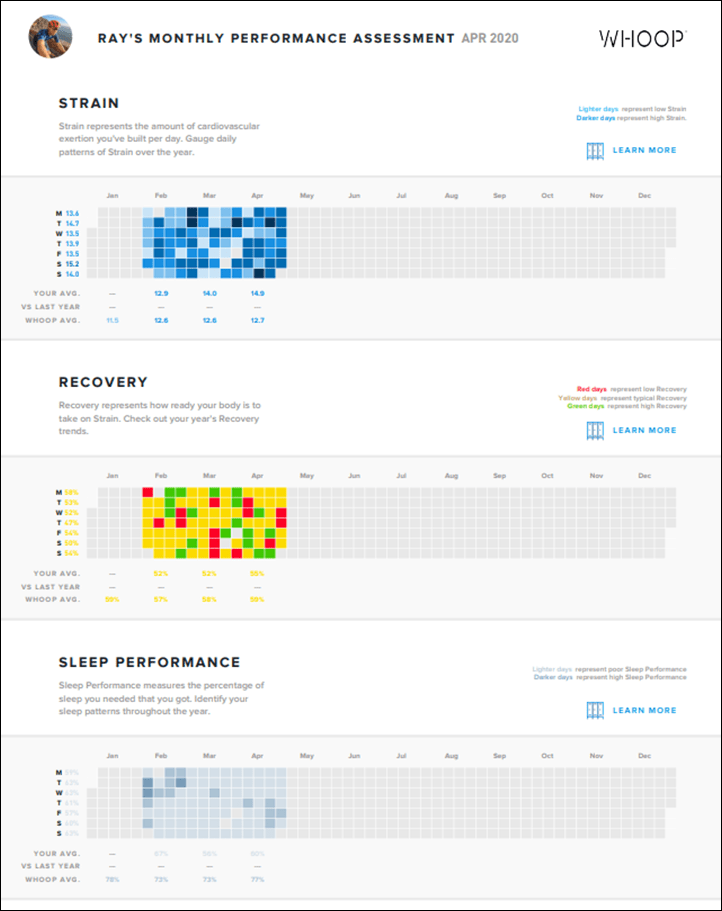

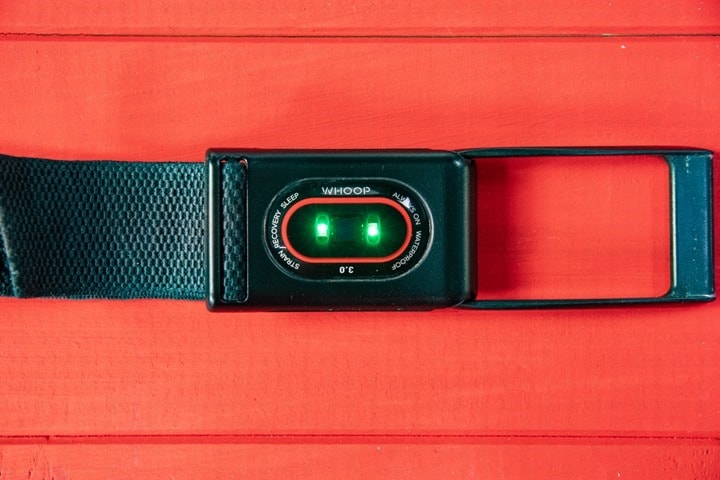

































I need to go the hospital from the burn I go just reading that last paragraph
I was interested in whoop at first until i saw yet another subscription. No thanks, hard pass.
More like three subscriptions, it’s almost as expensive as Peloton where you rent that entire spinning bike. But I guess that in some markets being sufficiently more expensive than everybody else is enough to set yourself apart… Unfortunately the conspicuous consumption band is narrow and certainly not a good place for a product that is 95% software.
Reading the introduction I was expecting a complete, almost provocatively hands-off approach, kind of like an anti-Strava: track and analyze everything on autopilot so that after initial setup you never ever have to touch an app or website again, but if you do the data will be there for you gif you managed to keep the pod charged, clever design with the “energy shuttle”). An app designed for minimizing engagement instead of of maximizing engagement, that would align well with all those mindfulness ideas floating around, post-socialmedia fitness tracking, this could be that one clever trick that infects yoga with technology. It would also somewhat fit the steep pricing model, the fitness app equivalent to the office desk of a CEO who’s too important to have a computer.
But screens like add activity, edit activity, take a video with overlays? It’s just yet another kitchen sink fitness app, only with a hardware dongle monetization added. Unimaginative.
Good stuff. I’ve used a Whoop 24/7 since October 2019. I’ve heard them market it by saying that is captures 100 metrics per second and records up to 200mb of data per day (might numbers might be off a bit). As a tech person, I remember thinking that there is no way that could be correct. I also thought, if true, how much more accurate would 100 measurements per minute be as opposed to 20? I’ve found the device to be just, meh. It’s is not accurate in terms of HR, as you have written about. But here is what I don’t understand, the company markets it as a device that captures huge amounts of data. Anyone that owns a Garmin 735 or newer, knows the Garmin captures much more data than the Whoop. Whoop just packages up the data in a much cleaner and more useful way.
Interesting review and findings.
How does this compare to Garmin’s Body Battery?
I was torn between the whoop, Garmin and the Oura ring for recovery tracking. I went with the Oura Ring, but had a similar experience to this review, the activity tracking (especially for cycling) wasn’t accurate (HR isn’t active during the day), and therefore although the concept was great, it wasn’t fully unerstanding my training exertions to map recovery.
That’s actually a question I started to write an entire section in the review about (comparing it to Garmin & Polar specifically).
I ended up pulling it out as I kept on going deeper and deeper and deeper and after hours, I realized I wanted to elaborate on it in more depth (and more rabbit holes). I might drop it as a standalone post tomorrow, or append this one with it tomorrow.
Fundamentally, they both capture the same data. It’s presentation that differs. Garmin lacks in presentation in most of this data. It’s a jumbled mess deep in the user interface. But once you find those bits, it’s actually deeper in terms of specific training recommendations if looked long term. As you noted, body battery is semi-similiar to Whoop’s Recovery score (but not exactly too). But what Garmin lacks in user interface hell, they make up in accuracy for workouts because you can pair to more accurate sensors if you want to. Plus, it doesn’t weight weeding as a workout into your training load. Only specific training workouts score into training load.
Of course, that has pros and cons too, which…is how I ended up spending hours trying to detail them all out and wasn’t happy I covered all the caveats yet. So more soon!
Is there any chance for a post comparing the different metrics that companies use? Obviously there is no way to include accuracy, but it would be interesting to see if some of them at least agreed with each other
As Garmin has added more and more Firstbeat features (BodyBattery, Training Load Focus, Recovery Advisor etc), I’ve thought they were going to eat Whoop’s lunch.
I’d love to see you make a follow-up post on how the different platforms metrics compare, and how to use them efficiently.
I’ve added “Performance Stats” as a tab in the Connect App, and “Training Status” as a card in the “My Day” view – maybe you look elsewhere for data though…?
Personally I find Garmin’s body battery to be pretty accurate. I’m continually amazed that the first sign that I’m getting sick is either a low body battery when I wake up or a low performance condition when I know I’m recovered well. I wear a Vivosmart 4 during most of the day and wear either my 945 when I’m running or my 530 when cycling. They all work well together to give me a full picture of my training, recovery, and general wellness.
Wish Garmin would come up with a discrete 24/7 Whoop like strap or Oura ring to compliment their smartwatches. Getting sleep, heart rate and step tracking from a minimal compact ring/strap will be so much better than having to wear a 945 all the time.
I’m not sure how much Garmin’s sleep metrics feature in its body battery calculations, but this is one area that I wish Garmin would put a bit of effort into. I think Garmin introduced these as a basic feature to keep up with fitbit etc in the early days when it was just something to advertise along with a step-counter, and they haven’t really touched them since, despite the important role they should play in the analysis package Garmin’s trying to offer, and what Whoop is trying to do.
For example, it seems that as soon as I sit down in the late evening (maybe 9:30), Garmin decides I’ve gone to sleep. It doesn’t matter if I get up again and walk around for half an hour before going to bed, it’s stubborn and won’t admit it got it wrong. Frustratingly, Garmin’s own systems seem to conflict here – I can often look on my freshly-synced fenix/MARQ in the morning and see it’s nailed the time I went to sleep, but if I check back later in the day on Garmin Connect, the back-end will have decided it knows better and will have changed it to show me going to sleep at the time I sat down to watch some Netflix. So it looks like the device devs have put some effort into improving sleep tracking, but some ancient legacy algorithm on GC just undoes all their good work.
I kind of understand how/why Garmin implemented Firstbeat metrics, but it’s really annoying and makes the ecosystem completely useless for me. The fact they ring-fenced the metrics to a specific device means that if I do not train specifically with that device, no data is used (happens with Zwift – Edge530 does not care – and with the Vivoactive, which I don’t use for training: it also doesn’t care about the heart rate recorded in the activity). This means that, e.g. Training Effect/Recovery/BodyBattery/etc. are useless, because it doesn’t capture the whole picture. It could be a great platform, but Garmin (and/or Firstbeat) makes it so compartmentalized, missing thus the point. I would love this licensing scheme to be reviewed – what’s the point of paying something that in fact adds little value to the platform?
Does importing an activity to Garmin Connect not effect Firstbeat metrics?
No, unfortunately not (this is especially problematic for Zwift/TrainerRoad/etc imports that don’t contribute to training load data).
I would love to see the Whoop vs Garmin/Polar comparison for sleep tracking and recovery! This is what I love about your reviews, no holds barred. If it’s great it’s great if it’s not then it’s not. I’m a cyclist and collect most of my metrics through wahoo bolt outdoors and zwift indoors in both cases uploaded to strava. I enjoy strava’s training tools but there is only so much data there. I recently picked up a Garmin 245 (not the most ideal for cycling but i didn’t really need a watch to pair with my PM) to get a handle on sleep tracking and recovery. I like that I can also broadcast HR with it in a pinch when need be. The 245 has been great but I must say that the Polar Grit X has definitely caught my eye specifically with it more in-depth sleep tracking stats and the fact that it, for the most part, is a bit of a bridge between the 245 and 945/fenix. I still haven’t quite been able to figure out if a Grit X will broadcast HR over bluetooth – it suggests it will in the user manual but I have seen no confirmation – dealbreaker for me at least if it won’t. I’d love to hear your thoughts on Whoop vs Body Battery vs Polar sleep metrics though.
Hey! It does look like you can broadcast from the manual, as you mentioned. I haven’t tested it but when you go into Sports Profiles in Flow it has a toggle button to broadcast HR there, and it’s always turned on it appears. I don’t know what equipment will pick it up, but the settings are there – not in the watch or sports profiles there, but in the Flow app. Hope this helps!
I would definitely be interested in reading your in-depth thoughts on the comparison because my experience has been that body battery is very straightforward. I get that Garmin could potentially come up with a way to integrate body battery into training status and load and add more recommendations, but I think I actually prefer to look at them all as different things, since they actually are. Yes, it requires a bit of judgment in terms of how you integrate them, but training always requires judgment. In any event, I’ve never met the athlete who just does what a watch or app tells them to do. Mostly it seems that people are looking for a little more information on which to base their decisionmaking, and I think body battery nails that.
Body Battery in my opinion using with the F6X for 6 months now and it is the best and most useful thing Garmin has released in a looonng time. I am a Garmin user back since the 205/305 watch days.
On another note it is nice to see they finally have started to implement some Garmin connect challenges.
link to garmin.com
Using Physio True Up means that metrics from one device ARE shared with other devices. Rides and training metrics from my 530 show up on my Fenix.
Note that oddly Garmin Connect only displays things on a per device basis. But if you look at the widget on a device, it will show activities intergrated across all devices.
Would love to see a comparison article. Hoping this kind of feature gets improved on as I have the 935 and thinking I’ll skip the 945 to get the 955. Looks like it may help identify early when you get sick link to washingtonpost.com
Though I do wonder if that is doing more then just looking at an increase in testing heart rate meaning if it can tell the difference between sick and just overdoing it and needing rest
Would be nice to read de comparisson
Same boat… I’m a bit of a klutz apparently and ALWAYS end up with scratched screens from hitting watches and straps on stuff.
Plus I’m not sure I want to be THAT connected to notifications bugging me, or aware of the time so constantly as a watch on my wrist.
Garmin’s biggest weakness, as far as I’m concerned, is and will continue to be that their UI sucks. Just look at the difference between a Hammerhead Karoo and any Garmin device. Or compare Garmin Connect with practically any other fitness analysis app. The idea that Garmin would ever produce an “elegant” device or interface is, at this point, laughable. If they haven’t done it by now, they’re never going to figure out that this is something people care about.
“I might drop it as a standalone post”
Yes Please!
I’m considering doing the exact same thing. I’m also riding with a bolt, but would love more information on my recovery, as I have a tendency to not get enough rest?. Was hoping a Whoop would provide that, but I’m not so sure after reading the review. But Garmins offering is perhaps also not the best, if that would require me te record rides both with the bolt and a garmin watch, or even switch out my bolt for a 530 or 830 (which I’d rather not do) and combine it with a watch. Anyways, whichever device / platform provides the best insight in my recovery, I’m definitely in, so I’m very much looking forward to what you have to say @dcrainmaker
You mean like the Garmin vivosmart?
For instance, or perhaps something like a 245 or better, because the vivosmart doens’t have the training load feature, which might be important too. This kind of relates to the story about the whoop, which I wouldn’t trust to quantify training load, but I would trust for recovery (as hrv is the leading metric for this), which the vivosmart also supports. As I understand it, the garmin watches that measure all-day stress and recovery rely on hrv measurements, which the cheaper watches support. If you would want to include the training load feature it may be nice to combine a cheaper garmin watch with an edge 530 or 830 (as 99% of my training load comes from cycling), but to be honest I don’t know how important the training load is for guiding my training.
Amen to that. Why not a (less than $100) sensor comfortable for sleeping in?
Would love to see the Garmin / Whoop comparison write up!!!!
I was thinking the same thing as I read it. It sounds like Garmin’s Body Battery, and their Training Effect and Load, much of the same data. For a little over one year of Whoop a person could a ForeRunner 945 and get all the same data and graphs, with no ongoing subscription.
Afaik most/all Garmins sync through PhysioTrueUp if you use them to record the activity (and have turned PTU on).
Could you post a link to the Polar/Garmin comparison?
Ray, late to this but would be really interested in seeing your thoughts on Whoop vs Garmin as you describe – do you still plan on sharing that at some point? Also, any plans on reviewing/comparing with Oura?
With the biceps band it is accurate as my polar strap is.
I found with the bicep band it was as accurate as both a Polar OH1 or Polar H9 for steady-state increases in intensity, or really long cycling intervals. But I found it still struggled heavily with running intervals, or short-high intensity intervals.
Does the bicep band mitigate the sensor accuracy concerns in general, save for running intervals, or short-high intensity intervals? Is that short-high intensity intervals specific to running or also cycling?
Mike
I have worn Whoop exclusively on the bicep since late 2016. I posted earlier about my experiences but, in a nutshell, it’s way more accurate for daily use on the bicep. I do however get awful cadence lock when running with it there. Otherwise for steady state cardio, it’s more accurate there than at the wrist.
I could routinely achieve 10 daily strain by doing nothing especially challenging when wearing Whoop at the wrist. Wearing it on the bicep my normal daily activity doesn’t create any strain (sitting at a desk mostly).
It’s also a real pain to charge so high up, but on the plus side, I can wear a different watch on my wrist.
Thanks for the great review Ray! Any chance you’d do an Oura Ring review anytime soon?
I had the Oura Ring for a month, great in some ways, not in others. Great and descreet for night time sleep, body temperature and HRV tracking. A lot of people love it, it does have some great strengths. I also noted that some people only wear it at night.
It uses an accellerometer for activity tracking (no HR tracking during day) so it seemed good for activities where the hand was moving, eg. walking, running, gardening… I assume swimming. However, I’m a cyclist and it didn’t recognise cycling (especially on the indoor trainer), I could do an FTP test and it wouldn’t recognise it at all, it would appear as less effort than an easy stroll. Also, I wasn’t able to sync from Strava to Oura, although I know Apple users can sync from Apple to Oura.
In the end, the Oura didn’t capture my 14 hours a week cycling workouts and therefore I felt it couldn’t really undersand my exertion versus recovery…. although you could argue that night time HRV and resting HR are enough to determine ‘readiness or fatigue’. So, I like it a lot in many areas, just didn’t quite work for me specifically.
I’ve been using an Oura ring since 11/2018 and found that the HR is good for overall use, but not workouts. I have an iPhone so sync my Strava data to Apple Health and Oura syncs with that. Even if my workout data didn’t show, my RHR and HRV can tell me when I’m tired and need more rest. Not surprisingly alcohol and work stress impacts my HRV more than aerobic workouts.
After a couple of months of wearing it 24/7, I changed to wearing it only at night. I get about 5-6 workouts a week so have all that data through Strava, Training Peaks and Xert.
Overall, I love it. It is tiny and doesn’t bother me. About a day before getting sick, my HRV drops and RHR goes up. I found that when my RHR is low, HRV is high and have a good deep sleep, I am ready for a hard workout.
I’d be interested in this too.
I have a Garmin 935 and 830 for my activity tracking, but i want something to track sleep / daily steps etc that isn’t as ‘cumbersome’ as a strap on my wrist.
I think the Oura ring is very very good at tracking sleep and general readiness for the day ahead. In reality, it just confirms how I feel when I get out of bed – but it does that very accurately. And if my HRV/RHR suddenly drops/rise, it’s pretty certain I’m coming down with something. Overall I’m very impressed with it – but it’s not a sport tracker. I use a Fenix for that, and it’s a good complement
PS – would love to see Ray forensically review the Oura, and confirm, or shoot down in flames, my findings :-)
Having spent about 9 months, last year, paying for this crap, it’s good to hear someone agree with my assessment of it. The majority of the “community” are cross fit types, have clearly fallen for the marketing, hook, line & sinker. The Facebook group is like something from a communist state & any remotely dissenting post is quickly deleted by the sole moderator Russ (paid I suspect) who also runs a business with the connected PNOe testing company. The mantra of the user base is “the product is flawless, you’re not using it correctly”. Anyone who’s spent any time using power/training peaks/WKO5 etc will be seriously disappointed. I mean, come on, has anyone really used HR as a serious training metric since the 90s? The only positive is it’s relatively easy to get out of the subscription, I just stopped paying one day & never heard another word.
Ah yes i’ve been “shot down in flames” a few times on various WHOOP Facebook groups for daring to suggest the way i feel (i know my body) is in complete contradiction to what my WHOOP is telling me and it’s WHOOP’s data at fault not my instincts.
Pretty sure Lucy Charles(pro Ironman Athlete) trains by HR
Wow. What an article! Kudos for going into such detail and offering an impartial view of this device. Reviewing the latest Garmin must be a piece of piss compared to this kind of in-depth, long-term analysis.
I pay a lot of attention to my Body Battery on my 945 as it gives a pretty good insight into how hard I am training, and how poorly am recovering. It’s very good at spotting hard effort and also hard partying!
Doubt it’s worth paying £30 a month for another device that does a similar job but with lower accuracy
Excellent, excellent review – so glad it’s finally finalized! Nothing more to add – all well stated – and I agree completely.
Thanks for the write up. Confirmed a number of things that I suspected. I’ve been working out my own recovery figures from getting the rmssd, my rhr, sleep and previous TSS. It wouldn’t be difficult to add in all day stress figures from Garmin (thanks firstbeat) nor would it be difficult to have suggested TSS. Integration with something like trainingpeaks so that a coach could monitor and advise would be easier to have adaptable training plans. I’d be interested to see how this area of health metrics and predictive ML/AI based coaching works out.
Ray. As always, I appreciate your posts from all aspects. You go deep like no one else and provide all of your readers great tools to decide what to buy from your reviews. I am a DC devotee and will continue to be.
For me, however, I am not looking for the Whoop to be my end all product. I like to watch my HRV and relate it to how I feel that morning. DId i drink? How did that affect my Recovery Score, etc. I am getting a great general sense of my health and well-being. I do not believe my HRV has anything to do with my Strain that day and I do my workouts as prescribed by my coach. If i didn’t perform as I expected, I will look into my Recovery, my habits (alcohol), my sleep and try to improve. I think your analysis was too focused on the Day Strain being perfectly accurate for you to like the product. I have a Garmin HR monitor, Edge and really only generally look at Day Strain. Anyway, thank you, as always for your detailed insight. I, for one, like my WHoop for the information it provides me which in order of importance is HRV, Recovery, Sleep information and then Strain.
Thanks!
I agree, I think the Recovery & Journal-driven aspects of the product are generally well done. I have very few issues with the sleep related data (recommenations not so much, but data is mostly quite good). So if you exclude the workout aspects, and focus purely on what it’s telling you from an HRV-driven recovery standpoint, I think that’s fine.
Cheers!
100 % agree. That‘s how I use Whoop as well. Strain seems like a gimmick and I prefer Garmin‘s Body Battery when it comes to tracking the overall stress of any day. But Whoop‘s recovery feature has worked really well for me over the past nine months. I have learned a ton about what helps me recover. Also, I have changed a bunch of things around to drive higher recovery scores. As somebody who traveled non-stop before Corona and who still wanted to get structured workouts in, Whoop has also helped me identify the right days to go out and do the hard work. In summary, I am pretty happy with the investment as Whoop has helped me identify gaps, put attention on recovery and has helped me make some general life-style changes. I therefore love it and do not regret the investment.
Out of interest, have you read the book “Why We Sleep” by Matthew Walker? I found it very helpful for thinking about and understanding the Whoop’s sleep directives… I think the key here is that what it is recommending is time in bed, rather than time asleep, as those two are sometimes misconstrued as the same thing.
Just started reading this book, which I believe was recommended in the Whoop Podcast :)
Ive had a sub for a week, I was waiting for this review before I committed but decided its going back a couple of days ago. The kicker? It picked up an hours car journey as an activity and recorded a max heart rate of 193, my wife’s driving is not that bad, and I’ve definitely not seen a number like 193 for a loooong time. Ill stick with the Garmin Body Battery for now…
Thanks for the terrific review. I just received my Whoop Strap and now will return it I guess after reading your review. If the HR strap is not accurate then the data will be no good as say. Too bad as I was looking for something more accurate than Garmin Fenix 6x for sleep tracking and loved the concept of Strain and Recovery data. Kind of wondering why some pro athletes are using Whoop and apparently not being sponsored by Whoop from what I have been able to find out.
Totally agree. I have had it for about a year and sleep recovery seems totally based on HRV. Which we can’t test accuracy of. As for HR I have seen same issue when compared to HR strap – my issue is if I get up from sitting my RHR around 50 then goes to 60-70 just walking around house the Whoop goes from resting to 100+ when walking around house! Go figure! Based on my data and this review I will not renew my subscription to Whoop.
To lift a quote from Whoop themselves: “Each morning, WHOOP uses your HRV (as well as your resting heart rate and sleep performance) to calculate your daily recovery–how ready your body is to perform.” [https://www.whoop.com/thelocker/heart-rate-variability-hrv/]
They’ve mentioned in an instance of their podcast that the HRV measurement is even more specific to the third SWS period, but based on reviewing my own data (been on Whoop approaching on a year and a half) I find that explanation lacking. But given it is a proprietary platform, it isn’t surprising they’ll keep specifics close to the vest.
If Ray wants to have a little more fun before ending this experiment, I might suggest messing with your hours of sleep on any given morning. While I like the Whoop platform, I’ve had concerns with the ability to manipulate the Recovery score with some adjustments to the start and end times of your overnight sleep. It doesn’t happen every time, but I’ve run into occasions where my Recovery score has bounced around between a 20-30% range as I mess with the sleep timings.
I work with several scientist from different sport federations. And the request from the athletes was to implement whoop into the platform for athlete data.
The scientist compared the whoop strap/data to medical hardware and data and also polar. And polar was more on point compared to the medical equipment (I’m only talking about sleep performance here). The whoop appeared to be way off.
It’s been a long time, but still I’d answer for future readers.
WHOOP is using HRV from your last SWS period lasting 5 minutes or longer and weighs it perhaps as much as RHR, and more than sleep duration/quality/consistency, and breathing. Thus, changing when your sleep ends manually can most definitely change your recovery score.
This isn’t that much different from Polar Night Recharge though: whereas Polar is looking at a 4-hour window following you falling asleep. Change your sleep start/end time, and your recovery status will be different. Sure enough, Polar has disabled any editing of sleep times, which is a shame given that for me it misses beginning and/or end of sleep by at least half an hour every 4-5 days.
The bottom line: nobody’s perfect. Every recovery tracking tool out there comes with a set of implicit limitations.
So I am week 1 into my Whoop experience and your review has opened my eyes as to its overall accuracy.
What would you is the best sleep tracker out there right now?
What’s the best device for calculating RHR?
As I understand it the sleep tracking is still well-supported as accurate.
it sounds to me like Whoop should just be an app that pulls from other data sources, garmin, apple health, training peaks etc. If the product is the app and the AI, and it where device agnostic, it sounds like it would be amazing.
My thoughts exactly. I think they would make more money if the algorithms received better data.
Your review knocks it out of the park – I wish it was out 3 months ago when I got my whoop! Your take-aways are spot on with my experience… HR tracking lags, especially in intervals. I would add that the whoop system really pushes you to never take it off. It trains you to feel like wearing it less than 24×7 , and you’ll miss out on that sweet, sweet data. Additionally, you’re supposed to keep the strap fairly tight – a quick search about HR accuracy, and you’ll find loads of whoop defenders saying “just tighten the strap, bro!” Even though the device is fairly small and more comfortable than a fitness watch, wearing it tightly 24×7 is uncomfortable (3 months in, and I am still bothered by it at night), and can lead to skin irritation.
I’d be really curious to see a side by side of Whoop’s measurements and Garmin’s Body Battery readings.
Whoop has been garbage for a long time. I documented it with them thoroughly and they never cared. Always responded. But never cared. Each communication was a different response. Wear it on your left. Wear it on your right. Wear it higher. Wear it lower. It was really hilarious. No matter what I said, their response was that I was doing something wrong and never about their hardware or software.
All that being said, is HRV even established as an important metric to be tracking or developing.
Not anymore. HRV was the holy grail of directing one’s training, especially with cross country skiers. It’s been debunked by research though for some time now to not be (who would’ve thought!?) the be all and end all metric of training. The body is just too complex an organism to be reduced to a simple metric, which to make matters worse is reaaally sensitive to anything disturbing (like a cough, a barking dog, the mere thought of the result, rate of breathing) the standardized procedure required.
Which is why they only measure HRV during slow-wave sleep (N2/N3 stages) that lasts 5 minutes or longer, to make sure to avoid any potential influences. And why HRV is weighted at about the same as RHR, while the recovery also looks at your sleep duration, quality, and consistency and since recently, at your breathing rate.
Is WHOOP perfect? No. But they are trying.
To be honest, I always thought the Whoop game plan was getting acquired by Apple. That would allow Apple to fix their own heart rate issues and bundle the Whoop features with other premium Apple Watch stuff that they certainly have up their sleeves to start an Apple Watch + subscription model.
But I was also always under the impression that Whoop would have a heart rate accuracy that’s closer to my heart rate strap than to my Garmin Fenix.
If Whoop doesn’t solve those issues relatively soon, I doubt they’ll have a long term future. I mean at some point Garmin and/or Apple will come up with their own solutions (or do buy Whoop just for its algorithms which would substantially lower the price)
Great review.
Thanks for a great review Ray (as usual). I was interested in this, as I have worn Whoop every day since December 2016. I love what they are trying to do….
I found very early on though that the HR sensor was mediocre. The only way for me to get an accurate(ish) reading, was to wear it on the bicep. And so for 3 1/2 years I have worn it 24×7 on the bicep – despite the inconvenience of charging it there. Wearing it on the wrist, I would routinely develop 4.1 strain simply for getting out of bed. Wearing it on the bicep at least means that I don’t get any extraneous strain for daily activities that are inconsequential.
The key issue for me is this…. if the HR data is so obviously unreliable, how can I have any confidence in the accuracy of any of the other metrics or the validity of the recommendations? (Yet I still wear it ;-) ).
This was clarified for me early on in my “Whoop life”, when after a particularly heavy night of alcohol consumption and subsequently the worst hangover of my life, I received a “Green” and probably my highest ever “recovery” score. I was most definitely not “primed to perform”….
From my own personal observation, the HRV daily measurement from Whoop is routinely lower than the measurement from a heart rate strap. So what I mainly use Whoop for is observing longer term trends – rather than focusing on the individual metrics on a daily basis. I have little confidence in the sleep stages metrics, because it routinely believes I’m sleeping when I am simply “reading in bed”. I have also noticed that if you shorten the sleep cycle from say 8 hours to 7 hours, it will also tell you that the amount of deep sleep you experienced actually increased from say 90 minutes to 2 hours.
The other question I have is this (and it is not specific to Whoop)….. Who determines the importance that specific measurements or attributes should have in determining the “recovery” score for example? The fact that I had 8 hours sleep vs 7 hours should have how much impact on my personal recovery score? If 1 hour of that sleep was deep sleep, should I have a higher recovery score than say if I got zero deep sleep? If my HRV was lower that day, how much should that influence my overall recovery score. Would the weighting be different for somebody half my age? Or perhaps somebody that is a different sex….. Once you start to consider all of the variables involved in assessing “how recovered you really are” (and the difficulty of measuring them accurately), you start to realize that we have a long way to travel before a device can really make accurate, personalized recommendations.
Finally, I’m also surprised by the “cult” of Whoop and I can only assume that they spend a significant amount of money on influencer marketing. I wish they would direct that investment to improvements in accuracy.
Thanks for the review. It looked appealing but the imo hefty price of the subscription model + shit data is enough to steer me clear.
The fundamentals of training and recovery are actually really simple – and most people can continue to improve simply by continually trying to do those fundamentals better. Basics are hard to sell because everybody already knows them.
Advanced and individualized training and recovery are really complicated – and for the most part, impossible to identify entirely technologically without at least some manual work and interpretation by an expert. It’s also not especially useful to most people as they would be chasing marginal gains instead of getting large gains from better fundamentals. Advanced things are hard to sell because the viable market for them is small.
So what is a company to do?
Sell the basics as advanced insights.
Tell people what they already know, tell them what they want to hear, and tell them what they are already doing but wrap it in charts, graphs, math, and jargon.
Whoop users are paying $30 a month to be told that sleep is good for athletic performance and that you should train as much as you can tolerate in the context of the rest of your life until you are no longer getting quality training, and to then rest until you are ready to train more.
The act of measuring something can help develop mindfulness and improvement, but there are cheaper and easier ways to measure sleep and training.
I’ve had the Whoop 3.0 since October of last year. I purchased a 1-year subscription to give it a good try as I’ve been looking for something like this product for many years. I’ve often worried that I tend to over-train on days when I didn’t sleep well. Like many, I’m always trying to optimize my workouts. With that said, I will not renew my subscriptions for the following reasons.
1. The heart rate tracking is terrible. It usually measures 20-40 bpm higher than my heart rate during workouts. I’ve tracked with Apple Watch, Garmin 945, and Wahoo Tickr. Therefore I get huge strains for easy workouts. For instance, I did a 5-mile zone-2 run a few days ago and it reported a strain of 18 and that my run was more intense than 95% of Whoopers. I guess maybe I felt good about myself but I knew it was a lie.
2. Wearing the band 24×7 is annoying. The band is soaked with perspiration after most workouts and needs to be cleaned. I either let it dry for a long time or change it. Despite having 3 bands, I just don’t like having to change the band. Even when the band is dry, I find that it irritates my skin far more than watches. Plus I think it really looks odd to have a watch on one wrist and a band on the second (my opinion, coming from a geek).
3. As Ray mentioned, it really doesn’t track what goes on between workouts very well. As I work out fairly stressful and strenuous job, I was extremely anxious to what type of measurable stress that it was putting on my body. There are many days that I’m physically spent with muscles aching at the end of the day. Yet Whoop does seem to measure that degree of physicality and fatigue.
Great review, I’ve been using my whoop for about ~6 months after purchasing a year subscription during their black Friday sale. A lot of your complaints I’ve experienced as well. I noticed early on during some of my heavy lifting workouts that right after a lift my HR would drop significantly despite it clearly being the highest level during the course of my workout.
I feel like one important thing people should know is that the Android and iPhone apps are very different and it seems that different features will be updated to each without much reason. Being an android user I was very disappointed to find that I could not “map” my run or cycling workouts. This feature has supposedly been “coming soon” for the past 6 months. I’ve never been a big strava person but I’m basically forced to use 2 apps in order to track my workouts.
The biggest reason I got a whoop over another wearable is the band. I boulder/rock climb and the whoops fabric band with no clasp on its underside was the standout factor. Most other wearables I would never wear climbing but the whoop I feel fine with. I also do like that there’s no screen, I already wear a watch most days and just feel kinda dumb wearing two watches.
My bottom line is that I won’t be renewing my subscription and hopefully a company out there has a suitable replacement for me in 6 months.
Thanks for the detailed review, Ray!
I’ve been using a Whoop strap 3.0 for about a year. I’ve never used the bicep strap, but I have found that the wrist strap accuracy is *highly* dependent on very subtle differences in tightness on the wrist. Annoyingly so.
I also use a Garmin 945 daily and a Polar H10 strap when running and cycling. Once you dial in the Whoop’s tightness just right on the wrist, I’ve found it is within a two or three beats of the others during workouts and at rest. Being that finicky on fit is clearly an issue that should be resolved. But once it’s *just* tight enough Whoop is accurate for me and tracks closely to the other sensors.
I’m fan of Whoop. One thing I like — and I guess this is similar to your gardening experience — is that I’ve found that on days when I’m not moving much, but I’m engaged in *very* intense/high stakes mental work I notice it captures the strain score rising then. It does make an effort to capture subtle strain that way.
Personally I find Whoop’s limitation of 6 hours per activity is frustrating: when I rode in Paris-Brest-Paris last summer, Whoop’s brain exploded :) But I think for most people a 6 hour limitation is probably ok.
Overall, I’m very glad to have it as part of my arsenal and find the sleep state info much more valuable than other wearables I’ve tried. Worth it for that alone for me. Compared to Body Battery on Garmin, it’s vastly better at measuring recovery in my estimation.
— RSC
Ray, I have been using Whoop since January and it seems to work well for indoor cycling and sleep recording, but agree that it’s variable for other things re accuracy. Also note that all the calculations are based off of your max heart rate from the summary screen which Whoop estimates, but for me it was way above my max and so was underestimating my strain. I emailed them to get it changed and that helped, but this is something they should be pointing out to users as like for accuracy it drives all the results. The other thing that irks me is that there is no user forum in which to comment and see other users thoughts- I think that is a big miss on their part. I think it has some real potential but there’s a few things that really need fixing …. consistent accuracy, max heart rate, user forum, ability to edit out errors in some way, I really hope they are open to this feedback and reach out to you. Thanks for your review it confirms a lot of my thoughts on the device.
They initially estimated my Max HR to be about 10-12 beats higher than I’ve seen it in the past 5 years. I figured they had the ability to set it from a number given to them given they cater to elite athletes. One email, and my max HR was set to the value I knew to be correct.
The strap being consistently 3-4 beats lower than Garmin/Polar during a workout is a far bigger issue. Though Ray’s weed picking (or showering in my case) do account for that in the grand scheme of things.
Great review! I’ve used Whoop for about 9 months. I’m on my 3rd strap, primarily due to the strap no longer connecting to my phone. One of the replacement straps died within a day and a half of receiving it.
For workouts, I mostly use this for indoor cycling rides, so the heart rate data is pretty good, but not great. It’s usually slow to respond in the beginning of the workout and then tracks with my Wahoo chest strap well.
I’m curious if you saw an issue like the following. One of my major issues with the strap is when it would cut my time in bed short after getting up to do something for 2-5 minutes. For instance, it would record time in bed from 10pm-12:30am. That’s no big deal because you can manually adjust the time in bed. But, the more interesting part is that every single time (happened 3-4 times) it cut my sleep short (saying I got 2-4 hours), my recovery % ALWAYS went down when I adjusted the time in bed to the accurate time. Meaning, on 3 hours it gave me a 60% recovery score and on 8 hours, it gave me a 40% recovery score. I know, based on listening to their podcast, that HRV makes up the majority of the recovery score equation and RHR and sleep duration are much smaller parts, but this seemed really odd to me. I took screenshots and sent them to Whoop and they explained it by saying this (amongst a bunch of other stuff): “ WHOOP typically measures HRV and RHR during the last 5 minutes of the last slow-wave sleep cycle but there are exceptions because sleep stages aren’t actually discrete categories (it isn’t really true that you are either in SWS, REM, Light, or Wake) – rather there are continuous distributions where there is deeper light sleep and lighter deep sleep and extremely deep sleep, etc.”
So, it doesn’t average HRV over the course of all your slow wave sleep cycles, it uses the “last 5 minutes of the last slow wave sleep cycle.” I’m sure there is science behind it, but the practical aspect for me was that my recovery score was higher/better on 3 hours of sleep versus 8 hours of sleep.
I’m torn whether or not to keep using it!
Darn good review! I am about ready to close a 40+ day personal correlation analysis and study of 4 fitness/HRV apps: WHOOP, HRV4Training, Oura Ring, and Elite HRV. I am tracking and doing correlational analyses of HRV, RHR, Recovery/Readiness Scores, Daily Recovery/Readiness coaching/advice, and sleep (just for WHOOP and Oura). More importantly, given the marketing claims by these apps to improve or enhance performance with their coaching algorithms, I am correlating all of their daily coaching advice with subjective feel. In other words, I will be able to see how each app correlates with each other across all metrics, but if their coaching advice has any value and accuracy. For instance, if an app says I am in the Green with a recovery score of 97%, and my subjective feel, as well as what I actually do for my daily workout, contradicts this advice frequently, that in my mind falsifies the marketing claim of the app/product. I already have an idea what conclusions I will draw based on my data so far, but will share once I compile it all.
Where will you share? Please share with me kpcski@gmail.com. Thanks!
Hi Ray, thanks for this detailed review.
Been looking at Whoop and Oura for a while, for recovery tracking but it’s bloody hard to see through the marketing talk. Whoop always struck me as quite a clumsy device compared to Oura so I have been holding off, being indecisive and hoping my Polar Sleep data miraculously would improve (it misses 2 out of 7 nights a week right now on average).
The drawback with Polars sleep metrics is that you can’t really do many analyses there, no tagging of for example alcohol or illnesses, etc – or digging deeper in resting HR and HRV. I don’t know if they are planning more data access when they introduced the new “Tests” tab in Flow, but I’m not holding my breath.
There are of course the orthostatic test for readiness, but that’s a different beast, and I found that suddenly standing up from the bed will invariably wake my wife and get her either to scold me or (at best) start talking which upsets the test.
A working alternative (when it comes to data collection) so far has been HRV4Training app, but using the camera as sensor my readiness score has sometimes differed as much as 0.8 (out of 10) readiness points which puts me at either far over or far below my baseline, thus making the whole test unreliable. I’m sure now that I will get comments to do it the right way, or to use a Polar strap, etc, and that might be valid comments – but whats is beside the point when comparing it to a Vantage V, Whoop, Garmin or Oura worn at night collecting data in the background.
I’ll chime in on the question above, do you have any plans to test the Oura ring in the near future? Most reviews I have read are more of copying Press releases or quite brief not really digging into the data bit the way that you do (does anyone dig as deep?).
Regarding the comments/questions on Oura above. Oura is technically not a fitness device/app, but a sleep and readiness/recovery tracker. It does not track your athletic activity. In fact, you can wear it only at night and remove it during the day and it will serve its purpose. It tracks your sleep duration, stages, quality, etc, and also your HRV and resting heart rate. It measures these continuously throughout sleep and provides an overall HRV average, a lowest resting heart rate, as well as an average total sleep resting heart rate. It factors all of this into its recovery score. Thus far, I have found Oura to be very consistent with how I feel…when it says I’m in the red, I generally feel in the red, etc. To get the real scoop on Oura, join the Oura Ring FB group and see their FAQ.
Regarding HRV4Training. The camera morning reading is not your only option. HRV4Training will also sync with Oura and use Oura’s nightly HRV average and RHR data as input for its recovery score. It will also use the Apple Watch, via the breath app i the morning as a source too. This sync with Oura is really beneficial, mainly because the morning reading and the nightly average HRV readings are considered the most reliable sources of HRV data. However, morning readings can be inconsistent because you are manually taking them, and your psychological state can impact the reading. Thus, I defer to the total nightly HRV average as the most consistent. Incidentally, WHOOP gets it HRV and resting heart rate data from a 5 minute sample reading while you are asleep, based on what it calculates as the last slow wave sleep stage. This is highly suspect in my opinion, because it depends on WHOOP accurately detecting sleep stages, which has not been validated scientifically, despite the study that WHOOP funded itself, which claims validation but fails to report on the accuracy of slow wave sleep detection against the gold standard of EEG/EKG. I purchased and have the source study write-up, and they fail to provide the data supporting the marketing claim that WHOOP accurately detects sleep stages. It does not, and therefore its theory that HRV is best measure during the last stage of dee sleep is flawed.
Finally, on HRV4Training and the recovery points. This is not an arbitrary calculation and is actually the standard in the scientific literature, vs. reporting on raw HRV rMSSD data. HRV4Training’s recovery points are a logarithmic conversation of the raw rMSSD data. It takes account of not only your baseline and range of HRV data, but is also age adjusted. Hence, that 1-10 logarithmic conversion is going to be more accurate and insightful than reading the raw rMSSD data.
Here is an explanation from Marco, the brain behind HRV4Training, also an exert in HRV and data scientist.
TrainingPeaks “supports a value which tops at 250, and in terms of rMSSD, some athletes go beyond and would get clipped data. For this reason we decided to send recovery points which are just a logarithmic transformation of rMSSD, and therefore cover a smaller range that works for everyone (see this post for more details:
link to hrv4training.com ).
Note that also in the scientific literature rMSSD is also always reported as logarithmic transformation as it is not normally distributed, which is why you normally see values in the 3-5 range in all papers. Our transformation is the same, but multiplied by two just to make it a bit more user friendly (so in a 6-10 scale for most people), hence you do not lose any information and can actually more easily compare with what is reported.”
Regarding this comment above: “….a working alternative (when it comes to data collection) so far has been HRV4Training app, but using the camera as sensor my readiness score has sometimes differed as much as 0.8 (out of 10) readiness points which puts me at either far over or far below my baseline, thus making the whole test unreliable. ”
I’m not sure what the problem is here. The camera reading has been validated against the gold standard, and is accurate — if you do it right. And yes, if you do consecutive readings, back to back, regardless of what HR monitor, you will get slightly different readings. I have tested this with the Polar H10. That’s because your HRV is constantly changing by the second, depending on what your body is going, your mental state. This is why I prefer the nightly HRV average (Oura) because it smooths out these variances, and also removes the awake psychological state influence.
Hence, right now, I am leaning toward HRV4Training combined with Oura as the most reliable solution for tracking HRV, RHR, and readiness/recovery. Results will vary by individual, of course.
Hi Krispen,
I actually do not count Whoop as fitness device but place it int he same category as Oura and HRV4training (Polar Vantage as well since it was only the readiness/recovery functions I discussed, not the activity tracking.
First of all, you are right about Oura and HRV4Training – I forgot to mention it since it is an addition to HRV4Training that I just noticed recently when I started looking into the Oura ring, I tried to use HRV4training before at least 4 or 5 different occasions and always found it unreliable – whatever you say about being validated by the gold standard (and yes I read all the blogs there too), it doesn’t perform for me user error or whatever, but if I at one reading get a result that put me above the baseline with the advice not to train, and then next measure get a result placing me at the lower end of the range, then I do not get any confidence in the readings no matter how validated it is. As I mentioned, it might be user error, but if I can’t use it right under the conditions I am measuring it in, then it’s still useless for me. I never claimed it to be useless as a whole. (I did, however, mention that I would get claims of doing it wrong :D)
That said, I did test it with Polar H10 strap some 1-2 years ago – forgot wich – and got more consistent results then. With consistent, I mean that it corresponds to results from Polars Orthostatic Test as well as to how I been subjectively judging my condition.
Using Oura at night and analyze the data in HRV4 training sounds quite optimal among the currently available solutions – unless Polar takes a BIG step (which I cannot see happening soon) in how we can access and tag the sleep data (for Polar this includes nightly 4 hour average HRV, unless I am mistaken).
I read most, if not all of the information on Ouras website too as well as the FB group (I wanted to join some private user groups, but have not got any replies)
Big thumbs up for Oura. I’ve used it for over a year. It properly combines HR, HRV, resting HR, and temperature to give you accurate sleep and readiness analysis. Having used it alongside Polar Ignite & M, Garmin 935 and 945, I have found it to be very consistent. The only minor glitches occur when the ring loses contact, usually when it spins around your finger. When this happens, you might lose heart rate data for a matter of minutes, so it doesn’t effect your data. It happens to me maybe once a month at most. Properly sizing the ring is critical. They send you a sizing kit first, so you don’t have to guess.
I was interested to read your comments on Oura, the Ignite and HRV4Training as I used the last two, well let’s say I previously used HRV4Training until I got the Ignite and have pretty much never looked back. Their 4 hour test window is WAY more reliable (not to mention practical) than the X minute reading each morning with HRV4training and in almost a year I must have had maybe 5 missing “ANS Recharge” readings. The data we get is less detailed than what Whoop seems to be doing based on this review but it still quite actionable.
Are you wanting to export that data as well as the sleep data ? Where would you be analyzing it ?
As a backup “sports” watch it’s decent too with the nylon straps recommended by Mark (way back when it was released) generally providing very decent HR readings (much better/consistent than what I ever got from my FR235 or FR935) while running (I flip the watch on my right wrist) and I use it to track load as my main sports watch is the FR935. The Ignite is badly crippled as a “full” sports watch anyway due to the criminal lack of a “lap” button !
Have you tried just turning the sensor to the inside of the artist? I find that makes a huge difference in terms of HR precision and wondering if that works as well as the bicep placing?
I also find it a bit underwhelming for the same reasons you describe. However the sleep tracking seems way more precise than my Garmin and has been an eye opener. Is there any other device that tracks sleep and HRV as well as the Whoop?
Inside of the wrist, it should say…
Yup, I tried it on the inside of my wrist as well. No change.
When I read the subscription fees, I should normally stop reading, but very interesting, thanks for the very informative review!
Anyway, someone in the cloud will now know when you have sex and the internet won’t forget anything, imagine whoop is hacked, then Trump knows everything
¶:-)~
Great review Ray. I’ve been a bit obsessed with sleep/recovery quantity and quality vs. demanding Job + training schedule + baby, so I got the Whoop strap (2.0 version) early last year…and ultimately cancelled it after the 6 month prepaid period for the same exact reasons you describe above, it just seemed like the data was way too unreliable, plus the build quality was well below par for the cost (design is great though). Instead I replaced it with a 945 which I pretty much use 24/7 and the results are roughly the same bar the shittty interface from Garmin Connect.
In essence, the Whoop platform, interface and data processing are fantastic, but the hardware sucks. Conversely the Garmin data collection is good, but the interface/platform sucks…Corporate acquisition hint, if anyone is listening?…
As a somewhat unrelated side note, a clear advantage of the 945 over the Fenix is how easy it is to use 24/7 given its weight/size. Even comparing it with the Whoop which is pretty much designed for permanent usage, the 945 is surprisingly inconspicuous.
Thanks for the review, the finger has been removed from the buy button ?
So it is a good idea, but it doesn’t work, and all in it doesn’t really do anything different to the form and fatigue scores on my other apps, apart from it makes a background allowance for normal life (which most of them have factored in to their algorithms anyway).
Thanks for the nice review. I have the impression that you are even too kind for Whoop. What I do not get is why you (and apparently others) find the interface so good (compared to the one of Garmin for example)? Isn’t Garmin providing the same data in a similar GUI in their connect app (only seen the ios one)? I do not see any reason for Garmin to acquire Whoop for their “great” interface. OK, maybe the consistency of body battery/recovery time could be compared comparing with whoop strain, but for the rest? The Garmin connect website also offers a reasonable number of reports which can be exported as well …
The more sports watch reviews I read on your website, the more I get convinced that Garmin is so far ahead of all the rest … in accuracy, features, platform. The only reason why people should consider other sports watches is probably for the image/marketing/style of the watch, which is very personal and probably not of a lot of importance for sports people. Garmin could now probably do nothing (no new products, innovation, etc) for a year, and still be on top compared to the rest. It’s a bit depressing. However, it would still be good if we once get a Garmin watch with LTE at reasonable cost, with easy ability to send text messages, possibly including a camera to snatch pics during trail run …
As noted, the interface takes some (a lot?) of time getting used to. One of the things I discuss in the comparison section that I didn’t include above but will probably include in a standalone post or add-in above later, is that the fundamental data is all the same under the covers. Both do HRV at rest, both do breathing rates, both measure HR optically, and both measure the impact of all those things on your day and how your body is reacting.
Different terms for them in some cases, but basically the same at its core.
Where Whoop is so much better than Garmin is simplifying that and taking it front and center. To find those same metrics in Garmin, I’ve gotta be like a squirrel and dig deep into the user interface in a slew of menus. Garmin has started to surfacing training load better on the ‘My Day’ widget, but it still not a cohesive ‘What should I do today?’ type of system like Whoop is (ignoring the fact that Whoop may or may not be right in their recommendations, the pipeline for that recommendation concept is good).
One of the things I talk about in that section I haven’t yet published is that Garmin could (should) create a toggle in their app that’s basically a ‘Athlete Pro’ mode (or whatever they want to call it). That takes a lot of what Whoop does UI wise and a lot of what Polar does training load-wise, and bring it front and center. Make it all about *AN ATHLETE* and not about just being another Garmin watch user with general stats.
They have all those components today, and I think for Garmin it’s mostly a UI issue, not a data issue (again, *mostly*).
As for Garmin being ahead of the competition, they continue to extend their lead. And like most companies, as they do that, it becomes harder and harder for competitors to catch-up. Especially when you’re talking as big of company as they are. There are still ways to dig out a niche, like we’re seeing Polar do fairly well. Inversely, while I think Suunto had that opportunity with the Suunto 7, they missed the mark. And while most other sports tech companies have doubled down on working on features in the last 3 months with COVID19, Suunto furloughed a pile of employees instead.
Where Garmin will have substantial short-term issues is LTE though. Right now that’s a really tough hill to fight since it’s still largely carrier partnership driven. And it’s tough for Garmin to compete with the Apple/Samsung’s of the world there (though, it is getting easier as their unit sales climb).
Maybe it’s just my Garmin Vivoactive 3 (have also had a couple of 2’s that died and got replaced), but it’s is wildly inaccurate when it comes to sleep tracking. Often it will have me falling a sleep while I’m on the couch redaing or watching tv – or even when I’m tugging in the kids well before my normal bedtime. Or it fails to register that I woke up at 5 AM and couldn’t fall asleep again.
This is actually the primary reason that I decided to try the Whoop and I find that it absolutely nails my sleeping patterns (though as described by Ray, it does a lot of other things rather poorly).
The athlete mode/toggle is an interesting idea indeed. I guess it would also need some input on what the goal is (general fitness, speed, 800m fitness, 5k, marathon,…), and then would use the knowledge it has on you (based on prior history) to provide suggestions. Like: do an easy recovery run of x km no faster than given tempo. Or: avoid doing another tempo run, your training history shows that you tend to overdo it and become less fit (decreasing vo2max?) doing too many tempo runs without recovery. Or: try to go to bed earlier, your body battery is too low … They could even consider alerts for this (if it would work well enough). Also they could come with estimations such as by when you could reach a given fitness level. Like: last time you needed x training weeks to come to the level where you can run 5k in 18 min (or get vo2max/vdot of 60), short runs seem to have a better impact on your fitness, you probably could there faster, in y weeks by z.
Garmin (or Strava) has like years of training data, they should be able to make better personalized training suggestions. There’s years of physiology/sports research available, plenty of data and lots of machine learning available. It is actually surprising that there human coaches are still that much better ;-).
Hi, I was really fascinated about your comment about comparing Whoop with body battery from Garmin. I am completely torn between the two as my next device (I do CrossFit). I was not able to find any article on your website for the same.
Could you please help put it up for easy access, or maybe I am doing something wrong.
Hi Ray,
The long wait was definitely worth it – thanks for the detailed review!
Very interesting. I’ve had my Whoop for about a month now, and I’ve noted some things that you also found. Firstly, it dramatically over estimates my awake time (as you mentioned). About 90% of what it considers ‘awake’ should actually fall into the ‘light sleep’ category. I don’t know if this really matters in the long run, as it seems to consider HRV as the primary indicator of your recovered state.
I didn’t do any HR statistical analysis like you did. Overall it seems to work fairly well during activities. I wear a Wahoo Tickr chest strap or Wahoo Fit or Scoche Rhythm 24 wrist strap during my workouts (100% indoor Zwift stuff), and I always have the Whoop app open watching the the activity progress and keeping an eye on my HR. I also watch my HR light a hawk in Zwift (using one of the other straps) and they always seem to be pretty close.
The thing that seems odd to me is that it is telling me my resting HR is higher than I think it is. I don’t have any other 24/7 HR monitors to track this, but just based on random samples, my resting HR usually runs in the mid to low 50’s but Whoop is telling me it’s just north of 60. I’m a bit perplexed by this. I don’t have any real data to back up my concern, but it feels like it’s reading high.
The strain coach is very confusing to me. I’m not sure what it’s even there for. I would assume as a ‘coach’, with a graph that shows ‘optimal’ strain, it’s telling me this number should be my goal for my workout, but how does it know? I tried following it for pretty much two solid weeks, and what I ended up with was a plateau. Looking at Training Peaks and my Strava fitness/freshness graph, my normal spring fitness ramp, which had been progressing nicely, flattened out and stayed flat for that entire two weeks. I guess I would have assumed that following the ‘Strain Coach’ “Optimal” suggestion, I would get some improvement. But nada. I think I’m going to start ignoring it in favor of my normal workout ‘plan’ i tend to follow in spring, which is pretty standard stuff, and works pretty well, and see what the Whoop tells me.
On the otherhand, the Recovery/Sleep status, seems to actually correlate well with how I actually feel (how rested – how much energy, etc..). Those mornings I wake up with a Recovery score of 90+ usually end up being good days. If it’s below 50 (sadly too frequently), those days are a little more rough. For me, this was my primary interest in Whoop. Telling me if I was actually recovering from my workouts, and if my recovery cycles were too long, not long enough, etc… For me, this was a pleasant surprise, and I’m looking forward to seeing how this progresses.
I haven’t done a lot of research on the subject, but it seems to depend heavily on HRV to determine your recovery status. I haven’t found a lot of research about HRV that backs up what Whoop says about it. I emailed them asking for background info, and they linked me to the articles on their own website. I really need to dig into this and see what non-biased science says about this. I’m 57 years old, and a weekend warrior, not really a serious athlete (i don’t compete). I do 150 to 200 miles a week on my bike at a moderate to high intensity. I’m also 6′ 5″ (196cm) tall, and have a stocky/heavy build. My HRV on a good day is in the high 20s. Looking at your screenshots, yours seems to be much higher (over 70?). Whoop says HRV is highly individual, based on many factors. It’s really pretty hard to get my head around the numbers. With no real baseline or target to go by, it’s hard to know if I’m doing well or not. I pretty much have to blindly trust their data analysis to tell me if it’s good. It’s just strange that I can be at 96% recovery with an HRV of 26, and your recovery is 86% with an HRV over 70. You are much younger and a much better athlete than I, but i’m not exactly a couch potato.
There are some strange quirks about the UI. For one, why on earthy would the put the ‘Start Sleep Activity’ button on the Strain Coach screen, hidden among all of the ‘activities’. This just seemed like an odd place to put this. I guess if you consider ‘sleep’ an activity in the same way ‘Cycling’ or ‘Running’ is an activity, it makes sense, but for me, I don’t. Sleep is the opposite of those things. The button to “Start Sleep Activity” should be on the “Sleep Coach” page. And yes, I manually start my sleep activity at the point where I crawl in bed every night, and then tap the “I’m awake” button when my alarm goes off, then eagerly await my Sleep Score (although I have gotten pretty good at predicting it at this point.). Anyway, as you pointed out, the UI is an odd thing. It’s not terribly intuitive. I’m getting used to it, but it’s been a chore.
I have never experienced anything like your false activity detection (weeding out your Sequoya Trees). Typically on weekends I’m doing things like cleaning the garage, working on bikes, yardwork, etc.. and I have not had anything unusual happen like you described. it’s definitely something I’ll keep an eye on though.
Things I like about it are the battery pod thing. As you said, this is genius. I ordered an extra one just in case I forget to charge it (not happened yet). I also like the simplicity of it. Just put it on and let it do it’s thing. I’ve wanted a 24/7 HR monitor for a long time, and everything I’ve tried up to this point has let me down. The battery life is good, and I’m relatively surprised at how the Recovery Score seems to correlate with how I feel. It’s a pretty expensive thing to pay for for what it does. I plugged my nose and paid for a full year subscription. At this point, if I had to decide if I was going to renew, I would probably say no, but if, over the next 8-9 months, the Recovery Score things continues to pay dividends, I might consider it.
I’m a little discouraged by your extremely detailed HR analysis. I’m not really sure what to take from that. Did you talk to Whoop about it? Is is possible your unit may have issues? I guess since I’m not to interested in what the ‘strain coach’ has to offer, and am primarily interested in the Recovery Score aspect, maybe it’s not that big of a deal?
Anyway Ray, this article is a tremendous piece of work. You put a ton of time and hard work into this, and I for one appreciate it. It’s an expensive tech toy, and a lot of people will benefit from you doing this hard work.
“There’s been a bunch of recent weekends where I’ve worked my ass off shoveling dirt for hours building credit ”
There’s a theory which states that you’re always negative in your credit, the highest attainable level is 0. Think about it :-)
Thank you DCR!
I have been waiting for a proper review from anyone, but especially you for ages. I agree with everything you say. To stress, if the strap cannot measure my HR, then why should I believe its HRV measurement which takes far more contact and accuracy to be correct? HR and HRV accuracy are all that matter and you proved the former is just about the worst on the market. Thank you.
Adding to that, at least, and surely much more has issues, Whoop’s Recovery algo is inane. Here is just one issue.
If I add extra sleep time on to an sleep session that Whoop did not fully autodetetect, half the time my recovery score goes down. Yes down from the initial score, indicating that I am less recovered. What?!? That is absurd, I would be more recovered if I slept less time? I have discussed this with Whoop endlessly with the only two explanations being that Whoop uses only your last HRV reading of the session for recovery, which is completely inane. The other being that manual entries alway start and end on the full minute and auto detect can start and end mid minute, just not important. So if HRV said I was well rested at 5am, but I sleep further to 7am, I am less rested? Even if the whole session were captured, If I slept well until 5am with a high HRV, but sunshine made me restless until awakening at 7am, it would have been better to rise at 5am than sleep further to avoid the capture of a later HRV reading? Plain stupid and a deal breaker for me.
I am keen to try an Oura ring as an alternative to this inaccurate strap, with lame algos, with a very expensive monthly fee.
Please share further thoughts DCR.
Will you review the Oura ring soon?
Agree. See my post. I said the same on dropping scores. It is absurd.
Nice to see an unbiased review as counterbalance to all Whoop sponsored YouTubers/influencers at the moment.
I wouldn’t mind better recovery/sleep metrics than my Garmin 935 provide. (I found sleep-functionally inaccurate and the training load simply don’t work since Garmin don’t take external workouts (on Zwift for example) into account).
However having an extra strap (besides my watch) and paying a hefty subscription fee is a deal-breaker for me.
Hi Ray. Thanks for the review. I’ve been using WHOOP for about 3 months now (paying myself, not sponsored or anything), and the only thing I’d ask is where on your wrist you’re wearing the strap? From the one image you post when charging it, it looks pretty far down your arm (right on top of the wrist bone). in the Whoop users Facebook group (link to facebook.com) a lot of people report problems with phantom workouts if they are wearing it too far down the arm. I’ve attached a picture of where most people seem to have success wearing it. In my mind WHOOP is still a pretty early stage start up and has the challenge of being both a hardware and software company. I am hoping they’ll improve the HR accuracy in version 4.0, but honestly I am a bit less concerned about objective accuracy as long as it’s accurate relative to itself (to calculate strain etc.). For actual workouts, I’m more than happy to rely on my Polar HR10.
He indicated he’s worn it in a variety of locations to find the best results, setting it would seem on the bicep as the best location (seems to be common to most OHRs with flexible location ability).
Regarding using the H10 for workouts, I think the point was made that by doing that, you are bypassing any Whoop “activity” tracking (or if wearing both, maybe not, wasn’t clear in your post though, if you keep both on so that Whoop can do it’s “best guesstimating” while you also have a very accurate H10 workout to refer to.
But still if doing it that way, my understanding is Whoop is keeping the “bad data” in it’s daily activity/workout logs, so the H10 data, while useful to you for workout tracking purposes, doesn’t do anything to fix the garbage data that the Whoop recorded (and thus reports status on).
Like many above, I’d love to see/hear a comparison of the Polar Grit X (apparently their best OHR “watch” yet) sleep and daily activity tracking/reporting, versus the <whichever current Garmin is doing it best" Body Battery, and then Whoop, just to get a representative sample, maybe over a 2-week period (one watch on each arm, and the Whoop on the bicep?) And ultimately see which one "feels most on-point" after a couple of weeks, above and beyond the actual numbers. (I'd always try to keep a reference chest strap, but may be a bit uncomfortable after a few days, LOL, but at least during hard workouts). Record directly with an H10 added only for workouts, and let the watches do their things independently maybe.
Totally agree. Thanks for such a great review. A couple things to add. I also found its frustrating to wait until every month for the in depth performance assessment. At minimum you should be able to access it every other week. They don’t do enough with the info they gather that I can use in a shorter training cycle. I.e. I’m trying a new recovery method…. they should let me see initial info on how it is impacting me before a 2-4 week period depending on time of the month.
Second I want to point out as you said, when you try this You have no way of sending back and saying I want out before your contract date is up
Ps. I love my whoop bag. I use it when I travel to keep the charger and battery pack in. To carry my spare strap. And sometimes I throw my other chargers in there for travel
I would like to see it in comparison to the BioStrap that doesn’t have a subscription.
I used Whoop for about 6 months leading up to and through a cross country bicycle trip. Like Ray, I loved some aspects of it. However, I have given up on it since it just doesn’t provide me reliable analysis. The single most important number it produces is its recovery score. This is supposed to tell you if your body needs a recovery day, ready to be pushed to the limit, or somewhere in between. A central component of this calculation is the HRV value it determines while you are sleeping. Unfortunately for me, it seems like those HRV numbers are only vaguely based on reality. The result is that the recovery score can be crazy for me.
I have been a TrainingPeaks user for about forever. As such, I have been tracking my training stress score (TSS), my Chronic Training Load (CTL), my Acute Training Load (ATL) and my Training Stress Balance (TSB) for years and have found that TrainingPeaks’ TSB does a very good job of giving me an understanding of the cumulative impact of my training stress on my body. It had been my hope that the addition of Whoop would accurately tell me how well body was actually recovering from the different workouts using sleep and HRV data. My coach has another athlete for whom the Whoop recovery score does that remarkably well. However, for me, it simply fails.
As a concrete example of this, during my training, I did a hard week cycling in the Shenandoah. 6 days before my trip, my TSB was -23 which is indicative of moderate fatigue the result of by build. My Whoop recovery score was 95% indicating that I was ready for peak performance. As I tapered that week, my TSP increased so that by my first day in the Shenandoah, my TSB was +8 indicating that my legs were reasonably rested. The rise in my TSB corresponding to my reduced training load. On the other hand, my Whoop scores were all over the place: 95%, 57%, 95%, 72%, 45%, 84%, then 22% on the morning before my first ride of the trip (despite getting 7.5 hours of sleep which is good for me). Over the next 5 days, I rode 389 miles with 38,500′ of climbing including one century with over 10,000′ of climbing. By the end of the week, my TSB was -61 which is the lowest value I had ever recorded. I was completely spent. Here are my Whoop scores during that week starting with the morning before my first ride and ending on the morning after my last ride: 22%, 29%, 15%, 67%, 69%, 95%. Yes, according to Whoop, my recovery was getting stronger and by the end of the week, I was ready for a peak performance. As you can see, these numbers were worthless for me.
I kept wearing the Whoop band throughout my training having paid for the service. I did find it useful for its automatic tracking of my sleep which would get automatically uploaded to TrainingPeaks. However, I found almost no correlation between how my body felt, my training stress balance, and Whoop’s recovery scores. Almost every taper would show a decrease in my Whoop training score. During my cross country trip, when my TSB hit a massive -81 right at the very end following a 5 day stretch with 550 miles and 35,000′ of climbing, Whoop gave me a 92% recovery score.
I loved the comfort of the band, the ability to charge it while wearing it, and the fact that it just focused on understanding how your body is recovering. However, for me, its categorically failed to do its one job accurately. Following my cross country trip, I finally gave up on the Whoop.
I used Whoop for about 6 months leading up to and through a cross country bicycle trip. Like Ray, I loved some aspects of it. However, I have given up on it since it just doesn’t provide me reliable analysis. The single most important number it produces is its recovery score. This is supposed to tell you if your body needs a recovery day, ready to be pushed to the limit, or somewhere in between. A central component of this calculation is the HRV value it determines while you are sleeping. Unfortunately for me, it seems like those HRV numbers are only vaguely based on reality. The result is that the recovery score can be crazy for me.
I have been a TrainingPeaks user for about forever. As such, I have been tracking my training stress score (TSS), my Chronic Training Load (CTL), my Acute Training Load (ATL) and my Training Stress Balance (TSB) for years and have found that TrainingPeaks’ TSB does a very good job of giving me an understanding of the cumulative impact of my training stress on my body. It had been my hope that the addition of Whoop would accurately tell me how well body was actually recovering from the different workouts using sleep and HRV data. My coach has another athlete for whom the Whoop recovery score does that remarkably well. However, for me, it simply fails.
As a concrete example of this, during my training, I did a hard week cycling in the Shenandoah. 6 days before my trip, my TSB was -23 which is indicative of moderate fatigue the result of by build. My Whoop recovery score was 95% indicating that I was ready for peak performance. As I tapered that week, my TSP increased so that by my first day in the Shenandoah, my TSB was +8 indicating that my legs were reasonably rested. The rise in my TSB corresponding to my reduced training load. On the other hand, my Whoop scores were all over the place: 95%, 57%, 95%, 72%, 45%, 84%, then 22% on the morning before my first ride of the trip (despite getting 7.5 hours of sleep which is good for me). Over the next 5 days, I rode 389 miles with 38,500′ of climbing including one century with over 10,000′ of climbing. By the end of the week, my TSB was -61 which is the lowest value I had ever recorded. I was completely spent. Here are my Whoop scores during that week starting with the morning before my first ride and ending on the morning after my last ride: 22%, 29%, 15%, 67%, 69%, 95%. Yes, according to Whoop, my recovery was getting stronger and by the end of the week, I was ready for a peak performance. As you can see, these numbers were worthless for me.
I kept wearing the Whoop band throughout my training having paid for the service. I did find it useful for its automatic tracking of my sleep which would get automatically uploaded to TrainingPeaks. However, I found almost no correlation between how my body felt, my training stress balance, and Whoop’s recovery scores. Almost every taper would show a decrease in my Whoop training score. During my cross country trip, when my TSB hit a massive -81 right at the very end following a 5 day stretch with 550 miles and 35,000′ of climbing, Whoop gave me a 92% recovery score.
I loved the comfort of the band, the ability to charge it while wearing it, and the fact that it just focused on understanding how your body is recovering. However, for me, its categorically failed to do its one job accurately. Following my cross country trip, I finally gave up on the Whoop.
I concur with all the in-workout accuracy issues raised by the review and the different comments.
It however feels to me that the review misses the true value of the platform. Yes your day strain could be 0.5 or 1 point off. Yes, whoop does not know your objective, so cannot recommend precisely what is 100% optimal. And yes, how to take fully advantage of the platform is not clearly defined and cannot be derived directly from just using the app.
After 1 year of use, whoop to me is entirely about learning how your body works. And it is a phenomenal tool for this. Comparing recovery scores with training score balance is almost comical to me, after years of elite cycling I have so much evidence that TSB has no correlation with peak power PBs or any kind of race achievement.
Whoop recovery score tells you one thing : how efficiently your body will cope with the day strain. Yes values can be surprising, that is why to me a review of whoop should almost only focus on how accurate the hrv measurement during the night is. As surprising as values have been for me, and as approximative as day strains have been (though it is never completely off), keeping an open mind about understanding why values evolve one way or the other makes you learn so much about yourself.
About what and when you can eat to garantee a great recovery for the next day, about how much you should sleep (and just because spending 9 or 10h in bed is not practical does not mean you wouldn’t benefit incredibly from it).
1 year of use (non sponsored, fully paid by me), taking the morning recovery score as guide for adaptation of my training plan (after some use it becomes quite easy to predict by 1 or 2 point the day strain you will get from workout + day activities) and experimenting with rest, recovery, lifestyle, have brought huge value to me.
I can predict most days my recovery score quite accurately, based on my workouts, meals, work, alcohol consumption, etc… It is hard to stress how incredible this is : knowing what to do to recover, being able to test and see on yourself, it usually takes years to understand finely such things (if ever).
For analytics oriented people like most readers of this site (and myself) I know it is a tough sell to use a platform with such approximations (at non essential tasks though).
The very hard bottom line is this : for the very first time in years, I do have a tool which correlates with my cycling KPIs. My peak powers and PBs track with the average hrv from the monthly assesments. Despite the hugely changing conditions in lifestyle, work, illness, lockdown, etc.. I have a guide (not an absolute truth) helping me adapt to life circumstances.
To anyone combining a “real-life” with sports, this is depsite its imperfections the tool which taught me and unlocked the most things.
Hoping the platform will get even better via DCR’s suggestions, and that whoop will be able to better explain their mission statement and data presentation to make their actual value more apparent.
Since you imply being “analytically inclined”, doesn’t the expression “garbage in = garbage out” apply if a very significant portion of the measurement is inaccurate? If Whoop is significantly underestimating how hard of a workout you did, how credible are its assessments of recovery?
Because recovery score computation is entirely based on your night heart rate variability measurement (+ apparently your sleep performance, though with a very low influence on the score).
The measurement of the day strain bears no influence to it. Of course whoop should strive to make the simple adjustments DCR outlines (like use of 3rd party strap) so that workouts where the band is off are accurately measured.
But it won’t change anything about your recovery scores. Testing the real value of whoop would be testing the night hrv measurement.
My anecdotal findings are no proof of accuracy of this core piece , and like anything performance related could very well nothing else than placebo.
However, I’ll just re-iterate that focussing on workout tracking is off point to what whoop bring to the market.
I run WHOOP side-by-side with Polar Night Recharge for a while. If you trust Polar numbers, then you can trust WHOOP HRV.
Can’t stress it enough: while WHOOP collects HRV continuously during your sleep, it’s the last SWS period longer than 5 minutes that’s used to provide HRV for the recovery score. At least, this is what I was told by WHOOP support.
Hence, if you try to compare their number to a night long average from Oura, or 4-hour window average from Polar, or a measurement post waking up, the numbers may be different. However, because Polar tracks HRV on minute-by-minute basis, you can always look at your last deep sleep period in WHOOP and cross-check values against Polar.
The price initially put me off (€25/month seems crazy, and I’m very active user of subscription apps/services) and finding out now how poor the HR accuracy is, is the final nail in its coffin.
Great write-up as always.
Sir – I have no interest in this product at all. But I’ve really come to appreciate your writing style, so I read every word. Still have no interest in the product. (Thanks for the confirmation). But I thoroughly enjoyed the review. Nicely done.
I was a very early Whoop guy. Wanted to love it. Never happened. 12/18 got an Oura Ring. I like it a lot. Running 40-50 miles a week over the last 18 months, the readiness number, sleep data and other metrics coincide with how I feel.
Recovering from some bug(not COVID), my readiness dipped into the 40’s, even with no running. RHR,body temp,HRV way out of whack. Prior to my illness, Readiness ranged from around 75-90. During illness readiness never got out of the 40’s.
Hey Ray, currently at 93,1xx road miles and counting!
Seriously, if there was some academy award for blog posting this post should win the Oscar in the sports/fitness category. Just brilliant work. I’ve been thinking about the Whoop band for months, but waiting for your review. Glad I did. I’ll keep my money. Thank you, Ray!
reviews that make us save money are the best !!!
Hi, also paying Whoops user here! ( 18 /month , not 30)
i’m using it since march, and have NONE of these issues…
even the HR is as accurate as my wahoo tickr strap.
Are you wearing is right? in the “how to” they say: . “It should be challenging to fit a finger underneath your WHOOP strap when it is on your wrist and appropriately snug. ”
it took me over a week to get used to it. also, I have thin skin, and/or low body fat (on my arms at least), you can see my veins almost on top of my arms, maybe that helps to :-)
i’m really wondering why there is so much difference between users…
I wear it just like any other optical HR sensor, about 2-3cm up from the wrist bone, in the natural ‘divet’ that occurs right before your wrist where almost every watch will naturally settle. If you try and go further up the arm, it’ll simply slide back down.
Optical HR sensors often vary between users. That’s been the case since optical HR sensors came out for sports nearly a decade ago now. That said, I’m generally about the easiest possible person for optical HR sensor tech to get right (light skin, very light arm air, not too thin a wrist, etc…). Said differently, my experience is that if an optical HR sensor doesn’t get me right, everyone else is up crap creek. The number of comments here seem to indicate that problematic accuracy is the name of the game.
Which, wouldn’t be such an issue if there was a way to counter/correct/sidestep it. But there isn’t. That should be the biggest takeaway here for Whoop.
jup, I wear it on the exact same spot. maybe i’m just lucky :-)
that’s good for me, but a real problem for whoop.
The other problem, additionally to the bad HR sensor, is that you can’t really track sleep quality through HR alone. I’ve rea through countless sleep studies and the conclusion is mostly the same. HR based sleep cycle analysis is half (sometimes up to 60%) of the time wrong. This completely defies the purpose.
That is also the reason why most of them claim on the websites that their devices have been “scientifically studies” as opposed to “scientifically proven”. Studies are nice but they are studied even if it got proved to be wrong. So that’s the other thing that adds to the inaccuracies of the Whoop.
I’m not sure if it’s doable, but in an ideal world I’d love to read a Ray’s comparison among HRV apps for Apple/Android, as it seems that most of the recovery score is based on HRV values.
You made us wait for this one Ray but it was well worth it, great review and insight.
Agree with everything you’ve said, I’ve been running both Whoop and Oura Ring in parallel for 4 months and I’m dropping Whoop when my 6 months is up. They’ve nailed the app, the insight is very useful and (if you use the journey feature) they genuinely give you meaningful trends that you can action. But all of this is underpinned by flaky hardware. And as a cyclist who trains by power, it always seems inane to me that my strain is being tracked by a fairly useless HRM (come on guys, you write to TP, just read my power data and use that for strain….).
For those interested, the Oura Ring compares well against Whoop. I find the HRV and heart rate tracking to be a smidge more accurate than Whoop, the insights are good but the Whoop app gives you a little bit more than the Oura one does. I only wear the Oura as a sleep monitor overnight and that works well for me. If Oura lifted the journal piece from Whoop and the weekly/monthly reports they would be ahead IMHO.
I agree with Oura over Whoop. I have used Oura for over a year and it is consistently accurate for sleep tracking and readiness. I had a Polar Ignite for a while and used it simultaneously for sleep tracking. When it worked, it mirrored Oura, but after a few weeks, it was completely missing sleep tracking at least half the time. For me, the best part of Oura is not having to wear a watch to bed.
It’s funny – everyone I know who has signed up for Whoop at some point has binned it, mostly based on it being basically unusable / incorrect information.
My gym (Crossfit) is now trying MyZone which is a $60 (through the gym) heartrate chest band that works on training ranges. The data is ugly as hell but it plays into the Orange Theory “gamification” by rewarding different zones by scaled points plus can do a big screen of everyone in the gym’s zone so they can truly target 80% effort for Metcons and stuff. No subscription, HR chest band with some app and Ant+ / Bluetooth.
I have bought a whoop 3.0 strap a couple of time ago, overall I agree with Ray. My biggest disappointment – it’s a membership price. I live outside of EU and asked my friends from The Netherlands to buy it for me. I saw membership price is 25 euro/month. But in fact price is higher – I will find small text “Standard €25/month rate applies after the pre-paid period ends. All prices are VAT-exclusive.” So even if I live outside on NL and EU – I paid 30.25 euro :(. I asked support – they answered “Our warehouse is located in the Netherlands, and the VAT is based on that warehouse. Everyone has to pay that charge regardless of where they are located.”
What I shame!
One of the major flaws and Achilles heels of WHOOP is that they have based their entire HRV and RHR reading validity on their sleep detection algorithm. This is something that most people overlook. This is why if (for whatever reason) WHOOP doesn’t automatically track your sleep, or if you forget to manually start and stop your sleep, the next morning you will have absolutely no recovery/readiness score or advice. WHOOP measures HRV and RHR via a 5 minute sample, during what it thinks is your last stage of SWS or deep sleep. How does it know where you last stage of deep sleep is? It doesn’t. It’s a guess. A study was published recently out of the University of Arizona, which claims to have validated WHOOP’s sleep tracking accuracy, identification of sleep stages, etc. I purchased and have the article. First, the study was funded by WHOOP (first red flag). Second, the abstract of the study dishonestly claims that it validated WHOOP’s identification of deep sleep by comparing with the gold standard of EEG/EKG. However, when you look at the data in the actual write up of the study, it fails to show this; rather it only shows the data on the identification of REM sleep and Non-REM sleep….not SWS (second red flag).
The fact that WHOOP’s sleep stage detection is highly suspect and unproven is why their daily coaching and recovery advice is also suspect and may not align with how you actually feel. It may align, or it may not…entirely random. And really no app or product in the market can claim accuracy in this area, not even Oura, and there are ZERO studies proving this….detecting sleep stages is complicated and requires an expensive study using EEG, EKG, eye cameras, etc…these apps are attempting to predict it via many indirect data, such as HRV, RHR, temperature, movement, etc…but it’s all still a guess).
Point in case, the correlation coefficient between WHOOP’s daily readiness/coaching advice and my subjective feel, and what I actually end up doing is only 0.17. That’s abysmal. The % of time that WHOOP is consistent with how I feel and what I actually do for the day is only 40%. Again, abysmal. I am paying $30 a month for a product that gets it right worse than a flip of a coin. I can also show the correlation data on Sleep between Oura and WHOOP….very low. This is all guess work.
Given WHOOPs highly suspect algorithm for determine readiness and recovery, this is why I defer to either a first thing in the morning reading (HRV4Training, Elite HRV, SweetBeat, Polar, etc), or Oura’s total nightly sleep HRV average. Based on my testing so far, Oura and HRV4Training have correlated high in terms of their daily readiness data and coaching advice, and how I actually feel. In other words, if they say i am in the red, I actually feel in the red. WHOOP is a crap shot and I may as well be using a Magic 8 Ball to predict my readiness. And we are paying $30 a month for this unreliability?
Your comments provide some clarity to me about why my HRV numbers from Whoop were so bad. I am not a good sleeper and routinely wake up multiple times each night. In my detailed post above, I talked about the complete lack of correlation (and even negative correlation) between my body and Whoop’s sleep score. One thing I observed multiple times is that it would calculate a sleep score based on my sleep until a very early morning wake up, then recalculate after my final sleep cycle. Quite often, my sleep score would fall significantly by getting an additional 1.5-2.5 hours of sleep.
Your comments provide some clarity to me about why my HRV numbers from Whoop were so bad. I am not a good sleeper and routinely wake up multiple times each night. In my detailed post above, I talked about the complete lack of correlation (and even negative correlation) between my body and Whoop’s sleep score. One thing I observed multiple times is that it would calculate a sleep score based on my sleep until a very early morning wake up, then recalculate after my final sleep cycle. Quite often, my sleep score would fall significantly by getting an additional 1.5-2.5 hours of sleep.
Hi Mark – I agree with your point on Oura and readiness. For me Oura has been moderately consistent in light of its readiness scores and advice aligning to how I feel and what I actually end up doing for the day in terms of workouts, rest, etc. I attribute this to how it measures HRV and RHR — it averages HRV data from the whole night of sleep, as well as HR, and identifies the lowest RHR point of the night. It also measures how long it takes for you to reach your lowest RHR throughout the night, plus factors in temperature. This average of data prevents the inconsistency obtained in first thing morning tests, which are subject to psychological influence and subtle/natural changes in HRV by the minute. And of course, WHOOP’s HRV reading approach is totally whacked out and is dependent on their correct identification of the last stage of deep sleep…which is highly suspect. Sleep is hit or miss on Oura as well, and quite frankly, we don’t have the ability to validate whether it is accurate at an individual basis, without doing a scientific test and sleep study, using EEG/EKG, etc We simply don’t know. Even if someone stayed awake all night and watched you, they wouldn’t be able to determine what stage of sleep you were in….maybe REM, based on eye movement and body movement. One thing is certain, no consumer app or device out there has proven any degree of sleep tracking accuracy against the gold standard. Hence, I don’t put a lot of weight in sleep tracking, but focus more on the recovery/readiness data and “how” it obtains this.
I’ve used an Oura ring for over 6 months and sad to say that it’s sleep tracking function is quite useless (had 3 rings over the last 6 months as I keep forgetting them places). Everything this post says seems to be true for me as well: link to nutritionalrevolution.org
It doesn’t get right if I’m awake but still or sleeping, mixes up sleep cycles, data is all over the place etc.
Ian – “For those interested, the Oura Ring compares well against Whoop. I find the HRV and heart rate tracking to be a smidge more accurate than Whoop”
How are you measuring this comparison? And what do you mean by “well”? Oura’s HRV is an average HRV from the entire night of sleep. WHOOP gets is HRV data from a single 5 minute sample within what it guesses as the last stage of deep sleep. This is apples and oranges. Comparing daily HRV values would be pointless in this case; however, showing correlations over time would be insightful. Nonetheless, I have tracked multiple days of WHOOP and Oura HRV data which show a moderate correlation, but not good. I am showing a correlation of 0.62. That’s not stellar and doesn’t meet the scientific standard of a good correlation, but it’s also not abysmal. :-) Attaching all the correlations here.
@Krispen, re HRV purely based on collation with how I’m feeling, so it’s a subjective assessment. The Oura seems to tally more tightly to my physical sensations.
I’ve found a reasonable collation between the Oura and Whoop sleep data reported, they normally match pretty tightly. I’ve not gone to the trouble of maintaining a spreadsheet to track that accurately, but I look at both in the morning and I rarely get much in the way of deviation between the two.
I’m an early first generation 2.0 user. Your review is spot on about the accuracy of the optical scanner. I’ve twisted myself in circles to find the right location, right tension for the sensor to work on an activity as seemingly stable as riding an indoor trainer. I’ve never found the right combination. Nonetheless, I continue to wear the band to analyze sleep and because I think their analytic platform is strong. Further, I keep hoping that they upgrade to a decent optical scanner. I’m grandfathered in, i.e. I paid upfront for the unit and so don’t have to pay a monthly subscription and so when they eventually utilize a more robust optical scanner, I’ll upgrade. In any case, your basic analysis that it’s optical scanner is highly inaccurate–which calls into question the usefulness of their product–is 100% consistent with my use after several years.
I picked up Whoop, tried it for 3-days, passed a gallstone (I think because we never figured out what happened), something that also feels like a heart attack but definitely, probably, almost certainly, wasn’t, so I sent it back because I was knocked on my butt and expecting to have my gallbladder removed (still have it though). It was enough to have some thoughts, however.
The concept of what this does is kind of brilliant. It takes a picture of everything you do and can, or could in theory, give you insights on the kind of behaviors that help and hinder recovery. In other words, a total picture of how you live and how that integrates with your training. That’s the whole point of the diary and while there are other companies that do it, they do it really well. It’s could wind up being a lifestyle coach in a sense.
I never got far enough to test if any of that felt right, or was right, not even a single hard workout. I did find the fit and feel awkward and the band felt cheap to me. It actually took me way too long to figure out how to put it on. Also, the charger is not waterproof but you wear the device in the shower, so, I guess, be forewarned.
The interface, as detailed here, is really good for what they are trying to do. Garmin and Apple Health frustrate me. There’s information, and it’s sort of coordinated with First Beat, but you never get a clean picture of what’s happening and how it all works together. It’s just there, I know it works together, but there’s no real explanation of what’s going on behind the scenes so it’s not that actionable.
Apple Health is just a data dump but in places that’s weirdly better than what Garmin does. For instance, my HRV is right there in front of me, once I put it there.
One other thing, I hear golfing is incredibly strenuous according to Whoop. The thing with the weeds, however, is very much on point, even if it did a terrible job. If you go out and clear brush, eat weeds for an hour, that is a workout. I actually track that as a custom workout with my Garmin. It’s not hard, maybe an hour at a max 120 bpm, but that is a workout. Actually, for me, because I’ve been down for 4 months this year, it’s harder than it should be.
I still think, it has a ton of promise but not at $30/mo. Sure, it’s cheaper than the AW some of us buy every year, but it needs more there, there.
DC you have smashed it with this review. Honestly, I don’t know anyone else out there that goes to such effort to validate, measure and compare wearables to the extent you do. We’re lucky to have you.
My progression with wearable tech has been Fitbit Ionic (had it for a year but got rid of it because it couldn’t pair with a chest HRM for accuracy), moved on to a Garmin 735XT as have been training for Triathlons. I have been considering Whoop for the past 6 months as a way to get more data. Your review has really helped me not to take that step because more data is not necessarily better if that data isn’t any good !!
Thanks again DC, keep doing what you are doing
Great review and great comments , very interesting reading them all , I tried the whoop strap , plus I also am using oura ring and Garmin , I ended up sending the whoop back as it seemed to give totally different advice from the oura and Garmin , also I found the straps itchy especially the bicep one.
I find that the Garmin body battery works the best for me , when I feel crap this is usually reflected in the body battery scores , whereas whoop and sometimes oura say I have good recovery , one thing I like about oura is the temperature metric , especially at this time
So for me garmin and oura are the best combo (•‿•)
$30/ mth?? Sorry, that’s a hard no.
Skipped to the Wrap up and verified my quick decision.
I’m with @Todd (cut to the chase) and @TheStansMonster (chasing marginal gains).
Whoop-de-do not me. :)
For some theoretical device that didn’t have the HR measurement problems, would it even be capable of informing your training better than just a self-assessment of whether you’re tired and overtrained? Sure there are all kinds of graphs possible with data analysis, but plenty of devices and also software like Strava already have measures for overtraining that may not be perfect, but combine that with just a simple self-assessment of whether you’re tired, and you should probably be mostly good enough, right?
Ray, you’re spot on. It’s app is pretty good, but the HR data was horrendous, especially if you wear it near the wrist. If you wear it up on the forearm (as high as I could get it, bicep wasn’t going to happen without losing an arm), then it’s better. But it almost always read high for me. And then there was the HRV. For me, it just seemed to be a joke, with HRV ranging from 19 to 126. My wife tried one at the same time, and she couldn’t get out of the 20’s to save her life. So I question their HRV accuracy as well. Finally, it’s great if you’re hearts rested, but what if your legs aren’t? It can’t tell you anything about that except that mixing up workouts is good. So a good concept, very poorly executed. Hopefully some of the other companies can take the goodness from this and incorporate it in their devices, much as you’ve suggested.
Long read! I bought this thing to help get me through Open Heart surgery recovery and back to cycling stronger than most my age. I find the data for sleep questionable at best and getting the correct tightness for accuracy” of the band is pretty darned finicky and leads to much inaccuracy that is not at all apparent.
Today I have battle this %$#& thing as it continues to lose its connection with my app (although it appears in the bluetooth connection menu as connected. Error messages telling me to remove it from my wrist when it is sitting on my desk are frustrating to say the very least. Right now it has been about 11 hours since it has been connected for more than 5 minutes .
I can’t find a customer service telephone number and email responses don’t come quickly if at all.
in short…I wouldn’t do this again
Eagerly awaiting an “official” response from whoop. I really want to see what they say about the actual sensor being so bad.
My initial 18ml Whoop sub is up around September. While they have a great app I continue to be frustrated that it is all for the most part locked away, transferring some of the data to to TrainingPeaks (why don’t they sync the subjectives from daily journal too??) but nowhere else, it is essentially only a sleep tracker for me. I was drawn to it for that reason and largely ignore the recovery advice.
While I don’t want a watch to bang on the wall and scratch, I may look at changing back to a vivosmart or something else- they track more metrics and actually sync them all out to other apps, but my experience with the sleep detection pre-whoop years ago was not very accurate, I had to edit the sleep/wake times daily.
Has anyone directly compared a whoop with Garmin sleep detection accuracy lately?
I’ve been wearing Whoop and Garmin for a couple months now. Whoop consistently gives me credit for about 30-45 min less of sleep per night on average. I think this is because Garmin counts sleep as anything laying down and not moving, including rarely sitting very still watching a movie during normal sleeping hours. I feel Whoop is more accurate because it will not record sleep unless I am actually unconscious. Also Garmin will *never* detect a nap outside of your normal sleeping time, while Whoop will always record a nap if I actually fall asleep but will not give me credit for laying quietly and daydreaming(including right away in the morning). Ray is mad at Whoop for catching his 2 hour morning nap perfectly but has he ever reviewed another wearable that can do that?
I was considering a subscription but after so many bad experiences with various tracker HRs versus chest strap HR, I didn’t want to get burned. Good choice it would appear.
So, it’s neat software and analysis primarily let down by so-so hardware – is anybody aware of some similar software that runs on Apple Watch? I’ve been looking for a while now but can’t find anything that great. (Been dual wristing Apple & Polar for a while, but want to go to just the Apple Watch because wearing two watches makes me feel like a tool.)
The main reason I went with Whoop was at the recommendation of my coach. I wanted a tracker that would to simplify tracking metrics with a focus on tracking HRV and especially sleep. I especially liked how it supposedly would sync with TrainingPeaks. However, after a year of use, I am abandoning. Syncing with TrainingPeaks is intermittent at best and the data is syncs is obviously unreliable. HRV data does not seem to track with how I feel and the sleep numbers are usually not representative of reality.
Whoop is a great idea, but implementation is worthless. I’m not sure how the company thinks they can stay in business with the high price and poor quality product.
I’ve been using Whoop starting january 2020. i am a cyclist.
Based on my experiences avg and max heartrate are usually very close measured by Garmin strap and Whoop band. Only when hitting golf balls at range – Whoop gives grazy numbers like avg heartrate was 150 and strain over 10 under 30 min exercise.
I know it’s not perfect, but i will use it unless something better comes to the market
Optical sensors perform better on moderate steady state activities. So for the person who rarely engages in 85%+ max heart rate activities, Whoop probably works decently.
I tried the Whoop for a while, but eventually gave up on it after a few months of use. It was just another input to my day telling me “You are not going to do well” or “You SHOULD have a great workout”. It just messed with me mentally too much when I had the exact OPPOSITE experience of what it said. I remember wearing it one night before a race, getting up to use the bathroom around 2am, and Whoop thinking I was done sleeping. It processed my sleep and it was a value of “5”, and said essentially, do NOT do anything today. I was peaking and ready to go on race day, and ended up having a killer day The opposite also happened where it said I was green, but barely put together an endurance ride.
The thing that intrigues me the most about Whoop is it’s pricing/subscription model. Clearly it means that they feel their value is in their software and analytics, and that the end user is paying for the app not the device. I wonder if someone is looking at whoop and comparing 3 years at $650 is the equivalent of say a Garmin 900 series or fenix.
I would assume that they would give every subscriber a new device if it was upgraded, and that they would have a very liberal replacemens policy
Ray – do you forsee any other watch manufacturer moving to this model?
Its $120 for a new strap: link to support.whoop.com
Or the cost of a new subscription to upgrade: link to support.whoop.com
I can’t
trust analytics where the underlying assumptions and calculations are an unrevealed black box, much less pay $30.00 month for them.
Many device makers whose systems have data rich and analysis heavy back end systems start out with no subscription fees, but quickly find out that the cost of hosting ever increasing amounts of data and analysis overwhelm the business model. If the device/concept takes off, this happens quickly. Investors and board members apply pressure for profit growth and subscription based models replace the original. This also happened in the case of Arccos, the golf tracking/analysis system.
I believe that this was the reality that forced Whoop to a subscription model. Garmin, it appears has these costs built in to their devices, and probably own/control more of the back end instead of paying AWS or Google.
I have worn a Whoop Strap for over 2 years (initially the 2 now the 3) as a ‘founder member’ I paid for both outright. I was very interested to read your review and I have experienced most of the issues myself however continue to wear the strap as it stops me overtraining, is convenient and use it together with an Oura Ring (worn for over 2 years) and a Dreem headband overnight to monitor my sleep. I wear a Suunto 9 for most of my training (not overnight unless working out) and a Garmin 245 for interval training (both uploading to ). A few comments, I wear the band at bicep level always for exercise attached to the Suunto 9 and have found the average and max HR to very similar to the Garmin WHR and the Suunto when used with a chest strap (the Suunto 9 WHR is very inaccurate). I agree that it is probably not as accurate at high HRs but don’t find that this greatly effects the overall workout ‘Strain‘. I also wear it at bicep level when a lot of wrist movement is involved as this gives excessive Strain readings. It is simple to use the 12inch bicep strap at both wrist and bicep level. For me both the Whoop and to a greater extent the Oura underestimate the amount of REM recorded by the Dreem (with EEG). Most mornings I have to adjust the wake up time on the Whoop to that on the Oura (this has improved recently). Until this morning the Whoop has taken up to 3 hours to process my overnight data (I always put my phone in ‘aircraft mode’ overnight). The Oura is often too optimistic about my Recovery. The overnight HRV. and RHR are usually similar on both devices (and the RHRs agree with the Dreem) The Oura exaggerates the time asleep (total time in bed the same) the Dreem usually agrees with the Whoop.
I just wish that I could find one device that consistently and accurately reported all my stats! Maybe I should add that a a V65 Ultra Runner my Sleep quality and Recovery is critical to my continued health and longevity in the sport.. you can’t improve what you don’t monitor ..
But if you’re needing to use 3 different devices and you’re kind of averaging all three together…how do you even know you’re monitoring anything with any accuracy? I guess that just seems like an awful lot of monitoring gear to use every day; you don’t seem to really trust any of them a whole lot.
Yes, as an example these are the Readings from The 3 devices this morning:
WHOOP: HRV 61, RHR 48, Recovery 82%, total time asleep 6:34, light 3:37, REM 1:23, SWS 1:34, awake 1:28
OURA: 35, 48, 67%, 5:57, 4:31, 0:41, 0:45, 1:47
DREEM: -:-, 48, -:-, 7:01, 3:46, 2:15, 1:00, 1:53
So the Oura has underestimated my sleep by over an hour and given a poor Recovery score, the Whoop has underestimated my sleep by 33mins but reported a Green Recovery (in line with my own feelings this morning) the Dreem has reported the correct amount of sleep, REM & SWS, RHRs broadly agree and the HRV differences are no doubt a result of the different algorithms (Whoop in last Deep Sleep stage and Oura average overnight max HRV reported by Oura 63ms at around the same time of night as the Whoop reading) the Whoop has given me the most useful stats overall and I am able to check the sleep using the EEG on the Dreem Headband. No device is going to be perfect however I get ‘independent‘ records of my sleep and recovery each morning cross checking with the other devices then ‘run’ a ‘body scan’ using the best computer – my brain!
Follow
Well this review single-handedly talked me out of asking for a Whoop for Father’s Day. I was planning on using it 24/7 as well as essentially using it instead of my Wahoo optic strap during bike rides. But if that’s the accuracy on the HR…guess I’ll shelve that plan again.
I was an original Whoop V1 User. At first, I thought it was pretty cool, but began to be concerned at the failure to pick up accurate HR during Bike rides, compared to my chest strap, as well as the massive amounts of sleep it kept telling me i needed. For a while, I slept with both the Whoop and an Oura ring. I found that the Oura sleep analysis jibed better with how I actually felt. When V2 came out, I got one. As an original user, I’m exempt from the subscription fees. I found that V2 was better at sleep measurement , but only marginally better at assessing my actual exercise rates. After digging in to the numbers a bit I tried to set my own HR zones on the web site (pretty elementary for any device purpoting to accurately measure “strain” or exertion levels, right?) I found, after contacting their customer support that Whoop does not allow a user to set their own zones, but derives HR zones from some public domain tables, the support rep said. At that point I realized that there was something seriously wrong in the background data and assumptions of this product and returned it for a full refund. The lack of transparancy of Whoop in how they calculate and assess stuff is truly lame.
Polar allowed customization of personal zones on their HRM products in the 1980’s !
One thing I don’t see mentioned much about Whoop (and other HRV-based recovery metrics) is that it’s basically looking at CNS fatigue and not peripheral muscle fatigue, which is a huge element of recovery. Of course, people should typically have an easy time knowing when their muscles are not ready for a hard effort, but I do worry that people sometimes put too much faith in the devices without paying attention to how they feel. That’s a particular concern with HRV because if you’re not drinking alcohol and you’re getting enough sleep (the amount necessary increases with training load, of course), your HRV should look pretty good most of the time, even the day following a very hard workout. Anecdotally, when I talk to athletes who track HRV (either directly, or indirectly via Whoop, body battery, etc.), what I hear the most is how it convinced them to sleep more and drink less, which is, naturally, great. But I have rarely heard athletes say that it gives them meaningful guidance about when to do hard workouts, except in edge cases like oncoming illness.
Fantastic write-up (as always), Ray! I was really on the fence about paying more a month for a waerable than I do for my gym–if you count PF as a gym–but I wouldn’t do it without the accuracy comparison you’ve just done. Thanks so much!!
As an aside, I’ve seen tons of call outs for you to review Whoop but none for Biostrap. They’re getting ready to release EVO, their version 2, any thoughts on doing a write up on that? What I’ve been looking for for years is a non-distracting sleep and recovery trainer that’ll give me metrics on how hard I work and how “hard” I need to recover. While Garmin has a recovery metric, sleep tracking still sucks and you have to buy something with a big ass screen. While Fitbit has great sleep metrics, by all accounts, it’s got no recovery or reliable hr data. And the list goes on. Whoop and Biostrap are really the only ones competing in this market.
Yeah, I poked around their site a little bit over the weekend. It’s potentially interesting.
The challenge I have with these sorts of things (and why it took so long to both start, and end, a Whoop review), is that they require being on my wrist for many many months 24×7, so that limits other tests. Doing it in the winter worked well for me since nothing else was coming out for the most part (or at least not dual things at once).
As we go forward over the summer and into fall, it’s sorta prime time for new wearables where I’m usually filling each wrist slot. :-/
Also kinda curious about Oura. Obviously, many people here in the comments noted it – and certainly it’s been around a while. I’m not really a huge ring person. So we’ll see..
after 12 months the biostrap battery lasts about 7 hours, not capable of recording a full nights sleep even when fully charged at bedtime. The company has known about battery issues and continues to sell it nevertheless. Company does not respond, and their response to the battery issues was ..we would be glad to sell you another one. The capabilities for sleep tracking might be useful if battery lasted, daytime activity tracking is very limited and impossible because of poor battery. Website makes it look very sophisticated but aside from sleep analysis which doesnt work, activity tracking is less informative than a basic heart watch or apple watch. Lots of user comments around the web to help make your decision.
I was wondering whether, in theory, an app that runs in the Apple Watch such as AutoSleep could not potentially be at least as effective as the whoop band? Given that the Apple Watch HR sensor is good and that apps such as AutoSleep try to (quite well in my experience) track your sleep, HR and HR variability, wouldn’t this work at least as well (given the poor data input from whoop)?
I can’t speak to the differences between Autosleep and Whoop, but I did use it in conjunction with Oura. I found that Autosleep significantly overstated sleep stage times, particularly deep sleep, undercounted awake time, and showed overly optimistic HRV values Compared to Oura, as well as a morning measurement with 4iiii strap and Sweetbeat HRV. (you have to do a 1 minute HR measurement with the Apple Watch to get a HRV when using Autosleep). I ran that test for about a month, then tossed Autosleep.
Besides, I hate sleeping with a watch on.
I did notice that for the first couple of day Autosleep wasn’t too accurate on my sleep, but (at least in the current version) it allows you to fine tune it’s interpretation of your sleep by showing you a variety of interpretations and allowing you to chose one. After doing that a few times it seems to be pretty accurate to what I feel I experienced.
I understand that it required you to do the Breath for 1 min on the watch to get access to HRV data – it says to do it immediately on waking up which is easy enough (if the watch is on). Is there any reason to believe that using Breath and measuring it in this way would lead to poor results? Do other devices gather the necessary data more often?
I thought I would find it difficult to sleep with the watch on but surprisingly it’s been no bother for me (I’m probably too tired!)
Awesome article as usual!
I hope you had published it eight months ago before I got a whoop band to find this myself…
I used it side by side for a while with a Wahoo chest strap (one recording to the edge 1030 and the other to my Fenix) and experienced the same kind of inaccuracies.
On top of that, my recovery scores were not useful to know when to push it during a workout – they would show high recoveries even when I was feeling like s***, and whoop support gave some confusing explanation about your body being more ready the next day after a hard workout to really drop 2-3 days later.
And finally, I’d call out that whoop has some email practices I’d call questionable. When you’re using the strap, they email several times a week. As soon as you’re not using it, they completely stop – I’m assuming so you don’t remember you are still paying for a subscription you’re not using.
Amazing, comprehensive review. Thank you!
Great review Ray. I’ve been using Whoop for about 6 months and always assumed their heart monitoring was better than other optical sensors. Did you compare it to Scosche? There are apps for the Apple Watch that measure HRV. Might make an interesting comparison. Have the Whoop people contacted you? I agree that it would be nice to use their analytics with better devices.
I didn’t compare it to Scosche this time, though, I’ve found the Scosche Rhythm+ and 24 easily more accurate when it came to workout conditions. Neither supports 24×7 recording.
Whoop hasn’t reached out, though, they did read the article. I know this because their CEO tweeted it out…and then about 12 minutes later realized he didn’t read the conclusion and deleted it. Of course, him as a verified Twitter account it means that I get a notification the second something tweets about me with my handle. Obviously, I took a screenshot of that (attached).
But nope, no other contact/response.
I am a long-distance runner and have been using the Oura ring for 13 months now. I noticed early on that it seemed to import activity data from my Garmin fenix3/HR watch and chest strap monitor). After about four months, I started just wearing the Oura only when I went to bed since the only benefit of wearing it during the day was to avoid forgetting to put it on before bed. I read this Whoops review with keen interest because I was interested in knowing what metrics it might provide that I’m not already getting from my Garmin/Oura combination. Based on this review, I’m going to hold off on getting a Whoops.
My main reason for getting the Oura ring was to keep track of my rest and recovery to avoid over training, and I think it has done a good job doing that. Some days I’ve felt ready for a strenuous run and it has indicated take it easy. More often it has said go for it and I’ve felt a bit tired, but have done the strenuous run and there haven’t been any problems.
My correct ring size is a “half” size and Oura only has rings in whole sizes, or did when I got mine. So I decided to get mine a half size larger rather than smaller. Occasionally it turns while I’m sleeping and no data is recorded until it shifts back into proper position. It doesn’t happen all that often though, and when it does it there is a gap in the chart of the night’s HR/HRV data, which is annoying but minor. I take the occasional nap and unfortunately the Oura ring (if I wear it during the nap) only indicates the nap duration and does not provide any other metrics for the nap. Given the highly restorative nature of even a 15 minute nap, I am curious about the metrics so as to gain insight into whether the well-rested feeling corresponded with HR, respiration rate, HRV, body temperature change, and the other metrics Oura provides for nightly sleep. The body temperature change and respiration rate metrics have been good early warnings when I may have been getting a cold, or worse respiratory illness. I feel like the Oura ring even with its limitations has been good value.
Logan, I’m a long time Oura ring user, and have found it the best at keeping track of sleep stages and data, Like you I find sometimes it’s suggestions are counter to how I actually feel. The ring itself does not communicate with other devices at all. However, the Oura App, if enabled will read data from Apple health if you use an Iphone or Apple watch. Also if Garmin connect is writing data to health, then the Oura app will reflect those workouts and HR measurements. I’m not sure if there is a similar situation in the Android world. One of my frustrations with the Oura ring is how badly it picks up my cycling workouts, I had to add those manually to the app in ‘add workout’ section.
It would be cool if Ray could do a deep dive into Oura.
I also find the Oura useful and convenient to wear. Briefly my main issues are the inaccuracy of sleep stages (I’d be dead if my REM reported was correct – usually at least an hour short!), inability to adjust (increase) the sleep time – usually correct but messes up Recovery reported if incorrect, no way of checking HR (except in ‘Moments’) and does not broadcast (can get HR from Sportswatch but don’t like wearing a chest strap). As you report no indication of how long you are asleep in the Rest (Nap) reports the time ‘Resting’ well then I input the times into Whoop for sleep time and stages. Aircraft mode is clever but don’t want to remove every morning to reactivate on charger and when I did that with my 1st Ring the battery failed quickly (was replaced FOC – customer service is v good). Overnight HR,HRV and RR accurate (agree with Whoop and Dreem (does not do HRV)). I find in general the the Recovery is more optimistic than that reported on the Whoop (not saying that it is incorrect!). ‘Steps’ usually agree with Suunto although as I wear it on the my dominant hand (not on my wedding ring finger!) and the watch on the other wrist arm movement during cleaning etc will upset the accuracy. Hope that helps
Hi all,
I am a Whoop user and long time Fenix (now 6x).
We all know that biceps HR reading are much better than wrist HR for HIIT and biking. So I ordered the biceps band and so I hope to replace the golden standard, chest strap.
I saw 1 concern from DC Rainmaker that it would be extremely Finicky to swap the biceps and wrist band
No need:
just cut the biceps band just long enough for use on biceps. With my not enourmous biceps, i can use that same biceps strap for normal day use when not biking or HIIT.
No need to swap bands anymore.
Maurits
3 things i found
1 Strap needs to be on non dominant wrist to avoid spikes when weeding, typing and dog poop patrol
2 HR avg seems to be about the same over a 2 hour ride with a Garmin HR strap even though my comparison in real time was off by up to 10 bpm + or –
3 Wrist strap must be tight to get a more accurate HR reading
Not really. Riding mountain or trail running with bicep placed band. The shaking caused a ton of artifact. I had the whoop band for about a year.
Hi Ray,
Thanks for the review, as ususal. I have subscribed Whoop and opted for 18 months. It is then way cheaper per month and will give me enough time to evaluate. Btw there are usually discount codes available and one ca save about 25%….
I am in Garmin fanily completely (including the Neo Bike…..) and would prefer to keep using the Garmin. I currently have FR935 and was about to upgrade to F6 to have the “Body Battery” function. My understanding is – and you confirmed it in the text – it is the same data. Of course. there is nothing else :-). I liked the idea that Garmin already knows a tons of details (including data from power meter) and so it would be great to put this all together. Trends. HR going up while doing same Watts during the ride after this or that sleep pattern? Aint that amazing?
Do you have any idea why Garmin did not enter this segment yet? Are they afraid to provide such advice (ie assume certain responsibility)? Garmin would in fact have more data than Whoop does, so they could be doing better…
Cheers
Marek
Based on the heart rate monitor comparisons I agree that interval training the whoop was the worst performing heart rate monitor if the bunch. But one thing your analysis lacks is sleep comparison. I hypothesize that the HR data would be pretty accurate so your recover score should be accurate. But you are right unless you can have accurate gold standard comparison of HRV data and compare it to whoop then maybe the product is worth the investment for athletes looking for more recovery data.
Been waiting for this for years – the thumbs down from Ray! I wrote my only ever App Store review for whoop years ago, and stupidly bought the band 1 2 and 3 (as a ‘founder member ‘ I don’t have to subscribe) hoping the hardware would improve to match the idea potential. It never did. Moving to bicep helped a bit but I thought it was just me. Thanks DC rainmaker – legend as always – for making me feel better that it really is useless ware
‘ First ever time I have bothered to review a product after owning about every fitness tracker out there!. I want to like this. I really do, BUT: Like the concept behind it and using HRV to measure recovery and load potential but sadly so far the accuracy of the band itself is just way off. Get regular sudden peaks of heart rate to 190 when at rest so calorie burn and strain are inaccurate. Whoop just suggest ‘clean the band, wear it tighter or reset it’. For a 500 dollar device that is supposed to be way more accurate than garmin or Fitbit sensors that take way less readings per second that’s not good enough and I begin to doubt their claims. All this bad does is heart rate and HRV. If it cannot do that well it’s not worth 50 bucks let alone 500.’
Hi,
I am not sure if I was reading your post wrong, but you sound upset ;-). As much as i can understand it, I think we all must be a bit more realistic…. Honestly, technology (I am not only talking Whoop here) is not where we wish it would be. Garmin may provide more consistent reading, but is it always correct? Calories calculations – who knows? We started to believe the best was to use powermeters for this, but most already acknowledged it was not truth/correct for mountainbiking as an example. For me the Whoop seems to be reading the HR pretty consistently (as much as I can compare) – during the cycling workouts I use Garmin cheststrap and Whoop reports same HR instantly and also the average HR for and maximum HR are aligned with Garmin. Calories are a bit different, but that goes back to what I wrote earlier (and btw Garmin has access to PM data). I am not sure whether and if any algorithm is complex enough to really take into account all different aspects of this.
I personally would prefer Garmin to TRY the same as Whoop and provide me some recommendations based on the data they have about me. I wear Garmin watch 24/7 (and was ready to upgrade the watch to have Body Battery); I use Garmin Edge on my bikes, I have PowerMeters on my bikes, I always train with HR-strap; also indoor rides are recorded on Edge etc. Garmin would be in much better position to provide the insights and trends. But until they decide to do, Whoop seems to be the best option for me. And I trust the Whoop results same way as I do (and would do) by any other provider/brand. Like it or not – it cannot be 100% (do we even have definiton for 100%?!). At least I accepted it.
Cheers
Marek
Thanks for the review. I’ve been using WHOOP for about 3 weeks now. Maybe I’m still too early on in the experience but I’ve found it reliable and useful for my purposes. I’d known about the company since their inception but never got on board with the $500 price tag they used to charge. Now that they’ve adjusted their pricing platform I’m willing to give it a shot for $1 a day.
I weight train 4 days, HITT/cross train 2 days, and take a day off each week. I’ve had an interest in fitness/nutrition most of my life. I’m 36 and have always gotten by fine without any sort of tracker. I know my resting HR is in the 40’s, max is in the low 190’s (based on my own measuring) during rest/high activity. I try to get at least 7 hours of sleep a night and make an effort to stay regimented. WHOOP intrigued me because of its claim to track strain vs recovery which is unique of the 100’s of wearables today and is something I thought I might find useful compared to tracking steps (don’t care) or plain old heart rate (don’t care). I like that it doesn’t have a screen and doesn’t really scream FITNESS TRACKER. I’ve found it comfortable to wear 24/7 on my wrist.
From my experience so far it’s accurate. In my 20 days wearing it, my resting HR is 46 and HRV average is 171. I’ve had consistent results with the numbers it charts vs how I feel and perform. Is that a mental thing on my end? Maybe? I don’t know. But if HRV is a measurement of recovery, I’m a believer. On my best days I’ve been in the 190-200 range, but I’ve had a couple not good days and felt it.
I’ve had two extreme outliers from both nights I’ve had alcohol before bed following stressful/longer than average work days (not even from physical strain), and less than average sleep. One morning I woke up with a recovery of 53%, another was 6%. I dragged ass all day, both days. WHOOP didn’t know I had 2 healthy pours of cask strength bourbon before going to bed both nights. But my HRV tanked (lowest down to 44) and my resting HR was increased overnight to the low 70’s while I slept. That’s a huge difference. I spent the same amount of time in bed but the sleep breakdown was drastically different than other nights, recording less REM and slow wave sleep and much more light sleep/sleep interruptions.
Strain wise I again think it’s been accurate. I will manually initiate/terminate a workout on the app because I’ve found the automatic isn’t as reliable for my training. WHOOP says it automatically detects a workout as long as the HR is elevated above 115 for an extended period of time or something like that. If I’m weight training and happen to take more than a minute between a set, my HR will drop way below that, it’s all thrown off, and won’t register. It wasn’t tracking well for me that way and so I just do it manually now. No big deal. I think the numbers it spits out are a reasonable reflection of the work I put in.
WHOOPS max strain score of 21 covering an entire day is indicative of the most strainful day of you’ve ever had. My average workout is 10.5 and my max day strain in 24 hours is 15.4. From that perspective I think it’s pretty accurate as well. I’m not running marathons or putting in 4 hours at the gym. I get in a solid 45 minutes and I’m good. On my few off days since I’ve been using WHOOP my strain is around 5 spanning the entire day. So I’ve been able to balance my strain/recovery well and find that I’ve gone harder knowing I’ve recovered better and feel ready for it. Again though, is that a mental thing? Numbers seem to match how I feel.
Do I really need WHOOP? No. If you’re like me and already have a good grasp of what you can or maybe shouldn’t take on you don’t really need it either. If you’re trying to obtain a more balanced lifestyle (we all know people will flip a switch and work out hard for a week or two then fall off) this could be really helpful long term for you to keep you on, avoid injury, and keep you motivated.
I don’t know if I’ll be a WHOOP lifer. But I do know that so far it’s been accurate with its measurements vs how I feel and perform. It magically somehow knows when I’m not at my best and need to chill out for a day. I don’t need a phone app to tell me that, I know. But for now I’m signed on and we’ll see where it goes.
You may have heard that WHOOP is being studied for its usefulness in identifying significant changes in breaths per minute while sleeping that may be a sign of respiratory distress and COVID-19. Any reactions to this or suggestions for other fitness products that do this well would be appreciated.
Yup, read about it this week. It’s interesting, though respiratory rate is measured (and displayed) by many wearables. Most companies in the space are working with studies/etc to dig into COVID19 early warning type methods. However, Whoop was way ahead of everyone else in even starting to track COVID19. I think it was mid-late Feb when they first rolled it out to the journal – at a point where it was still mostly taboo to think/talk about recognizing it in the US.
Definitely excited to see where it goes, and more importantly – how the different companies can work together to speed up fine tuning these algorithms.
So Whoop just announced integration with Strava. I can’t see how they’re going to make that work for cyclists. We all use head units so we either get all the data from the head unit OR we get data from the Whoop…obviously I want the data from my power meter and head unit, so unless I want a double entry from every activity, I need to take off my Whoop before a bike ride. Does that make ANY sense?
I ordered a Whoop a few days ago and this seems like it’s made the system worse for me, but better.
Announced July 2nd – Whoop New Feature: Push your WHOOP Activities to Strava …. seems like most avid cyclist would want the data to flow the other way from Strava to Whoop. Any thoughts?
link to whoop.com
Same for most Runners that use a Sport watch, don’t want to have to delete a double entry on every activity on Strava!
Absolutely, Mark, Whoop records almost nothing to contribute to a Strava event. I’ve owned and used 2 Whoop straps, the original and V3. I’ve probably been on 70 bike rides over 30 mils while wearing a Whoop strap. NOT ONCE did whoop record an accurate HR record that even closely corresponded to my HR strap. I’ve also ridden countless high intensity velodrome training laps. Whoop has always failed to provide an accurate record of my HR during those intervals. I’ve always had to manually tell Whoop the exercise time and intensity to get an accurate gauge of “strain” in their system
It probably doesn’t help that I have dark skin, BUT Apple watch 4 and Garmin Fenix 5x wrist HR have no problem measuring my HR way more accurately than Whoop ever did, even at high HR while cycling. In a pinch, i can record a Strava event with either quite accurately, as I tend not tu use a head unit while mountain biking. Whoop can’t measure speed or generate a .FIT file or provide any useful data to Strava, Training Peaks, or other platforms.
I can’t see what value Whoop would add to a cyclist who uses Strava. This is marketing nonsense from a marketing dept that doesn’t seem to have a clue about Strava or what avid cyclists do with data.
Whoop’s only value to me was a fairly accurate picture of my fatigue or readiness level, SOMETIMES.
Thixs is what I found on Whoop support website: How does this work with another device I have linked up to Strava? (Garmin, Apple Watch, Wahoo, bike computer)
Duplicate activities should not be displayed if multiple devices are connected to Strava, though every device will work differently. We don’t have any control over what other services post. For example, though, if you have both WHOOP and a Garmin 735XT synced to Strava, Strava will pull Garmin’s data over WHOOP and only one activity will be posted so this will not cause duplication of activities and skew weekly mileage.
Whoop’s support website is just plain wrong on duplicate Strava postings. As a long time Strava user, I can verify that if I have 2 devices which are set to automatically upload activities, such as a head unit (Wahoo) and Watch (Garmin fenix) active when I go for a ride, the activity will upload to Strava twice. This has happened multiple times when comparing devices.
Thanks for this in-depth review, you just saved me $180!
Great review as always. I was interested in the WHOOP now it is available in Australasia but as you say the data as based an an inaccurate optical sensor so at the moment it is only an expensive sleep tracker.
Thanks for your review. Not sure what the commercial position is of Rainmaker. I have used the products for 3 months . The heartrate monitor is accurate at rest. But starting the activity it is way way off. Sharing values which are 20% higher. Considering this is the most important source of strain and all other reports: there is one conclusion: the product has zero value! My advise : do not buy it. Do not believe athletes which are paid to promote the products. The is no optical heartrate product which works today!
(question about sleep trackers for schizophrenia…) hi dc rm; long-time-reader first-time-writer. my brother suffers schizophrenia and it’s a living nightmare for him. we (his family) are trying to find ways to help him help control some of his deamons and help himself in the process: namely the importance of sleep to good mental health. sadly my brother sleeps far too little and consumes far too much caffeine and other (everyday) stimulants. i’d really love to buy him a sleep tracker as i hope/feel him seeing some actual data will help him (he used to be a cyclist and was addicted to his data when riding). i really hoped the whoop would be perfect — because it’s marketed perfectly! — but after reading your review i’m supes disappointed with it and really turned off it (thank you always for your honest, indepth reviews). we don’t need an especially accurate data as we’d really love to simply love him to generally see how much sleep he’s getting and how much more would be optimum. but given some of the whoop issues you’ve outlined in your review i have some fears the innaccuracies of the whoop could actually trigger worry in my brother if/when it grossly under-records some nights sleep and/or mistakes naps as extended sleeps etc. do you — or anyone else reading — know of any sleep tracking devices that you do recommend?
Thanks for your review. Not sure what the commercial position is of Rainmaker. I have used the products for 3 months . The heartrate monitor is accurate at rest. But starting the activity it is way way off. Sharing values which are 20% higher. Considering this is the most important source of strain and all other reports: there is one conclusion: the product has zero value! My advise : do not buy it. Do not believe athletes which are paid to promote the products. The is no optical heartrate product which works today!
There certainly are plenty rather good optical HR sensors today. However, Whoop simply isn’t one of them though.
Well my 18mo whoop sub is up in about 3 weeks, have decided not to renew as the app has long-standing bugs that prevent me from entering subjective data from most auto-detected workouts, tired of the closed-off app without health integration, and per this review the thing pretty much sucks anyway.
I want to have accurate sleep data, and daily rhr/hrv. I have a Vivosport somewhere, I might try that again. I had bad accuracy with a Vivosmart 4 pre-whoop, but I don’t have any ideas other than the Fitbit charge potentially giving more accurate sleep data than garmin. I won’t wear a watch or strap with a screen all day, just for sleep hours. I can get sp02 from my Masimo so I suppose if the vivosport sleep tracking is good enough I’ll go with it, tho I’m not opposed to buying a different sleep sensor if it’s well regarded and can get my data to health/TrainingPeaks/etc somehow.
I’d noticed the whoop strap can work with HRV4Training, via broadcast, does anyone know if this will still work as a Bluetooth hr sensor without an active subscription?
another great review and thanks for saving my money.
Thanks as always for your great reviews! This one in particular helped me NOT buy the WHOOP, thus saving me hundreds of dollars and undoubtedly, tons of frustration.
Another fantastic write-up Ray!
I’ve been using the Whoop set-up for the last 4 months and have had a couple of concerns during this time around accuracy when cycling indoors or out.
I’ve had at least three firmware updates pushed out to the strap in this time but I’m not sure if these have improved the accuracy of the HR tracking. I’m hoping so!
Any thoughts or feedback on alternate solutions to help track strain, recovery and activities would be appreciated.
Chris
Yeah, a friend asked me the same thing yesterday actually – and honestly, I don’t have a good answer there. Polar and Garmin both have options in this area, and the underlying optical HR sensor accuracy of those devices is far better, and both give more training-specific recommendations.
But both kinda lack the holistic aspect that Whoop is so good at.
I wish I had an easy button answer here. Or, I wish Whoop would just do two simple things:
A) Allow you to pair a real HR sensor to it.
B) Allow you to edit/remove bad data that hoses everything up.
Do those two things, and I’m a fan.
I’m amazed at the legs tof this thread. I think if Whoop did what you suggested Ray, it would add significant credibility. For me, I’d like to see them open the black box more. Some transparency into the base metrics they apply, AND the ability to modify them based on your own history or level of training. For example:
What exactly is MY “strain” level? shouldn’t I be able input my own HR zones instead of some hidden zones that are applied to my profile based on…what? A 40yr old with a lifelong history of endurance athletics is way different than a moderately active healthy 40 yr old, even thought hey have the same height, weight , etc, etc. Whoop may be dealing with this behind the scenes, or…not.
Who knows?
I know what my Fenix and Garmin connect is doing, it tells me. No one like dealing with black boxes, and that’s the approach Whoop has chosen. Plus the ridiculous subscription.
Great honest review. I’ve had the whoop for about 18 months now and found the HR readings given simply are not accurate especially during a workout. I pull the device up the inside of the forearm during a workout and it seems to give a more accurate HR. Inaccurate HR from wrist position devices in not limited to the whoop though. I’m about to ditch the whoop and seeking a device that replicates the whoop strain coach function if there is anything out there??
Why don’t they just ditch the hardware and make an apple watch app?
Probably the usual problem with the Apple Watch: battery life. No way an app can run for days on it without recharging, and to do that you need to take it off your wrist. It’s also not clear to me that if you were running the Whoop app the watch would be good for anything else.
Several reasons:
1. Apple watch is poor host to battery intensive apps. You’d go to having to charge twice a day.
2. They’d be paying Apple 30% of the subscription.
3. It would probably interfere with Apple’s native body metrics apps… a total conflict.
4. What about the committed anti Apple people? Android users? For all Whoop’s issues, it is OS agnostic, with one code base. Move it to app level and all of a sudden you’re supporting two code bases, Android and IOS at the core level. So you cut margins by paying Apple and Google their cut right off the top, and then increase your enineering costs by almost 2x? Makes zero sense. They are, after all, a business.
Ray,
Thanks for this great review. I’ve been using my Whoop for a little over a month and on the whole it’s been very helpful in helping me monitor my progress recovering from OTS (overtraining syndrome), especially where it comes to sleep and HRV. One of your main complaints about inaccurate heart rate has been the same for me; I sometimes notice HR values in the 150s while out walking the dog (when it’s really in the 90s). It helps for me to put the band around my upper forearm, but even then because I’m kind of bony, the device doesn’t always sit perfectly flush with my arm. I’ve found that, even though I can fit the regular band around my bicep, I don’t get great readings then. Being the nerd that I am, I often wear my Scosche Rhythym at the same time as my Whoop and on average get slightly lower readings for workouts with the Scosche (~5 beats lower avg for workout). I’ve heard that it can help to wear a wrist sweatband over top of the Whoop but I haven’t tried that yet.
One idea I had for Whoop’s next product iteration was some kind of real-time HRV biofeedback tool that people can use alongside their meditation or yoga practice. As you know, currently they only offer the sleep HRV readings. A tool like this may be a little more complex than they desire for their average user, but I’d argue most of their demographic is pretty science-savvy.
P.S. – we met briefly back in 2009 after IM Florida. Hope all is well. :)
Is Recovery impacted by Strain? Or is it based purely on HRV during sleep? If so it could still be a very useful tool just for the sleep / recovery end of things. Could anyone clarify this? Solid review though!
Purely HRV during sleep.
Thanks for the review. Quick question; When I complete a workout with my Garmin HR chest strap and upload it to training peaks, will Whoop take that workout data from there or keep its HR readings for my workout?
If it only takes its own, then it is indeed useless. It would be nice if it read from the wrist all day and during the sleep, but took workout data from training peaks which is more accurate with chest strap, and combine everything together to get the accurate data collection for the day.
Thank you for your input.
Cheers.
Nope, it just keeps its own data. There’s zero method to get external data into Whoop.
Which ultimately is the core issue I have with it. Not so much external data in general, but a way to:
A) Override the bad optical HR sensor in it for workouts
B) Override bad non-workout data that skews everything (like my weeding example).
If they fix those two issues for athletes, I’m 100% with Whoop.
Cheers!
Well that, and not selling your data to advertisers ;-)
Haha…
I’m still waiting on my GDPR request. Supposedly it’s in process. They said I’ll get it by the end of September, I think it was like Sept 27th or something.
We’ll see…
Interesting that it would take over 4 weeks to get the data and provide it to you…..
I’m sure they can share your data with advertisers much quicker than that.
Yeah, I have low confidence it’ll actually be what the actual data is. I’m sure by now my Tweet-storm is well known in Whoop HQ and they’ve probably carefully removed anything that doesn’t jibe in there.
Of course, that’d be illegal…
Thank you for the reply. I received an email from them thanking for my purchase etc. and it says that I can schedule an appointment for consultation on how to use the unit, if I have questions etc. I will definitely address the issue.
Honestly, after reading your review I thought about canceling the order because I know how inaccurate wrist base HR sensors are (I have 735xt, and I ALWAYS use chest strap otherwise it doesn’t make any sense).. If you can overwrite the workouts that you record with the strap and Whoop helps for everything else, meaning your daily life, work, baby, sleep etc. that would be a really good help to see your actual fatigue over form.
It shouldn’t be rocket science,but let’s see what they say. I will report back if I have an interesting response from them.
Thanks again.
I am glad to see I am not the only one finding Whoops’ HR sensor inaccurate, during workouts. I think it is good when not working out though (if they only allowed importing of activities from other services, like you suggested, Ray).
Ummmm the Whoop strap is more than an optical HR monitor though. I believe it has 5 sensors:
– 3-axis accelerometer
– 3-axis gyroscope
– PPG-heart rate sensor
– capacitive touch
– temperature
So, although the PPG-heart rate sensor is not accurate for workouts, the other data Whoop shows you is probably very accurate as it uses the other sensors for that and HR does seem accurate when you’re going about your day, at an office desk, or sleeping.
It sounds like the Oura Ring is the better option for measuring recovery though.
True, it does have all those sensors. But then again, so does every smartwatch out there. :)
Ultimately, the other movement data is largely used to validate or discard aspects of workouts or recovery. So accelerometers/gyro are used to determine whether or not your actually working out, or just a false positive. And then within that what type of workout you’re doing by detecting the motion patterns, etc.. The same as other wearable companies.
However, in terms of recovery/intensity/etc, that all comes from the HR sensor. They measure everything based on that from a fundamentals standpoint. Whereas the other sensors are more like fences for validation.
Thanks for the fast reply Ray.
I thought I read they use the temp sensor to help determine sleep stages, same with the capacitive touch?
I thought I read somewhere (“official”) that one of the sensors can detect activity in the skin (or was it the underlying muscle?) which aids in detecting sleep stages. Bugger me where this is now, I cannot find it ?♂️
So the HR sensor is inaccurate but you conclude the data from the other sensors is “probably” very accurate…. ;-)
No, what I did say was below:
“So, although the PPG-heart rate sensor is not accurate for workouts, the other data Whoop shows you is probably very accurate as it uses the other sensors for that and HR does seem accurate when you’re going about your day, at an office desk, or sleeping.”
Ref: link to dcrainmaker.com
So “other” data being recovery score with HRV and RHR and repository rate, all measured while you are still, sleeping.
I haven’t made any firm conclusions yet; I am testing a Whoop strap now (6 days) and reading articles like this. I just wanted to share what I’ve read and my experiences thus far.
On the topic of accuracy, this could be a good read:
link to michaelkummer.com
And this too –> link to support.whoop.com
“The good news is WHOOP Recovery does not take Strain or Workout data as an input – it is simply not necessary because we can detect the down-stream impact of Strain on HRV and other Recovery metrics with the same accuracy and confidence level as if the athlete had never taken the strap off!”
Correct, Recovery doesn’t take Strain into account, but inversely, Recovery only samples from a single 5-minute window. If the sensor isn’t in a good position at that point, or is inaccurate, the whole day’s worth of Recovery is effectively useless. Which is why so many people report bizarre Recovery recommendations/scores. Also, we can’t validate any of these HRV values at night against known goods, because it just picks a point in the night and says ‘Yup, this is my point for the day’.
In that posts accuracy section, he made the cardinal mistake of not separating peak inaccuracies by durations. In the Whoop world, when it’s wrong, it almost always overcommits, and specifically, overcommits with large spikes – which introduce incorrect (high) strain. The problem here is that if you look at averages it’s easy to say ‘Oh, that’s only for a 2 minute period that it’s 25BPM off’ (which is a horrible thing to say, but for the sake of fun we’ll accept it). Except, from a strain statement that’s calculated at a vastly higher impact than 2 minutes of much lower intensity. It’s effectively treated as an interval workout.
Not trying to be argumentative, but when I see posts like that around accuracy that show horribly inaccurate data in the only two charts in there, it’s hard to understand how that person comes to the conclusion that it’s got good accuracy. I don’t think they understand how the inaccuracy drives the core of what Whoop does.
Not taking you as argumentative at all, Ray.
Yes, I didn’t look extremely closely, but did conclude that his testing shows The Whoop Strap is inaccurate for workouts, especially workouts with high heart rate variability (spiky HR, not the HRV measurement :))
But I hold out hope for Whoop’s accuracy when you’re not moving, like during sleep. I think I will record a few night’s of sleep with my Garmin HRM on and compare.
Currently, I am taking a morning reading of my HRV with HRV4Training, in the morning. I was doing 1*3min sample and going with it. I have switched to 1 min samples and do several and I am getting wildly varying results, from very recovered to, I should take the day off. In talking to their support and reading their article, your state of mind and thoughts can affect HRV, like stressing about the day’s upcoming events for 1 measurement, to drifting off to sleep for the next. I thought this might be the case and have been trying to keep my mind clear while it is taking a sample, but still get these hugely varying results. So I think The Whoop strap, Oura Ring etc, taking HRV while I am dead still, in deep sleep, must be better.
For people following along, in this episode of the Whoop podcast, the two founders do say that PPG HR sensors are great when you’re not moving, but then get lots of noise when the contact between device and human moves. link to pca.st
PS I wore the strap very firmly on my bicep with the bicep strap last night in a 12x5min threshold workout and got an HR graph very similar to my Garmin HRM. I need to record the Whoop data to analysis this better. The strap was slightly uncomfortably tight though.
I have worn Whoop for over 4 years, and also have c. 2 years of daily data of Elite HRV and HRV4Training to compare / contrast with Whoop. I do the full 5 minute test every morning with HRV4Training using the Polar H10. I suspect you will find that Whoop under-reports your HRV. I have consistently found that Whoop under-reports the metric for me vs Polar, EliteHRV and HRV4Training.
Clearly it’s hard to know which value is “correct” (I realize there is no correct) – although for me, Whoop does appear to be an outlier. Even though the Whoop reading tends to be significantly lower than the other 3, it does tend to follow the trend of the others. I found it best to focus less on the actual number and the Green / Yellow / Red scenario, and more on the trend / progression.
I haven’t had to wear Whoop very tight on the bicep to get reasonably accurate workout HR data. Although I don’t do as much interval work as I should…. ;-) YMMV.
Thanks for that info. Good to know.
Haven’t read any other comments so forgive me if this has been addressed, but for me the major inaccuracy I notice with whoop is not so much HR during a workout (it seems to correlate fairly well with my apple watch and scosche HR monitor), but my “baseline” day strain. And that is where bicep strap made a huge difference. Wearing whoop on my wrist, my baseline is very noisy, and I can get up to a day strain of 10 or so, without any workout. Just a normal day, work, walk with kids, go to grocery store, etc. It will say my HR got to 150 while washing dishes, which it most definitely did not. Then I got a bicep strap. And the baseline became MUCH smoother. Typical day strain (without workout) is usually 4ish, sometimes even lower on a particularly lazy day. So that’s my major problem. with it. Especially during summer when I want to wear short sleeves, I don’t want this thing on my bicep 24/7. And Whoop has no response to that. They just have you troubleshoot placement. But a device of this (proclaimed) caliber should not be SO finicky as far as position. Is it exactly 1cm above wrist bone? try other wrist! try bicep! vs my apple watch, which you just slap on and that’s it. I enjoy my whoop. But idk how much stock to put in the data. I’m paid up for a year, but when it’s up…. I may not renew unless they announce some significant improvements. Thanks for the great review. Now off to read Peloton Bike+!
I’ve worn mine exclusively on my bicep now for over 3 years. Like you, I was fed up with inaccurate daily strain from simply getting out of bed or doing the dishes. I’d be at 12 or 14 before even doing anything vaguely strenuous or doing a workout. I got to the point where, because I knew the daily HR data was so inaccurate, I didn’t trust any of the other metrics / recommendations.
On the bicep, it now reports reasonably accurate HR through the day and during workouts (apart from awful cadence lock). However, all the rest of the data then suffers e.g. sleep detection is totally hit or miss because they guess your sleeping when you are in fact, just not moving.
I like what Whoop were / are trying to do, but I have never really trusted the data or insight they try to provide. Almost everybody in the industry has now caught up or surpassed them.
I wish they spent less on “influencer marketing” and more on actually improving their device and its accuracy.
Great review! Thanks for all this data analysis of your workout including that *weeding experience.
One thing I noticed though is whoops’ lack in understanding of how heart rate works. For every one, cycling outside gives you higher HR and Power with the same level of exertion. Moreover, when you are cycling around traffic, it’s pretty natural for your heart to pump up because of you are focused. But just copying that data one to one to the strain coach is flawed in that it does not allow you to say whether it is influenced by outside factors.
For some activity, this might be the case for a good workout, Motor Racing, for example, is all about the HR effect from that intense focus, rather than actual physical exertion (unless you are racing top-level class cars in real life.) Suppose I did a Simulation Racing session at home, with a 165 BPM HR, it *should document that as a workout even tho I did not move one inch from my seat.
Yao, I agree with your comments. I’m not sure about the effects of sim racing, but I have had quite a bit of seat time in Autocross, Track days, and actual wheel to wheel racing as well as Rallies. HR gets quite high and in some disciplines, the level of physical exertion can be quite high, depending on car, course, heat, and other factors. Racing at most levels is a workout, but I’ve never worn a tracking device. I’m sure the upper levels, (Formula 1, Le Mans, etc) capture body metrics during races, they have telemetry on everything else in the car. For the Fenix series Garmin has an activity type for Motor racing as well as Motocross.
In my opinion Whoop is poor device for athletic and training measurement whch falls short in several areas that are routinely and accurately measured by other devices and platforms. More marketing hype than anything else. The fact that you cannot even set up your own HR zones in Whoop points to the lack of capability of Whoop as a training tool.
Appreciate the depth and rigor you apply to these reviews.
One question about testing methodology I have to ask – are you using consumer wearable HR sensors to gauge the accuracy of another consumer wearable sensor?
I would seem to me that in order to determine the accuracy of WHOOP, or any other HR sensor, you need to compare it against some sort of recognized gold standard. (I say that not knowing exactly what that methodology might be.) Probably something using EKG, and a bit more cumbersome than a Garmin, Polar, etc.
Without doing that, you have no way of assuring that your “consumer grade” sensors aren’t all inaccurate due to some systemic issue.
Case in point, I’ve been routinely using WHOOP alongside a 4iiii chest strap for about a year. Recently I noticed that the 4iiii was recording wildly inaccurate numbers (98BPM during a hill climb for less than 30 seconds). I didn’t care enough to find out, but my assumption is that while the 4iii is likely very accurate in a controlled setting, it likely was slipping, or somehow not able to take accurate readings during that particular moment during the ride.
This isn’t to discount your broader “plot” regarding the WHOOP sensor, but if you’re going to build your case on HR accuracy and tracking, you may want to figure out what ground truth really looks like. And structure the “test runs” accordingly.
Thanks again,
I’m not going to explicitly defend other devices, but look at the results of numerous recent reviews and previews (Apple Watch 6, Garmin HRM-PRO, Garmin 745, etc.) and it’s impossible to ignore the consistency of other devices. To argue they are consistently bad in the exact same manner would be quite amazing.
IMHO1FWIW, I won’t argue the scientific accuracy of what you propose, but since we (I assume) are comparing “Consumer wearable HR sensors” in search of accurately measuring our daily workouts, I think the point is to find which ones are the MOST accurate. A couple years ago, I did an FTP, VO2 MAX, and LT test in a lab environment, they strapped a “consumer wearable HR device” on me to measure HR, a Polar strap. This was the same lab that routinely does tests for a major city Fire and Police dept, as well as most of the serious endurance athletes.
What I know as a result of the work of DCR and others as well my own personal expereince with said “consumer wearables” (I’ve routinely used a chest strap HRM since the 1980′) is:
1. Chest straps are currently the most consistent and accurate consumer wearables when worn and maintained properly. Some are better than others. I have used 4iii for the past 3-4 years, and have found them consistent, durable and, I think accurate. I’ve never experienced wildly innacurate epesidos such as you describe. Polars have been the gold standard, but I have no use for an HRM that does not use ANT+ transmission. Bluetooth can introduce issues which can cause inconsistent measuremen recording. I’m curious were your measurement being recorded by a head unit, or a phone? ANT+ or Bluetooth?
2. Optical HRM’s are all over the map with respect to accuracy and consistentcy, with Whoop being poor when it comes to exercise measurement while claiming to accurately measure “strain”. I’ve found Apple Watch and garmin wrist worn devices to be better at this, but all seem to fall short at the higher stress levels. Furthermore, accuracy with regard to darker skin falls off.
It would be hard to go for a bike ride with a medical grade EKG attached, much less a run. If chest straps are good enough for TDF race teams, F! drivers, Professional Hockey,Soccer, Football clubs, etc. some with unlimited budgets for athlete metrics, aren’t they good enough for the rest of us?
The Polar H10, H9 and OH1 all do ANT+ now.
That’s good to know, thanks.
Hey there,
anything out there that replicates whoop strain coach feature??
Where did you find the most accurate HR data based on placement? Wrist (dominant vs weak), bicep, etc?
I have been training with the Whoop strap for over a year. The absolute key to heart rate precision is to toss the wrist band in the garbage and get the arm strap. When I did this, the correlation with my Garmin straps was dead on. Also keep in mind the HRV measurement, which is the one you really care about, is going to be more precise when you are sleeping regardless of the strap. This does highlight a major error in an otherwise great review. You did not compare either accuracy or precision at night when the HRV measurement is made. From my experience, the very controlled daily measurement of HRV and resting HR is why most people use Whoop. I don’t actually care to much about Whoops recovery score. As a cyclist, the workout HR is perfectly fine when using the arm strap and I no longer use my Garmin strap. As for the correlation of recovery to performance, I do not even look at my Whoop before a race. That’s because on a day-to-day basis, they don’t always correlate and the last thing you want is a low score getting into your head. What is important is the trend data it provides which has been very useful to me. When my HRV scores have been trending down it is like an early warning signal something is going wrong. I actually did not look at my whoop for a month just to see how my performance trend correlated to my whoop trend. Dead on! I think the disconnect is that you are reviewing the whoop like a sports watch which as you know, it is not all that useful. Instead, look at it as a recover trend indicator that is used to optimize the other half of training, rest. Just my 2 cents.
Note: I’ve done countless – probably 100-130 now – comparative workouts with the armband instead, and while it does improve accuracy, in all my testing, it’s still by far the most inaccurate sensor in every test against every device I’ve tested in 2020. And I just haven’t seen anyone actually put up real world comparative data showing otherwise. I see plenty of people with Whoop affiliate codes say “It’s accurate because the value was the same for 5 seconds”, but not actually show any comparative data side by side for any high intensity workout (which is what Whoop is supposed to accel at, yet what it consistently fails at time after time). Obviously, you didn’t link an affiliate code, but I don’t see any data.
“Also keep in mind the HRV measurement, which is the one you really care about, is going to be more precise when you are sleeping regardless of the strap. This does highlight a major error in an otherwise great review.”
That’s unfortunately just not true. The precision of HRV is related to the sensor and underlying technology of the strap. Movement is generally the key factor for optical HR sensors and accuracy of HRV data. Which…is why other companies simply don’t take HRV readings when movement is detected.
“You did not compare either accuracy or precision at night when the HRV measurement is made. From my experience, the very controlled daily measurement of HRV and resting HR is why most people use Whoop. I don’t actually care to much about Whoops recovery score.”
Whoop picks a random 5 minute time slice for that HRV measurement. Well, not technically random 5 minute slice, but basically close enough to it – “WHOOP calculates your heart rate variability during the final five minutes of your last slow-wave sleep stage each night”*
So you’d need to capture HRV the entire night on another device, then work backwards into figuring out the exact time period and then know which value it decided to use within that 5 minutes. Was it the average? Or just a point within that? Whoop doesn’t say – and since HRV values vary second to second, it’d be impossible to do. But more importantly, the results can be wonk.
In fact, just this morning is a great example of that. I slept nearly 8 hours – because for whatever reason all three kids decided to sleep long this morning. That’s basically the longest I’ve slept in months. Yet, I get a blah recovery score and a blah HRV value. Why? Because in those 5 minutes that Whoop decided to use (last 5 mins of deep sleep), my HR spiked by the looks of it, which undoubtedly would have impacted HRV. Compare that to Wednesday where I had 5 hours of sleep, felt like crap, but got a high recovery score because the 5 minute slice that it picked was calm.
And also explains why so many people find disconnects between the Recovery score and how they actually feel. And sure, every once in a while you might feel recovered and not be (or vice versa). But the vast majority of time athletes know their bodies, and the vast majority of the time if I have 4-5 hours of sleep and get a good recovery score, I know which thing is wrong.
*https://www.whoop.com/thelocker/heart-rate-variability-hrv/
HRV is, by default a noisy measurement, so the key I think, is consistency in when the measurement is taken. Whoop makes measurements at a time when we are consistently in the same body position and less likely to affect the measurement by the act of taking it. This strategy leads to more “precision”, which is what we want when looking at trend data. The fact that that Whoop is not 100% clear how/when they take their HRV data means they are likely doing some level of data/signal averaging. Regarding your concerns about Whoop HR accuracy during sleep, this study found Bias and precision error for heart rate (bias, −0.17%; precision, 1.5%) and respiratory rate (bias, 1.8%; precision, 6.7%) were very low compared with that measured by electrocardiogram and inductance plethysmography during polysomnography. Miller DJ, Lastella M, Scanlan AT, Bellenger C, Halson SL, Roach GD, Sargent C. A validation study of the WHOOP strap against polysomnography to assess sleep. The fact that you can not always correlate Whoop recovery to “day of” performance is not surprising. It is like comparing heart rate to power data. Linked yet not always aligned. To be clear, my only claim is that Whoop provides a relatively accurate and precise method for measuring HRV using a wearable.
I’ve worn Whoop on the bicep for over 4 years now. Looking at my own data and personal experience, I think Whoop is the least reliable or actionable method that I use for measuring recovery and aligns the least with my perception of how I feel.
I can wake up after 6 hours of sleep and Whoop reports 34% recovery, “sleep” for another 2 hours after waking (Whoop reports being awake for 90 minutes of that time) and magically be at 94% recovery.
There are days when I can be at 85% recovery after 6.5 hours of sleep but 73% after 30 minutes more.
Because it is reasonably simple to see how inaccurate the HR data is, I’m less inclined to believe any of the other ” metrics” that are reported.
It’s an interesting concept and I hope they focus more on improving the science and accuracy of the device rather than influencer marketing.
Marathon Man, I think you might find the link at the end of my post interesting. To be clear, my only point about Whoop is the HRV is accurate and monitoring HRV trend is valuable in an overall training program. Oddly enough Whoop does not provide trend lines but I do my own calculations. I am not advocating for the whoop recovery metric and I agree the HR data is not reliable enough for many athletes at high exertion. link to simplifaster.com
Thanks John.
Personally I doubt Whoop’s HRV is accurate but YMMV. It’s hard to tell though, as Whoop don’t make it easy to see the data or what point in time it was sampled from. My inclination is more gut feel from wearing it for 4 years rather than being able to easily compare data or understand the sample basis. If I look at the HRV measurement from Whoop vs the tests I do with Elite HRV, HRV4Training or Polar on a daily basis, then it appears that the Whoop HRV value is significantly lower than the others. Occasionally the trends match, but just as often they don’t…. And I’m aware that high or low is not necessarily better / worse, I’m simply saying that I feel Whoop routinely measures a lower figure than the other solutions I use.
Whoop does provide the HRV data in a graph via their website. You can see up to 6 months data in 1 graph.
Whoop provides data point graphs, not trendline. Also, not sure you saw my post on Whoop HR accuracy during sleep, this study found Bias and precision error for heart rate (bias, −0.17%; precision, 1.5%) and respiratory rate (bias, 1.8%; precision, 6.7%) were very low compared with that measured by electrocardiogram and inductance plethysmography during polysomnography. Miller DJ, Lastella M, Scanlan AT, Bellenger C, Halson SL, Roach GD, Sargent C. A validation study of the WHOOP strap against polysomnography to assess sleep.
Unfortunately, Whoop is entirely unreliable for me in detecting sleep as I wear it on the bicep. It detects I’m sleeping when I am instead just not moving.
Just curious. Why would you wear it for 4 years if the information was garbage?
Primarily because I was one of the early adopters and so I purchased it vs the subscription model. I certainly wouldn’t carry on if I had to pay the subscription.
Secondly, because I hoped Whoop would make progress and therefore the data collected might have some value for trending over time.
Third, I’m interested in the concept and genuinely hoped Whoop could improve their device and the personalization of the recommendations.
Unfortunately they seem more committed to influencer marketing vs product improvement.
I now get mostly the same information, but better aligned with how I feel from Polar.
I was hit up to join by someone. The idea sounds great, but the more I looked into it, the worse it seemed. It seems like they are the ‘next Amway’. A vertical market scam.
But then, I wore a Nike Fuel Band for years. It measured movement, and interfaced with their shoe pod, and eventually some treadmills. People tried to figure out what the band was tracking, and how it was generating its ancillary information, and I really didn’t care about that, It was a ‘fitness tracker’ to me, and it worked pretty well, for what I expected to get out of it. The Fuel Band did that right. Does Whoop do *anything* right? Some people say no. If it’s so bad, why is it so popular? The Fuel Band died a quick death there at the end. I thought it still had a future. *shrug*
“ Unfortunately they seem more committed to influencer marketing vs product improvement”
Hahaha BURN, but so true. This “official wearable of crossfit” garbage turns me off so much I might get rid of mine (but I still have 6m left prepaid)
I have the same problems w Whoop. Sports like boxing … my HR is so inaccurate, the device is worthless. I’d try it with the sleeve if I could ever get the one I ordered.
Did you ever try it with the sleeve?
Hey there, just wanted to check in whether the flaws/drawback of sleep tracking and HRV measurement might have been fixed with a software update since the review took place?
I am looking into improvements for recovery/sleep/HRV tracking and was almost convinced that whoop would be the perfect device….though this review and the comments sound otherwise.
Currently, I wear my AW during the night and a 1-minute breathing run once I wake up to measure HRV that is analyzed by HRV4 Training giving me an indication number to proceed like planned or reducing training volume for the day. My main target is to avoid injury and sickness as this is kind of my thing in the past years…doing a hard Intervall and catching a cold afterwards. My hopes were up getting indication number by HRV measurement to avoid such hard sessions if the body is already fighting of an infection.
Unfortunately, the measurement does not work for me – getting low numbers when I feel very good and otherwise feeling bad but get the recommendation of a prime day and to do a high volume training. So I was looking into alternatives to measure HRV and a reliable predication to avoid sickness.
In summary, I am asking myself whether $30/month Whoop subscription is adding any benefit here or whether there are other hardware products like the oura ring that performs sleep/recovery/HRV tracking in a more reliant way?
There have been several firmware updates, but I don’t think they dealt with HR accuracy. That being said, the HR/HRV during sleep is fairly accurate — I compared it to Polar’s Nightly Recharge charts, and the numbers roughly align. Enough to drive accurate recovery picture.
The bigger question is whether you subscribe to Whoop’s methodology of taking a 5 minute period of the last slow-wave period and using its average HRV as the HRV for the night? There are multiple assumptions built into that approach, and they may not necessarily be valid.
It has been impossible for me to find the right fit of the band. It is extremely tight sometimes, very loose others, it is getting extremely annoying and I have only been using it for less than 30 days. I do not really trust the date it has been giving me because well, what the sensor reads depends big time on the fit too…
Your summary is spot on with my experience. I have had a Whoop for a couple of years and have been asking them to allow use of an external HRM like Apple Watch does but I have decided they are stubborn. Their marketing is excellent and they get people to buy that are not digging into the data. Swimming is where I find the Whoop to be sorely lacking with BPM often 20 higher than my benchmark Polar OH1 on my goggle strap against the temple. Of course as you pointed out, that make the strain much higher than it should be. I am about to settle on using my Oura ring only since the form factor is ideal and then just use Garmin, Polar OH1(swimming) and Apple Watch to track training. Then use just the “how do I feel” mode to gauge my strain.
I think there’s plenty of research over the past few years showing “how do I feel” to consistently beat any statistical contraption offered by the likes of Whoop, Polar, Oura, and Firstbeat.
But we like to be reassured. Some to a tune of $30/month. Maybe I should setup 1-900-RECOVERY hot line. “Uh, oh… You are feeling grrreaaaat!”
(Sorry, Ray! Had to do it!)
Love it! Great concept and you will just need to line up a goof PR and marketing campaign with slick ads. Hey, what is my recovery today? Well, how do you feel? Like crap. Well then, take it easy today.
I’ve been using WHOOP for a little over six months now, and I gotta say, it’s trash. I’ll go even further – their data analysis is straight up bad. The journal, UX, etc – it’s not good! It’s bad! It’s based on bad data (which is enough to invalidate the whole thing), but the analysis itself is not even useful.
The journal does absolutely nothing to correct for confounding variables. I had three monthly reports which told me that an activity in my journal went from being +10% for recovery to -10% for recovery. Fortunately it was relatively easy to figure out the confounding factor, but you can’t just blindly trust the journal. It’s not like a scientific study where they control variables and measure things precisely – they just correlate data. Data correlation without a sophisticated understanding of statistics and scientific methodology is useless when ignored and harmful when taken seriously.
I wonder if Whoop has contacted you regarding this review and what are their views regarding the points you brought up? I always wondered why wouldn’t they just release their software for 3rd party devices, like Apple Watch and others but I thought they couldn’t since their band seemed to be their special sauce, meaning, their band was head and shoulders above anything else in the market when it came to measuring HRM, which clearly is NOT the case!
Maybe they will improve on their band for Whoop 4.0, but I’m glad I read your review before subscribing to their no so cheap service.
Thanks
I wonder if Ray ever received his data from Whoop? (GDPR request)
They haven’t contacted me about the review. Though, Whoop’s CEO did actually retweet the review for about 15 minutes, and then someone probably told him how it ended. So he deleted the tweet* . Thus, obviously, they read it.
As for my GDPR request, nope, still no response there either. I send a reminder e-mail about every 20-30 days. But nothing. Obviously, that’s in violation of EU law, and being an EU resident at some point I’ll find some time and raise it to the EU Data Protection Authority, in my case, the Netherlands. It’s handy they have all the contact info on a single page: link to ec.europa.eu
It would be kinda cool though if they didn’t flout the law on data privacy while concurrently having their CEO tweet about Amazon’s Halo privacy aspects. You can’t have it both ways.
*Tweet here: link to dcrainmaker.com
Used the whoop as a training guide for a Sprint Swimmer – yeah it did measure some activities that were not workouts but who is to say those activities do not carry your heart rate up?
The reason I am saying this is that it helped us navigate an entire season to Olympic Qualification of a 28 year old formerly very injured athlete. It was her fastest swim ever in her life!!
We learned that the whoop registered driving back home for an hour as an activity and guess what? For her it was as she was a nervous driver. It was telling the truth as she felt exhausted after the drive.
Also for well trained athletes (sorry DCR) the monthly reports were great for anaerobic capacity monitoring and confirmed capacity’s relationship to power when we did start power training (capacity went down).
In one meet she was sick and we used the whoop exclusively to expertly navigate the choice not to swim any more sub-events before her pet event.
In fact anytime the whoop told us that she was unrecovered we never trained . It’s a gem.
Just remember if you’re not a serious athlete your stats reflect your lack of discipline and focus too. Don’t even bother to buy tech. Just workout in your usual indiscipline way and go have a beer after. The Whoopp is awesome and we look forward to it’s new iteration.
Olympics or Olympic Trials and what country?
When sick, no one needs a device to decide not to swim off events.
Explain more this capacity/power stuff you mentioned as that seems beyond the capability of the Whoop.
Really reaching when you go off on so called non-serious athletes and lack of self discipline.
My guess… The poster above is from the US, and he meant *aerobic* capacity vs power, not anaerobic one. The former would indeed decline when an athlete focuses on anaerobic training. Now, I looked at my monthly WHOOP reports and the only indicator of improved aerobic capacity there that comes to mind is the rest HR trends: as one gets fitter, RHR drops AKA bradycardia due to enlarged heart and stronger heart muscle. Maybe also strain analysis by zone and day of the week? I.e. as capacity develops I’d expect to see less strain?
Though I’d expect a 28 year old competitive swimmer already be at the low end of the trained athletes’ RHR range and wonder if there’s enough granularity in the reports to pick up minute improvements.
… Unless Olympic hopefuls get more detailed reports than the rest of us.
Hey Fred,
Under NDA. Time achieved 25.39 from 26.28 under a recovery philosophy to sprinting using the whoop and RPE data as our recovery matrix. Not the USA obviously.
The amazing thing is that it actually predicted the sickness so when it showed up we were able to deal with it from a less bewildered point of view.
Now when you isolate the whoop or anything in a silo you will gain siloed perspective. In an environment of 360 degree monitoring the Whoop confirms recovery in context.
So if you’re monitoring RPE, Mood, Injury via Oslow protocols etc , nothing really creeps up on you without you knowing about those subtle changes.
So when in context the athlete’s recovery was low as compared to the workload we knew something was up. When the symptoms actually manifested we were not shocked and made the change to not swim off-events.
As it regards capacity I agree, my comment does fall outside the capability of the whoop but the interpretation falls inside the realm of high performance coaching.
The monthly PA shows general fitness based on cumulative HRV per month. I interpret this as capacity – Whoop calls is fitness level. If your training is anaerobic in nature then it really represents anaerobic capacity.
The 3 months of anaerobic base building were reflected in the Whoop’s PA metric and showed steady increase over the three months. When we started real power work it showed a decrease in Anaerobic capacity. This was the goal : reduce capacity by training power and the Whoop confirmed it.
In fact the Whoop showed that capacity was reduced to the level of two months prior which meant that we knew we had enough capacity to swim three times or more at a fast time but we had increased power to kill a PB.
I guess the point here is even if you exhaustively know a tool you can be lost in the forest if you don’t know what you’re doing from 30000 feet.
I think you’re right about my non-serious comment. I apologize . However, there seems to be a whoop bashing and I wouldn’t want any athlete (non-serious or otherwise) to miss out on it because the advantages far outweigh the tooling defects that a culture of continuous improvement will certainly deal with as time goes on.
Hey Nick,
Not from the USA.
I am pretty sure I meant anaerobic. Not VO2 Max but VLA Max.
The philosophy behind the Whoop is that RHR and HR in general are not reliable measure of fitness. The HRV algorithm however, does take RHR and HR into consideration. If you go back to your report and examine the metric for your general fitness based on HRV instead, I think we can come to a better understanding.
Granularity is certainly appreciated, especially at the highest levels but shouldn’t you be more interested in Trends?
If you love granularity and can afford it consider lactate testing – http://www.inscyd.com
FP,
From your follow up comment to Fred, I think I get how you use HRV to validate and modulate load.
Have you considered Garmin/Firstbeat Daily Stress/Body Battery? It is effectively the same HRV measurement under the hood, and it can spot the incoming illness just as well (speaking from personal experience having both on my wrists for 3 years now). Unlike WHOOP’s night-only HRV though, because Firstbeat stuff is 24/7 system, it can also pick up when illness/misadaptation passes several days before the recovery trend gets clearly established in your overnight data.
Thanks for letting us know
Nick,
Thanks for the advice. I really think with all the data coming in from these devices we gotta look at what can be done with it. I envision that the game changer will be a platform that either intrinsically feeds the data to machine learning that would make smarter than human suggestions to training loads etc. or a platform that takes in data from wearables and other devices and feeds it to machine learning.
Nick, the fact is that i is capacity which we are all manipulating for our end performance. So VO2Max is a metric but it’s an aggregate metric based on what we do everyday, and what we do everyday is achieved by factors such as our mood, discipline, stress with the wife/husband/partner etc. For this reason, HRV peaked the camp’s interest and whether it’s the Whoop or Garmin or whatever it’s merely a tool to fit in your toolbox which should generally be guided by overall knowledge of what you’re doing.
Here’s the thing Nick, can’t we all find more than a few issues with Microsoft Word ( and it’s open source alternatives)? Rhetorical indeed, but its benefits suit our toolset, and when we want to publish a high end magazine we use Adobe Indesign or something like it.
None of these tools actually make you better obviously but once you appreciate and embrace the complex nature of athletic performance , only then you’d make wise choices as to where it belongs in your toolbox.
DC, you are AMAZING. Thank you and I hope you can keep being you. If you need more financial support to stay afloat please let me know and I’m happy to donate – I’m sure others will be as well.
QUESTION: What is the best alternative to Whoop? I really need a workout and sleep tracker that can provide me an accurate assessment of my daily stress.
I’m probably biased because I’ve used Polar for 20 years and Whoop for over 4 years now. I like where Polar has got to on their new Vantage products in terms of activity load, sleep, recovery etc. I started using Whoop because I was frustrated with how far behind the curve that Polar were on the V800 and I liked what Whoop were trying to do.
Fast forward 4 years and Polar results correlate the closest with how I feel and perform and also with other recovery measurements I use e.g. HRV4Training and Elite HRV. I find Whoop the least reliable in terms of accuracy of data and also correlation with how I actually feel. I like the way Whoop presents data but I have little faith in it due to the accuracy of the sensor etc. YMMV.
If you had to choose, which watch would come the closest to the Whoop? I love the Whoop and the metrics it tracks, but I miss the watch interface and don’t want to continue paying the subscription fee. Also not interested in an Apple Watch due to short battery life–doesn’t allow me to wear all day and track sleep.
From my experience (Whoop gen1,gen3), Oura ring, Garmin Fenix 6, & Apple watch. The Apple is the best jack of all trades & the amount of apps available give a great choice for personalization. Charging is an issue, but I’ve found it will charge fully while I take a shower. All of that being said, I use an Oura ring for sleep metrics & HRV and either Fenix or Iwatch for general daily metrics. Also, when working out ( bike training, rides, etc) I use a HR strap, as none of the watches are accurate enough at high HR levels. Of all these devices, I found Whoop to be worst in EVERY category.
Hey DC when is the video review coming for the Whoop??
thanks, it is reallly useeful! :) saved me money and nerves :)
Hi Ray,
thanks for the review. You just saved me a ton of money. As always your reviews are spot-on.
I will keep my Fenix 6 Pro.
Best
Marcel
On a slightly different note:
I saw that the Whoop displays your resting heart rate at night somewhere in the 50ish BPM…
My apple watch tells me mine is around 35 right now. BTW: we’ve got a toddler who wakes up every 2-3hours at night. This seems very low, right? Any ideas about this?
35bpm is generally considered a pretty low RHR, not impossibly so, but very low by most standards. The fact that Whoop sees it as 50bpm while Apple at 35bpm would be odd. Then again, Whoop seeing anything accurately would also be odd.
I’d say if you see yourself as extremely fit, then a 35bpm would be quite viable, whereas if you’re not super fit, that’d be unlikely.
Would really like to se a review for the Oura ring, maybe even just for sleep tracking.
I cannot imagine wearing it during workouts (cycling and weight lifting) but as a sleep/hrv tracker would be interesting.
I certainly can’t match a DCR review. My experience with Oura is that it is a more accurate sleep tracker that Whoop (I’ve had both, and still wear Oura daily. In my experience, Oura is not a particularly good workout tracker, and seldom picks up elevated HR when cycling or weight lifting., or even playing golf.
For sleep tracking and metrics, I have found it eccurate and consistent.
I use Oura connected to HRV4Training to monitor Recovery (as well as whoop), worth checking out. Neither whoop or Oura track my sleep stages well (use Dreem 2 headband for that). Garmin needs to up it’s game with sleep stats, Body battery is useful though.
This product is NOT ready for prime time. I purchased it based on good (paid) reviews, and I’m sorry I did. It is very quirky. It randomly doesn’t sync. It resets data for no reason. It doesn’t sense activity. Basically it’s just not a very robust device, in my opinion. Then,…you try to reach tech support and you have to go back and forth in email. You can’t reach a live person. I will be pursuing a refund. AVOID and you will save yourself alot of aggravation!
UGH. I hate my whoop. Wish I never got it and never got trapped into a long $120 commitment. Total waste.
I’ve seen you have this strap on more recently in vids! Did their HR algorithm get any more accurate since this review?
Nope. Consistently 4-5 beats below heart rate strap/OH1 for average HR, 1-2 beats below max HR, missing interval peaks fairly often, and locking on running cadence in the beginning. Explosive exercises like kettlebells fare worse than steady running. You can expect your strain to be consistently lower than the actual one. If that bothers you too much, lowering your max HR in the user profile is one way to get calculated strains higher.
At the end of the day, given that WHOOP’s strain is TRIMP on a logarithmic scale, I doubt a daily 16.7 and 17.6 is that much of a difference as far as tracking strain and recovery is concerned (more likely the actual difference due to sensor is going to be 16.7 and 16.9). The sleep analysis and recovery are fairly solid though as long as you buy into WHOOP’s approach to when and how things are measured.
Agree, no changes. Consistently bad.
I was about to pull the trigger on a membership, when I looked for reviews. I should have looked here first.
The accuracy problems seem to be similar to the issues I had with one of the narrow Garmin heart rate watches (vivosmart HR). It was not very accurate, compared to the standard Garmin Dual heart rate band. I got to the idea that the watch was too thin, and didn’t cover my wrist well enough to be very accurate. It was, I think, often at an angle which would mean the light and sensor wouldn’t be reading properly. I finally got so bored with it, I gave it to my brother, and he had issues with it too, and gave it to his son. Where it went from there, I don’t know…
Maybe I’m mistaken, but the Whoop shares the same long and narrow form factor. Seems as good a reason for inaccuracy as any. I’ll save my money. I even got a free month too…
Although it looks like the band holds it closer than the vivosmart. It’s got to be something with the light frequency, or some inner software, or tech issue. (Or is the light they use being attenuated by outside light because it’s so thin? I can’t give up my experience with the vivosmart)
For some, it seems to have almost a religious significance. They don’t just like it, they are proselytizing it to everyone they know. Effective marketing…
A couple people that follow me on Strava have it. Guess I’ll stick to my Apple Watch, and the Garmin Dual straps. Old school, but seem to work well.
Thanks for the review. Cheers…
Great information, very thorough. Thank you!
I have tracked hrs for several years now doing morning readings, I also use my Garmin and training peaks, so getting plenty of data. but I liked the idea of the whoop tracking 24/7. However I have been very disappointed with it and how it doesn’t seam to be constant. It is very well marketed in sport with many pros using it like hrv is this new thing. It almost feels like a cult. I really wanted it to work and got it after seeing Stanford were using it. But I am just not convinced and I found lots of papers saying HRV is best taken as a morning reading.
Then thinking if I have it for years its going to cost me lots, where is my Garmin does most of what I need with training peaks, so I am not convinced that this is worth the money.
There is better devices out there I feel.
And, years ago, I had a Nike Fuel Band, and it was almost a cult too. No one knew what their algorithms were using for the data they generated, but it was addictive and I wore it for many years. It was, perhaps, a lot like the Whoop band. It had its accuracy issues too. But it kept me busy, which was, I guess, the point.
But Whoop is quite a bit more than the Fuel Band. ‘Once bitten’, I guess?
hh
Super, super helpful! As someone who keeps finding themselves chronically overtrained, I was eyeing the Whoop band as a way to better balance my training load & recovery – it seemed ideally suited for it. But given the inaccuracies in HR monitoring…I think you’ve just saved me $30/month wasted. Solid review – really appreciate the data comparisons.
Have look at this, it shows Whoop is unable to detect deep sleep very well. Therefore it can not be accurate in measure you “readyness”
link to youtube.com
Hi thanks for your very knowledgeable review! Question, would the whoop be good if I have a strenuous job & wanted to track my daily activity and get data on strain, recovery and sleep? Or is it more for fitness session, not like all day tracking?
No, not really. For the most part, Whoop’s strain is entirely based on high HR readings (for sport), and not HRV stress levels throughout the day.
That’s incorrect, whoop data is based on HR throughout the day. It doesn’t matter how many or what activities you do – it’s the overall measurement through the day that counts. I can see a big difference depending on how stressed or busy I was at work.
It would be perfect for Mark’s purpose.
Yes, it’s measuring throughout the day, but only high HR impacts that strain. It doesn’t account for HRV stress itself during the day.
Yes – what Ray said on both accounts, and technically I believe it only takes one HRV measurement just before you wake up to determine recovery, versus Garmin who takes it 24/7 and polar who takes it throughout the entire night’s sleep. So stress is not evaluated on a constant basis at all really, just a how high or low your heart rate is, and as Ray said only the higher heart rate has any effect on strain.
Last, and it’s important for users to know, but accuracy when worn on the biceps is still only 80%, and when worn on the wrist it is an abysmal 45% accurate – unless doing steady state exercise like running.
Good grief, I think my Apple Watch is more accurate.
Granted, it doesn’t do as much as the Whoop band says it does(n’t) do, but at least it’s fairly accurate.
If I want to throw money like that away, I’d rather get a bottle of wine, regret it in the morning, and move on…
Thanks for responding, not sure where you got the info, but that’s incorrect. All HR, high or low, is accounted for. You can test it by doing a long easy walk (have had a whoop for 4 years now, have seen it in action). Of course lower HR doesn’t impact as much as high, that’s the point, but both are accounted for.
Mark – I’ve been using the whoop for 4 years for that purpose, and it’s ideal for that. In fact it helped me visualise the impact of stress and low sleep on recovery, and motivated me to make changes.
Whoop measures your HR throughout the day and uses that (and only that) to calculate daily strains. Then, each morning, it calculates your recovery (based on one HRV measurement). In sum, strain is based on the whole day, and recovery is based on one measurement before you wake up.
Not sure how DC Rainmaker and the other commenter misunderstood so fundamentally how the Whoop works. Happy to answer more questions if you like.
Again, stress would only meaningfully impact strain if it meaningfully raises your HR (which, most doesn’t). Similarly, it’s easy to get horribly incorrect sleep/recovery data based purely on that single HRV night snapshot. As a fun test the other day, I tweaked my sleep wake-up time by a mere 30 mins (on 6 hours of sleep), and it went from a recovery value of 1% (seriously) to 17% (also, seriously). Why? Do you really think 6 hours of sleep warrants 1% recovery? Or perhaps, just perhaps, the sensor is incorrect?
I hear what you’re saying, but there’s a massive body of evidence (literally, everyone else that’s spent time looking at the actual data and comparative data), that disagrees with you.
It’s actually a fun game to play ;-) Look at dates where Whoop has written multiple recovery scores to your Training Peaks account and see how totally nonsensical the recovery score is…. 43% after 4 hours sleep. Down to 17% after 5 hours sleep. Back up to 55% after 6 hours sleep. And then 47% once you get up a couple of hours later.
You can also play the game of shortening or extending your sleep and seeing how it improves or ruins how recovered you are.
I’ve also been in violent discussion with Mr Armitage Shanks after a heavy night out, only for Whoop to buzz at exactly the same time to tell me “Green!! Today is a great day to build heavy strain”. Yet being incapable to move or even contemplating lacing up some shoes… And no, DC I am not advocating that you consume 2 bottles of bourbon to prove this theory.
I’d rather spend the money on an updated bike fitting, and new shoes. *shrug*
‘Recovery’…
I did an outdoor ride, and my Edge said that I required 45 hours of recovery’ 45 hours? Seriously?
I got a good nights sleep, ate well, and rode again the next day. Felt great, didn’t die. So anything that wants to make me think it can judge my ‘recovery’ really has a long way to go to make me believe it’s realistic, based on that experience. I ignore its useless information. (The Whoop sounds like more of the same)
I’ve wondered if the Edge recovery shtick should be more realistic, but wonder how much I’d have to go through to get it closer. I have other things to do. Like, Ride My Bike…
Technically speaking, if you dig around in the Garmin docs enough, the ‘Recovery’ time it lists, is specifically for the “next hard workout”, rather than just any other workout.
I’ve long argued the lack of such wording on the darn data field itself leads to exactly this. But alas, thus far it falls on deaf ears.
I figured there was a reason for it, but it was really rather vague in what it seems to measure/estimate.
I’ve done back to back, to back, ‘hard rides’, and the recovery ‘score’ doesn’t seem to be meaningful. By some of the hysterical sounding estimations of ‘recovery’, I’d have thought I would be dead. It doesn’t seem to hold true to my performance mostly. *shrug* I mean, if I adhered to its guidance, I would not be riding most of the time that I have been (back when I was riding outside more, and not on the trainer inside). It is one thing that concerned me while riding the Peloton: ‘Am I training too hard’. No one knew a good way to tell. That is what sparked my interest in other devices, and eventually the Whoop band. It seems that a definition of that question is far harder to achieve than I thought.
Now, if I feel tired, achy, I stop. Could I ride it out? Should I ride it out? Good question. I don’t know if there is an exact answer.
Any updates on this for accuracy? I was going to go with the Fitbit Charge 4. I’m looking to get a strong walk in every morning and 3-4 bike rides per week so looking for GPS, heart rate and decent battery as I great towards losing some pounds. Intrigued by this but the cost wouldn’t be worth it if not accurate.
Still the same, nor worth the hassle and monthly fee. Get a Fitbit for tracking workouts and a HR band for a HRV reading in the morning, and you’re set for several years of health tracking.
Great review Ray. I like traditional watches so I only use, in my case, a Garmin when running or cycling so I was tempted by Whoop. The bottom line for me is I could spend the £30 the membership would cost me in a better way. I might change my mind by the time version 5 or 6 is released.
Curious. Have there been any hardware updates to this band since this review?
There are occasional firmware updates, but it is still 3.0 hardware.
So I was unable to stop the shipping after I read this review and ended up with a strap. I figured there’s a 30-day trial so let me give it a go…
Have done two 30 mile rides since I got it and unfortunately the reviews are spot on,
Both rides I’m wearing my chest strap and Garmin 530 in addition to the whoop.
First ride was approximately 2 hours long and the average heart rate on whoop was seven points lower than the chest strap
The second ride which was cold and raining most of the time, my whoop gave me an average of 135 over the almost 2 hours, whereas my chest strap came in at 157 which is probably right based on my previous history.
I’m assuming on the second ride being cold and rainy my arms were goosebumpy and probably not a whole lot of blood flow to the skin surface.
Really was hoping for a better outcome but think I’ll be boxing this back up.
Lesson learned, read DC before you buy something, I usually do but for some reason I missed this one :)
For me, it’s not just DC, although he cinched it. Aside from the people that apparently get kickbacks for selling the bands, almost everyone else was not enthused by the product. People that had links to buy the band were effusive over it. Hmm… People that didn’t have links, but the bad taste of the band, usually didn’t recommend it. Odd?
I’ll pass. I have an Apple Watch, and enough people rip it, but it’s usually pretty close to the Garmin strap I use, and other than that, I Don’t Care… It’s close enough… I’m good…
I am a ‘founder member’ of Whoop and have used the band since then for several years. As a runner I wear the band on my bicep during the day and on my wrist at night and find the reported HRs to be very similar to my Garmin watch although some ‘flattening’ occurs. I do not pay a monthly subscription as I was able to buy the band outright, if I had to I would probably only use the Oura ring that I also wear which has had some very significant updates recently (including auto detection of activities (if not imported through Strava through the Health app on the. IPhone) and Nap detection with time awake/asleep with sleep stages) the HR and HRVs reported are very similar to Whoop and I import the HRV into HRV4Training to see trends etc. I also find the ‘body battery’ on Garmin to be insightful. Finally Oura customer service is excellent – the Achilles heel of the ring is the battery longitivity they have replaced my ring 3 times free of any charge in 2 years.
This is INCREDIBLE. Thank you so much.
hey thanks for doing this. I’ve only just started with Whoop four months ago, as a runner and weight trainer. Mostly interested in the sleep and HR data. I decided to compare Whoop 3.0 strap with my Garmin 945 on runs, and eventually compare with Apple Watch to gauge accuracy. Looks like you’ve done everything – nice one! I discovered Whoop is incorrect the opposite way, about 6bpm higher on Avg HR, and 15 bpm higher on Max HR (total run, didn’t measure intervals). I’ve traded emails with someone from Whoop and they recommend wearing their device about four fingers above the wrist bone (I did my test on two fingers distance). That nearly makes it a forearm band, so it’s not likely anybody is going to do that. Agree with you on the non-dominant versus dominant. If every wearable asked for that it would be ridiculous, and running/cycling are fairly symmetrical uses of arms (unlike say golf, or hammering roof shingles)
Too much for me, just my Garmin and my bike.
I found the Whoop HR data to be way off— major spikes when I was doing nothing on recovery days that completely ruined any useful fitness info and failures to record activities when I was actually training. The whole thing is rubbish without reliable HR data. Actually I think the whole thing is a scam being promoted by a clever influencer driven marketing campaign. The whole idea of selling a monthly fee service and getting people who probably have or could afford an AppleWatch (or buy one with fees paid to Whoop) is rather insidious when you can buy an iPhone/Watch app with more sophisticated activity, HR, and sleep data for far less money. The clincher for me was when I was told that I was “wearing it wrong”— either not tight enough (because “light leakage” or not exactly the right place on my wrist. But how difficult should it be to wear a freaking wrist band?! One whoop rep suggested I wear the *wrist band* half way up my forearm. C’mon. I bailed before getting stuck with the monthly “commitment.” My suggestion to anyone considering it is to check out apps like Athlytic or Training Today first.
I’ve been using the Whoop strap since June 2017, and find it great for my purposes:
– it’s accurate enough when using the bicep band. It does struggle sometimes when there is rapid arm movement, but the output is accurate overall (ie it accurately measured every hard day or rest days each day). An extra 1.0 on thé score one day once in a while makes no difference to me.
– the sleep function is brilliant. It really gives me the best time fir me to go to bed. Yes, you might need 11 hours of sleep once in a while. You can chose to ignore that need, but your health will suffer, and whoop will remind you that you need to sleep.
Overall it tells me how hard I have trained and how much rest I need. It’s perfect.
Is there any way to set your Strava feed to block the daily whoop posts from people who enable their device to post every day? I’ve already unfollowed a couple people purely for this reason… While I’m sure whoop loves the advertising, it’s really obnoxious and uninteresting vs the actual ride posts from those users. I don’t think that many people care to see a daily recap of every person’s HR trend for the past 24 hrs as a separate post in the feed.
I totally agree with this article. It is a shame as I wanted Whoop to be a good product. I find that there is much more accurate sleep data from Oura Ring. The upload times from Whoop is ridiculous to be frank. 2 hours to sync one nights sleep. Or leave it running all day and use battery and mobile data. Without being able to give the strain coach a goal, the target Day Strain is worthless. What is the target? What is it aiming at improving with my training?
The worst thing is contacting support with your concerns. Apparently it is all my fault and I just don’t understand what Whoop is trying to achieve. In that they are 100% correct, what are its hidden goals?
I’ve personally not seen a 2 hour sync over the past year of use. My experience is that it takes maybe around 5 minutes or so. Also, I’ve not run the app for upwards of at least 18 hours without having any problems. The strap syncs once the app is reconnected.
hey mate, great review, incredibly in-depth and just brilliant.
I have a small concern. You say 3:45-4:00/km was a “nice cruising pace”… You’re taking the piss right? Like that’s you pumping not just coasting along?
:)
Out of curiosity, are you thinking about any further reviews/updates of this product? They’ve released a number of firmware updates. Unfortunately, the sensor HW hasn’t changed.
Awesome review as always Ray! I just wanted to post my experience with it too, to get it off my chest, basically the same issues as you had and so I sent it back.
Pros
– Only 1 really, the returns process was easy with them sending me pre-paid posting label to print so at least it cost nothing to return.
Cons
– HR was wildly inaccurate when worn on wrist and would sometimes read my HMmax for minutes at a time. I would find that while sitting completely still at my desk it would read the same as a tempo run. And given that is literally all it can use for input it makes everything else downstream useless. No way to edit the HR data in any way.
– Like you found the band would detect an activity whenever I used my wrist for anything remotely resembling exercise; e.g. painting, raking leaves, washing the car.
– Sometimes when I did do an activity like an interval session it wouldn’t detect it as an activity and I’d have to flag that time manually afterwards.
– The slide on charger wouldn’t start charging unless I gave it a gentle squeeze each time to make sure there was contact on the charging pins.
– Doesn’t do many of the other metrics that other wearables do like SpO2 or ECG. I mean what really is the point of a wearable that just tells you to sleep way more than is humanly possible unless you are an instagram model with no real job or family.
After 6 months with Fenix 6x it’s back to Whoop for me. Miles more accurate.
Have you tried the Oura ring? For sleep monitoring I found it much better. It is a single cost rather than monthly and you only put it on to sleep too.
Question for the several Oura Owners here –
I have read many reviews sating the battery wears out quickly and then you are out of luck. Could Oura users here respond to that – how long have you been using Oura and are you using the original one you bought.
I am ready to buy an OUra unless users here tell me it needs to be replaced a lot.
I’ve been wearing a Oura Ring for around 4 years it has been replaced free of charge twice due to battery issues, not sure if I am a a topical case though. I have also found the customer service to be very helpful and to respond quickly. I now aim to keep the battery at least 40% charged as apparently that increases it’s life. I feed the results into HRV4Training (App) daily to compare my recovery with Whoop. I still wear Whoop as well as still see some value in the comparison and my impression is that the sleep staging (especially SWS) may be more representative. Oura reports a lot less REM for me. The length of time asleep is more consistently correct on Oura (I use it to reset my Whoop) and Oura now detects Naps well (and adjusts Sleep) which I usually have to tell Ehoop that I have had a nap. Oura is also more sensitive at detecting ‘other’ activities and over rides any of those when it imports the same activity from the Apple Health app (My Garmin watch -> Strava -> Health app – > Oura) To gauge my recovery I also look at the ‘Body Battery’ on the Garmin each morning although the time asleep on the Garmin is always wildly exaggerated!
I would not recommend the Whoop. Although it does recognize activity of sleep and exercise I have found the results to be wildly inconsistent. I referred to heart rate during exercise and the corresponding algorithm results for calories burned, HRV, strain etc. I have tested it against other competitive products which has led me to this conclusion. Initially the customer support was attentive however when requesting a refund, as I had prepaid, there were crickets. This conversation started several months ago during which I was quite patient however when the refund was requested the correspondence ceased.
I thankfully cancelled mine within the 30 days …
Thanks to the comments about Oura I ordered one. After a few days I decided to send it back. I have a on a fib irregular heartbeat and the various Fitbit’s I have used will not give me a hrv score. I tried Oura but most of my night showed gaps. Customer support admitted it does not work well for people like me.
Can anyone recommend a tracker that shows hrv for people with irregular heart rates – or does it appear I am out of luck?
I did not proof read my last comment. I meant to say I have an irregular heart beat that is not afib.
I am surprised I can find nothing on using sleep tracking for people like me. I mentioned fitbit, oura, and apple watch. All of them show either large gaps or show a no data message.
I guess I can try the Whoop but don’t really know if I want to pay monthly fees.
It looks like whoop will announce a new sensor version on Sept 8th.
link to twitter.com
Hope this brings the hardware up to the standard set by their software.
That is great to hear. Will owners of version 3 automatically get a free new device?
Putting aside the fact that the 3rd gen sensor has been reported to be wildly inaccurate, what really is a deal-breaker for me is the pricing. Thirty dollars (US) per month (if you choose the monthly option) for a product that in essence is a heart rate sensor seems obscene. You can buy a brand new Apple Watch every year for what it costs for a Whoop yearly subscription. Or you can buy a top of the line Garmin for what two years of the Whoop subscription costs, and you can use Garmin Connect for free. And, of course, the Apple Watch and Garmin watches do tons of things that the Whoop cannot do.
I get the concept of the Whoop and think that it would be interesting to check out, but $360 for one year (or $288 for a twelve-month paid plan) seems ridiculous for something that is basically a heart rate sensor with metrics you can only look at on your phone.
Not only can you get a Garmin or an Apple watch for the price, you can have more confidence in the analysis from those devices because the base data collection from the sensor is more accurate. The Whoop strap is an interesting experiment…… in influencer marketing!
And that’s where I kind of jumped off the idea of getting one. So many people were trying so hard to sell me on the thing, and when I did ‘basic research’, I came up quickly with people debunking it, and showing DATA that it was a turd, I passed on it hard. (Thanks to DC, and others, for steering me away from that)
AND I had the original Nike Fuel Band. (Stop laughing) It was, IMO, a great motivator. When people started getting in to analyzing the data, what little there was, it looked sketchy. I did like the feedback, and the ease of wearing it, but in the end, had to admit that if I didn’t know what connection it had to reality, its value was becoming more and more questionable. How much activity for a ‘fuel point’? Don’t know. Does all activity add up to the same fuel points? Don’t know, but signs pointed to no. Some activity seemed to ‘count’ for more, and another, almost nothing. I finally had to admit that who knew what it was measuring.
The Garmin fenix was the next device, and it was too much, so then I bought the first Apple Watch, totally expecting to hate it. But am on a 4, and looking forward to the 7 coming this fall.
Accuracy, repeatability, and dependability are important, and not from a medical sense, but just ‘is it worth it’. The Whoop seems to fall flat, and I’m glad I passed on it. Just the idea that it ‘works for some people’ makes me wonder how bad their confirmational bias is, and if they are just afraid to admit it’s an expensive ‘tribal talisman’. But people buy into things all the time. Good and bad.
But who knows, the new one could be the end all, be all, and make all the others look lame, but it could also be just another whoop in the air.
Accuracy and dependability are huge issues for the strap. I recently experienced severe illness and very little sleep one night due to the illness (fortunately it only lasted a couple of days) but the damn strap was showing great recovery and when I questioned support they responded (after more than 3 days later) asked me to provide screenshots and they then tried to argue that the data is a lagging indicator. What good is that? My question to them was, what is the point if the indicators are lagging? According to the strap, after getting no sleep, and up all night sick as a dog, I could get up the next morning and do an intense workout because my recovery was at 97% and it didn’t even pick up my poor sleep.
They then asked me to show where my strap was positioned and it was correctly positioned on my wrist and then wanted to see if the strap had created enough of an impression on my wrist. Their ultimate conclusion was that it must have been something I did. Not the software, not the algorythyms, not the hardware. I had 8mths to go (paid 1 year in advance – what an idiot) They would not refund the charges. I haven’t used it since. And I definitely would not recommend it. My fitbit is more accurate.
Yeah, I’m just really glad I cancelled within the first month. Phew! It really is a complete scam and it’s a sad indictment on the whole wearables sector that they can raise $200M in the first place and the reputations of backers like Rory McIlroy and LeBron James have definitely taken a dent in my eyes.